Haiyore! Nyaruko-san W Episode 3 References
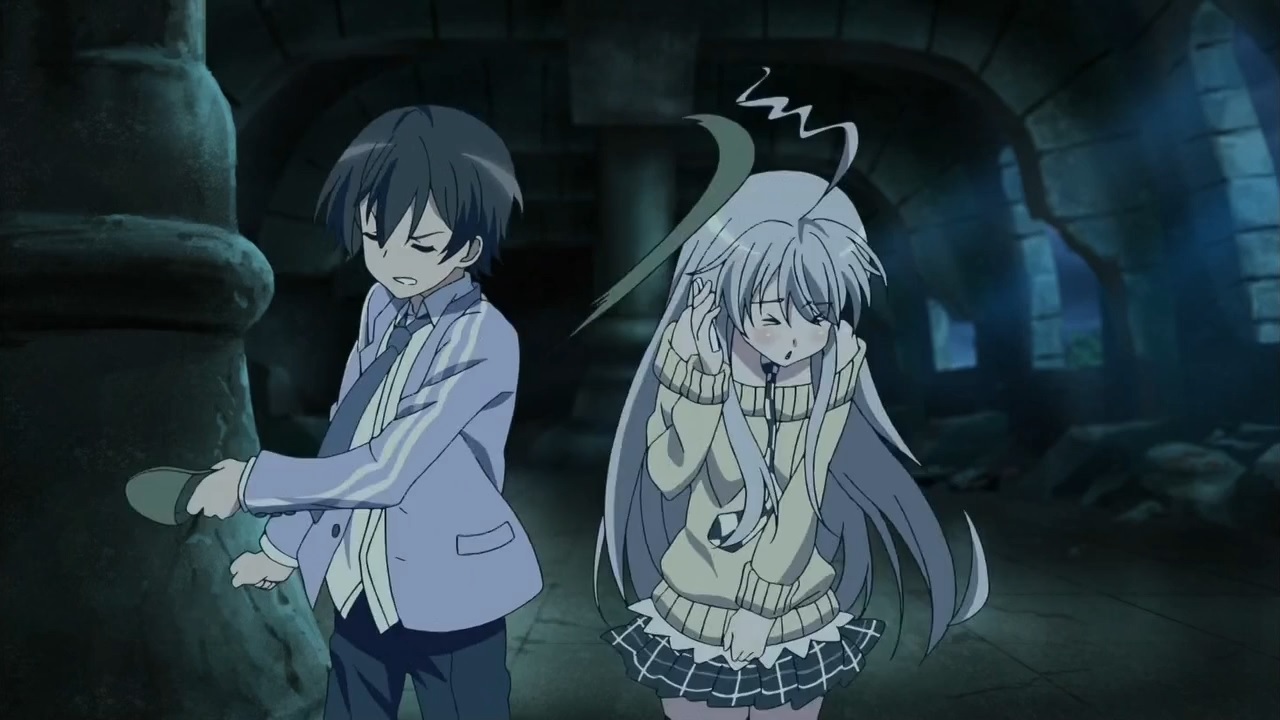
(0:48)
Mahiro hits Nyaruko with a green slipper. This appears to be referencing Narumi Akiko (鳴海亜樹子) from "Kamen Rider W" (仮面ライダーW), a Japanese TV show about a masked super hero that aired from 2009 to 2010. In the show, Akiko occasionally hits people with a green slipper.S1 Image for reference:
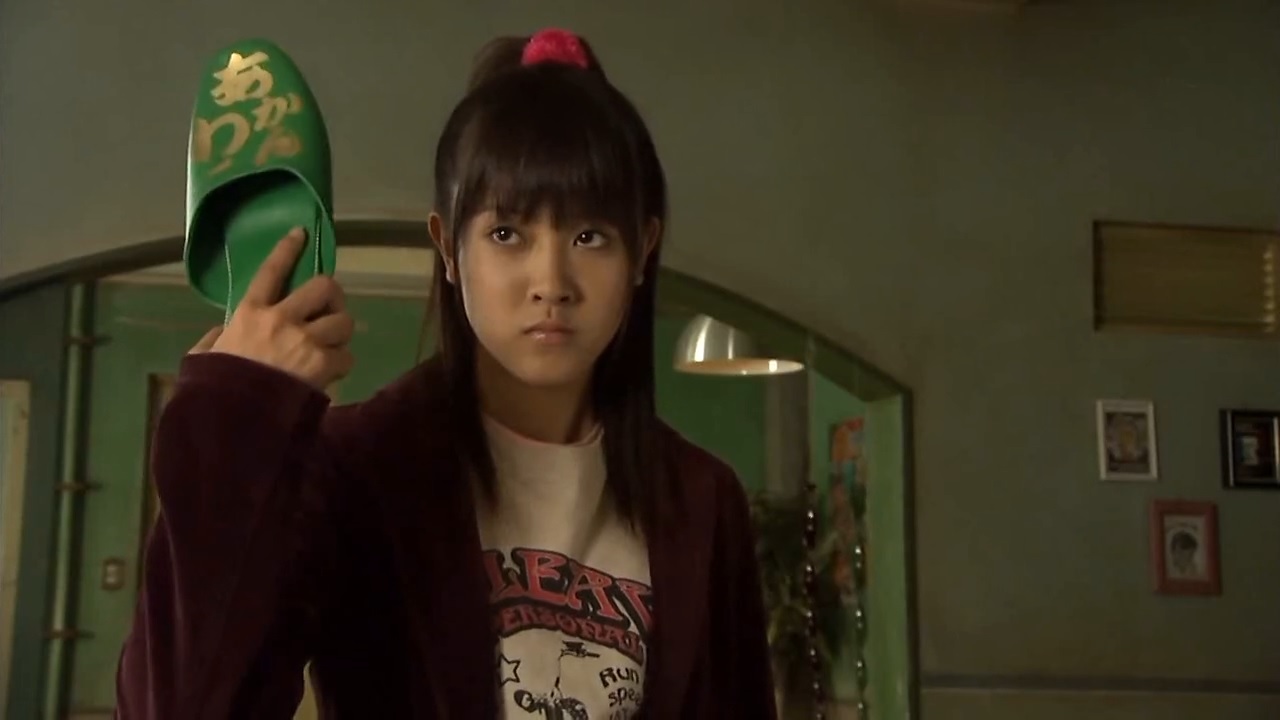
"Nekowappa!" (0:49)
"Nekowappa!" (ねこわっぱ!) is a manga series written by Matsumoto Naoya (松本直也) and published from 2009 to 2010.S1 The series was discontinued after 13 chapters of serialization and was published in 2 volumes.
"A pinch changes into a chance." (0:59)
The Japanaese line is "Pinchi ha chansu ni chenji desu yo" (ピンチはチャンスにチェンジですよ). This is referencing "Pinchi ha Chansu da, Chenjiman" (ピンチはチャンスだ、チェンジマン), "A Pinch is a Chance, Changeman", a song sung by KAGE and released in 1985. This song is a theme song used in "Dengeki Sentai Chenjiman" (電撃戦隊チェンジマン), "Lightning Squadron Changeman", a Japanese TV show about a squadron of costumed super heroes that aired from 1985 to 1986.S2

"It's not wrong to search for encounters in a dungeon!" (2:59)
The Japanese line is "Danjon ni deai wo motomeru no ha machigattemasen yo ne!" (ダンジョンに出会いを求めるのは間違ってませんよね!). This is referencing "Danjon ni Deai wo Motomeru no ha Machigatteiru Darou ka" (ダンジョンに出会いを求めるのは間違っているだろうか), "Is It Wrong to Search for Encounters in a Dungeon?", a light novel series written by Oomori Fujino (大森藤ノ) and published starting from 2013.S2
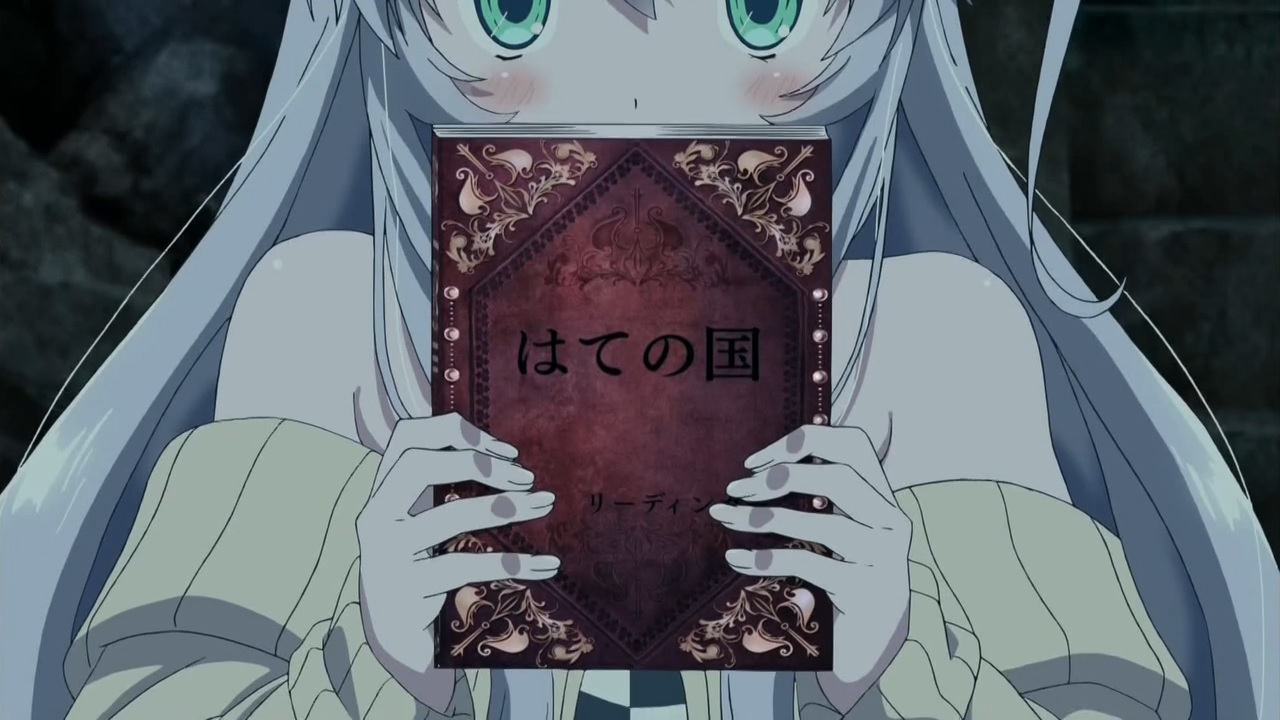
(3:07)
This book appeared in episode 2 at 3:35. The title of the book is "Hate no Kuni" (はての国), "Land of the End". The author is "A.S Riidingaa" (A.S リーディンガー), "A.S Ridinger". This is referencing a book that is mentioned in "Divi Dead" (ディヴァイデッド), a visual novel released by C's Ware in 1998. In this visual novel, one of the characters, Okui Mami (奥井まみ), is reading a book written by A.S. Ridinger (A・S・リーディンガー) in a scene during the evening of day 1 of the game. In addition, she mentions that her favorite book written by A.S. Ridinger is "Hate no Kuni" (はての国), "Land of the End". Images for reference:

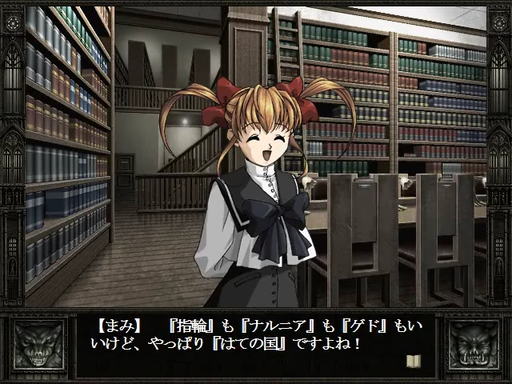
Source of images: http://www.nicovideo.jp/watch/sm12455699
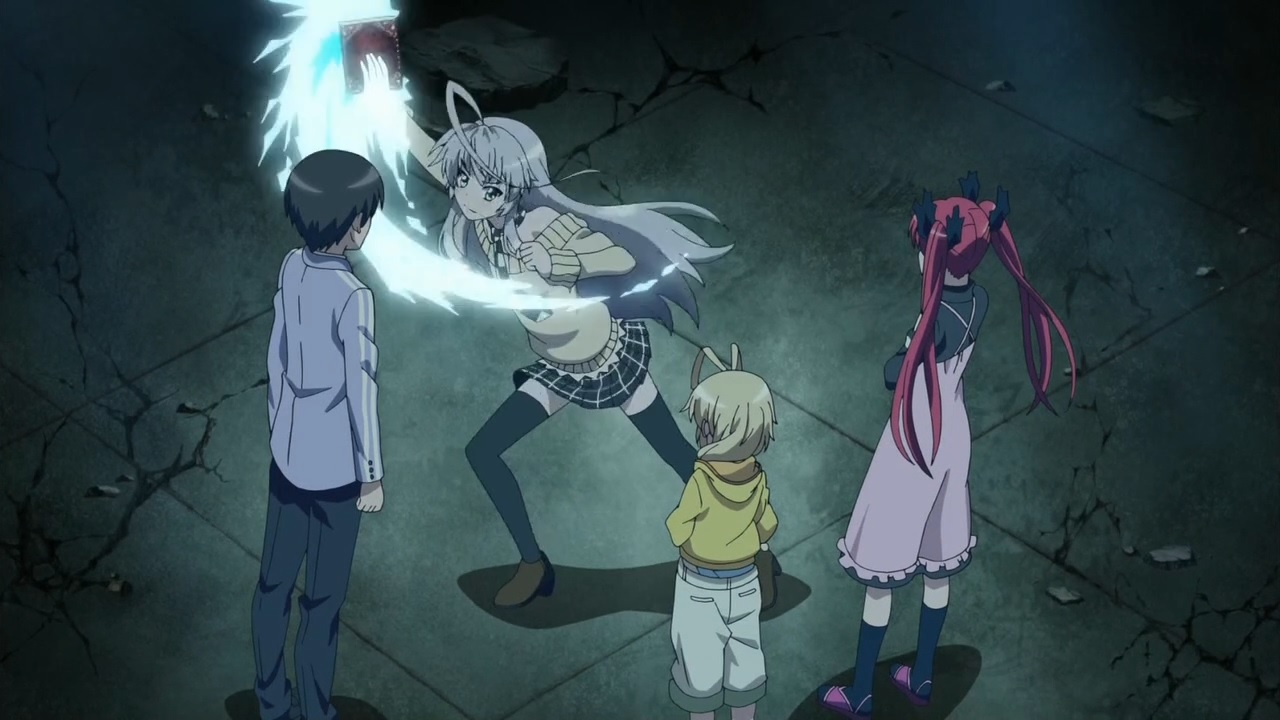
"No way! There's just no way!" (3:33)
The Japanese line is "Masaka! Metaru Masakaa!" (まさか!メタルマサカー!), which more literally translates to "No way! Metal Massacre!". This is a pun on the Japanese pronunciation of 「まさか」 (masaka), which means "impossible" or "no way", and 「マサカー」 (masakaa), which means "massacre". Nyaruko says "Metal Massacre" (メタルマサカー) and swipes her hand horizontally in front of her, producing a blue arc of light. This is referencing Mature (マチュア) from "The King of Fighters" (ザ・キング・オブ・ファイターズ), a video game series that first began release in 1994.S1 In the series, Mature has a technique called "Metal Massacre", and when she uses this technique she dashes forward and swipes her hand horizontally in front of her, producing a blue slash effect. Image for reference:
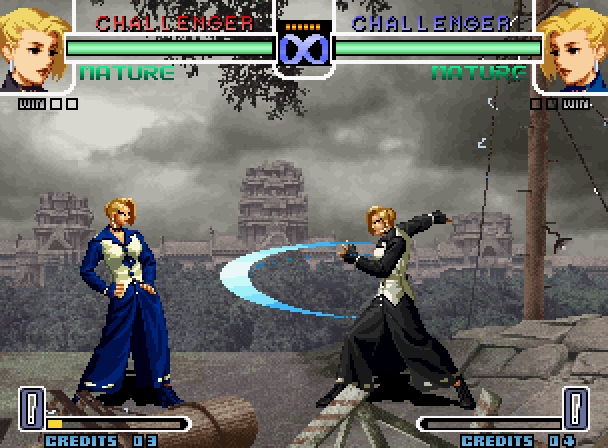
On a related note, the name "Metal Massacre" is based on "Metal Massacre", a series of compilation albums released from 1981 to 2006.
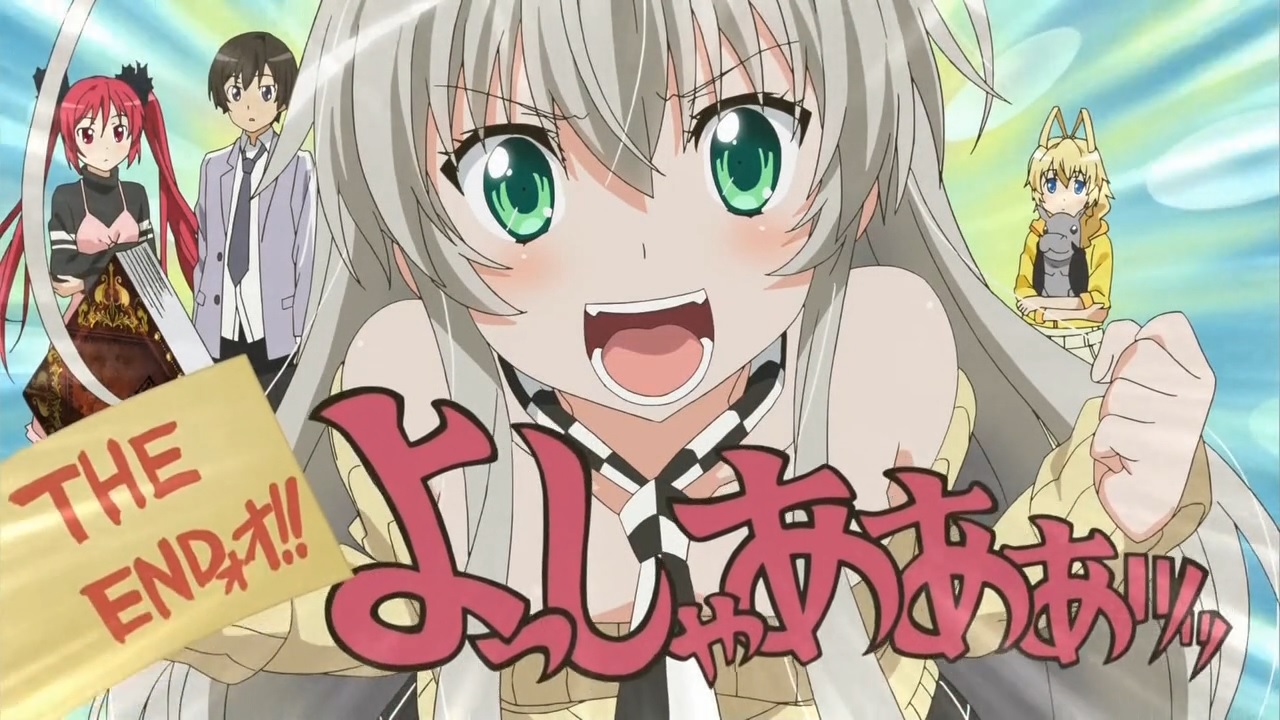
"There's no such thing as a path that cannot be cleared!" (4:09)
The Japanese line is "Kirihirakenai michi ha nai n desu yo!" (切り開けない道はないんですよ!). This is referencing "Takaya -Senbu Gakuen Gekitouden-" (タカヤ -閃武学園激闘伝-), roughly "Takaya -The Legendary Battles of the Radiant Warrior Academy-", a manga series written by Sakamoto Yuujirou (坂本裕次郎) and published from 2005 to 2006.S1 The series was serialized for 38 chapters and was published in 5 volumes. After the first 38 chapters, the series changed its title to "Takaya -Yoake no Enjin Ou" (タカヤ -夜明けの炎刃王-), roughly "Takaya -The Blazing Blade King of the Dawn-". It was discontinued after 12 chapters of serialization and was published in 1 volume. On the last two pages of "Takaya", the following text is written, "Kirihirakenai michi ha nai n da!" (斬り拓けない道はないんだッ!), which has the same meaning as above. In addition, in the above scene Nyaruko shouts "Yosshaaaa!" (よっしゃあああッッ), a shout of enthusiasm, and the lines 「よっしゃあああッッ」 and 「THE ENDォオ!!」 are written. This is referencing the same lines written on the last two pages of "Takaya". Image for reference:
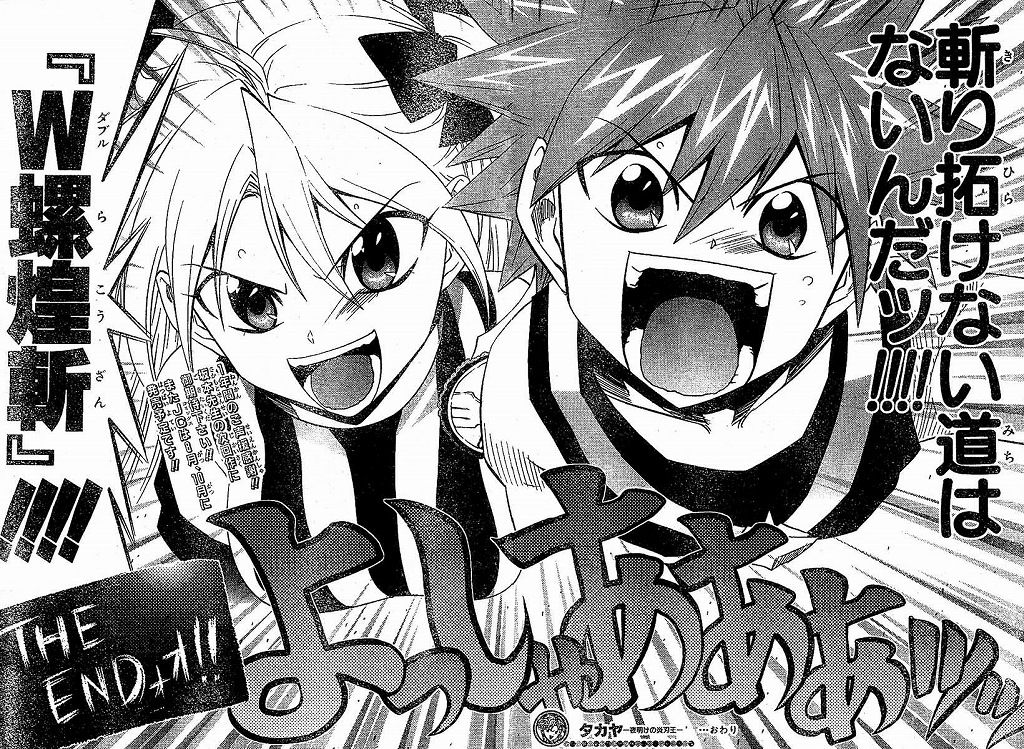
Source of image: http://www.nijisoku.com/archives/11243861.html
On the last page, the protagonists also shout "Daburu Rakouzan!" (『W螺煌斬』!), which roughly translates to "Double Spiral Flash Attack!". The "W" being used to mean "double" is possibly related to the "W" in "Haiyore! Nyaruko-san W", which is used to mean "double" and indicates that it is the second season.
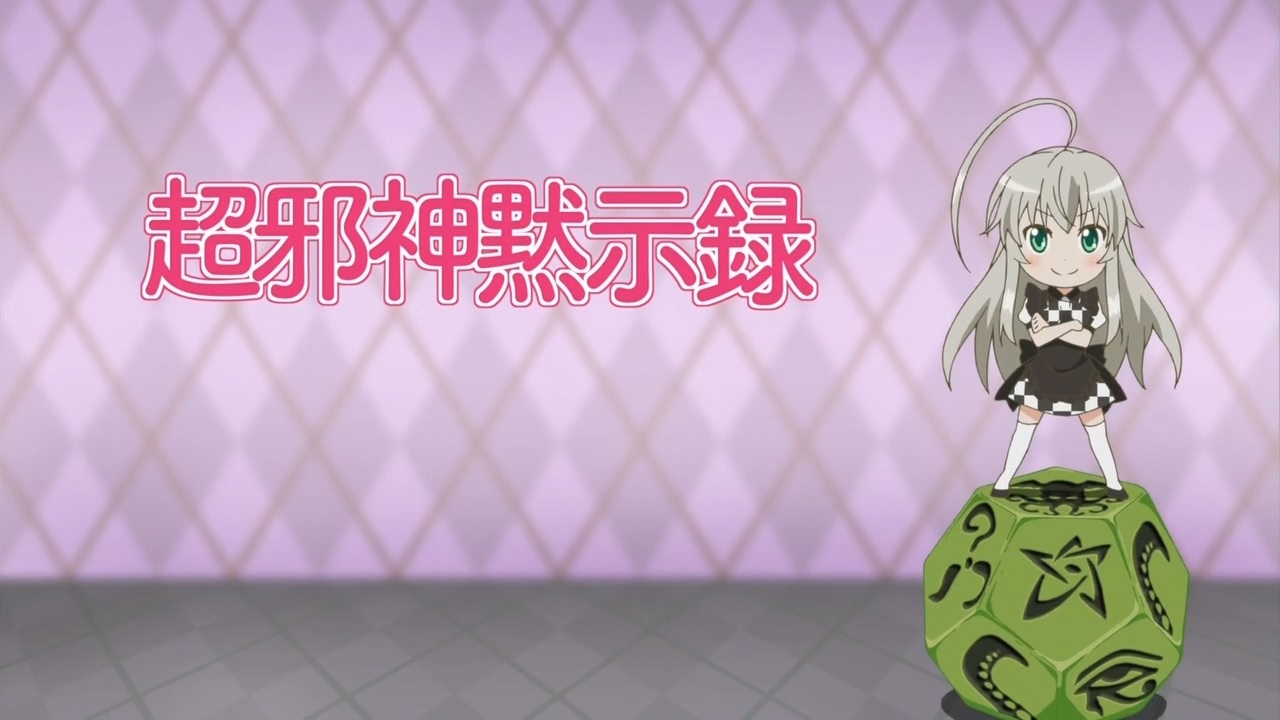
(4:16)
The title of this episode is "Chou Jashin Mokushiroku" (超邪神黙示録), which translates to "Super Evil God Apocalypse". This is referencing "Yuusha Ou Gao Gai Gaa FINAL" (勇者王ガオガイガーFINAL), "The King of Braves GaoGaiGar Final", an anime series that was released from 2000 to 2003.S1 The title of episode 7 of this series is "Chou Yuusha Mokushiroku" (超勇者黙示録), which translates to "Super Brave Apocalypse".

(4:22 - 5:02)
There are two references here:
* This is the white creature that appears on Maaruko's head.

This is referencing the Twitter profile picture of Aisora Manta (逢空万太), the author of the "Haiyore! Nyaruko-san" light novel series. Screen capture for reference:

* This entire scene is referencing episode 32 of "Dragon Quest" (ドラゴンクエスト), an anime series that aired from 1989 to 1990.S2 Specifically, this is referencing the version of episode 32 that aired in 1990 during the first airing of the series. At the time, this episode was the last episode in the series and the series ended early without fully concluding. Near the end of the episode, there is a scene in which it is revealed that the events of the series are being told as a story by an old woman to two children. She summarizes the events of the series yet to be depicted and the conclusion of the series, and says that aside from the main hero and heroine, all of the protagonists died in battle against the main antagonist. It is implied that the woman is the main heroine, Tiala (ティアラ). Images for reference:

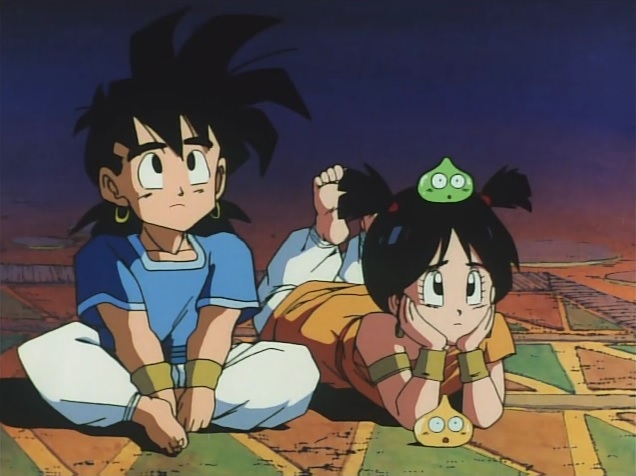
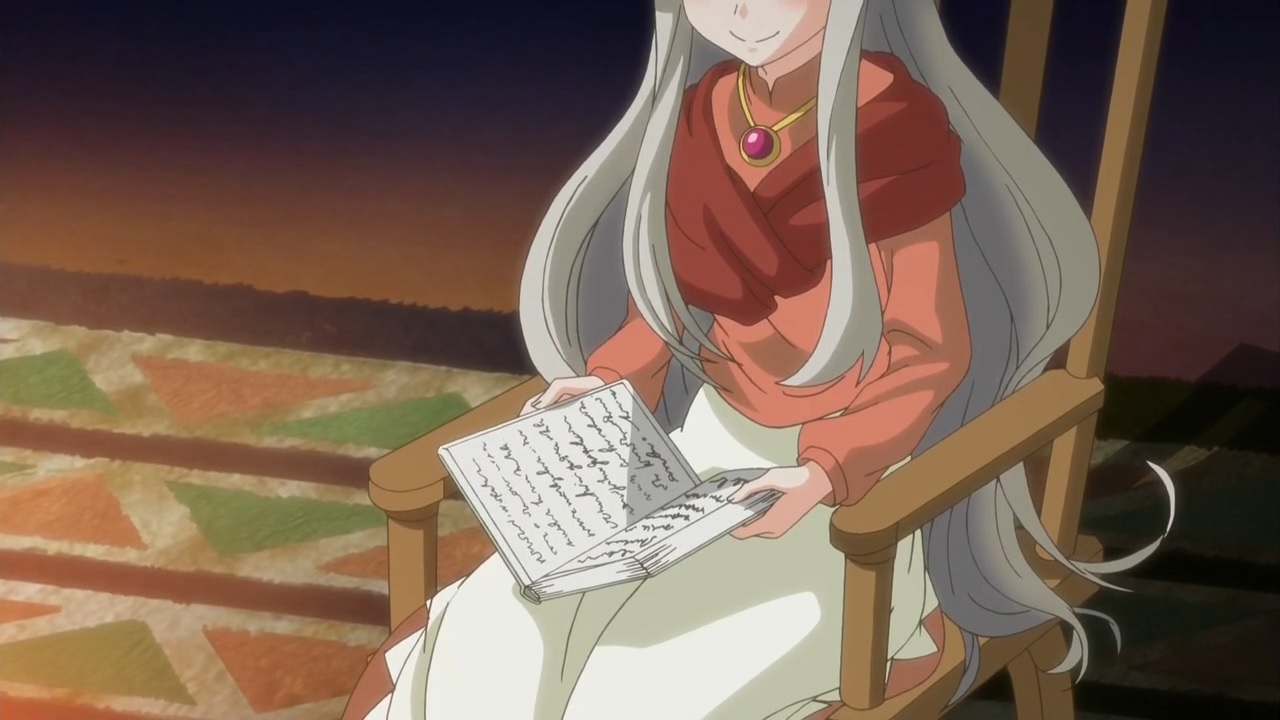
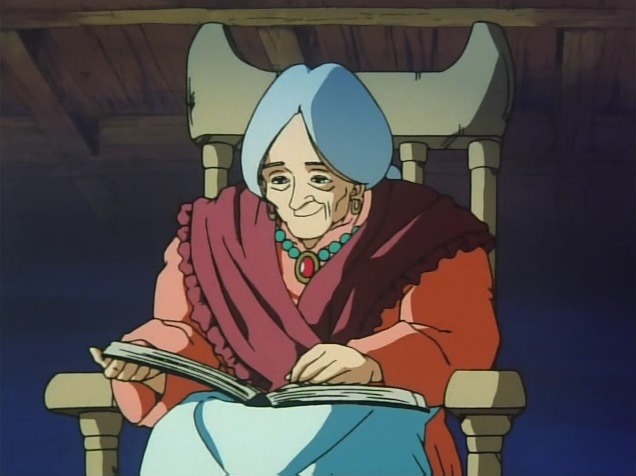
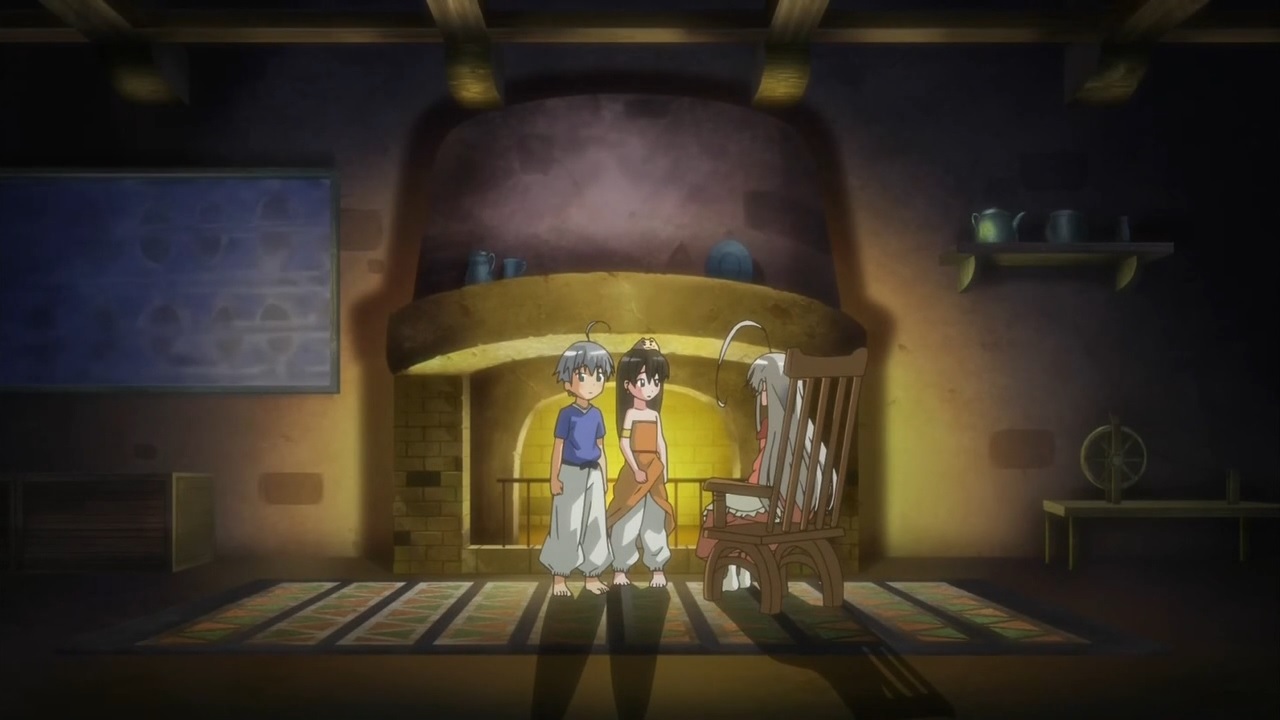

On a side note, several months after its initial conclusion, the series was resumed in 1991 and concluded later that year. The continuity was revised such that the ending scene with the story teller in episode 32 did not occur, the series continued from where the story left off before the ending scene, and the series reached a different conclusion. The series was released on DVD in 2006 with the title "Doragon Kuesuto 《Yuusha Aberu Densetsu》" (ドラゴンクエスト 《勇者アベル伝説》), "Dragon Quest 《Legend of the Hero Abel》". In this DVD release, parts of the original episode 32 and original episode 33 were combined to create a new episode 32, and the original episode 32 and original episode 33 were removed from the official continuity.
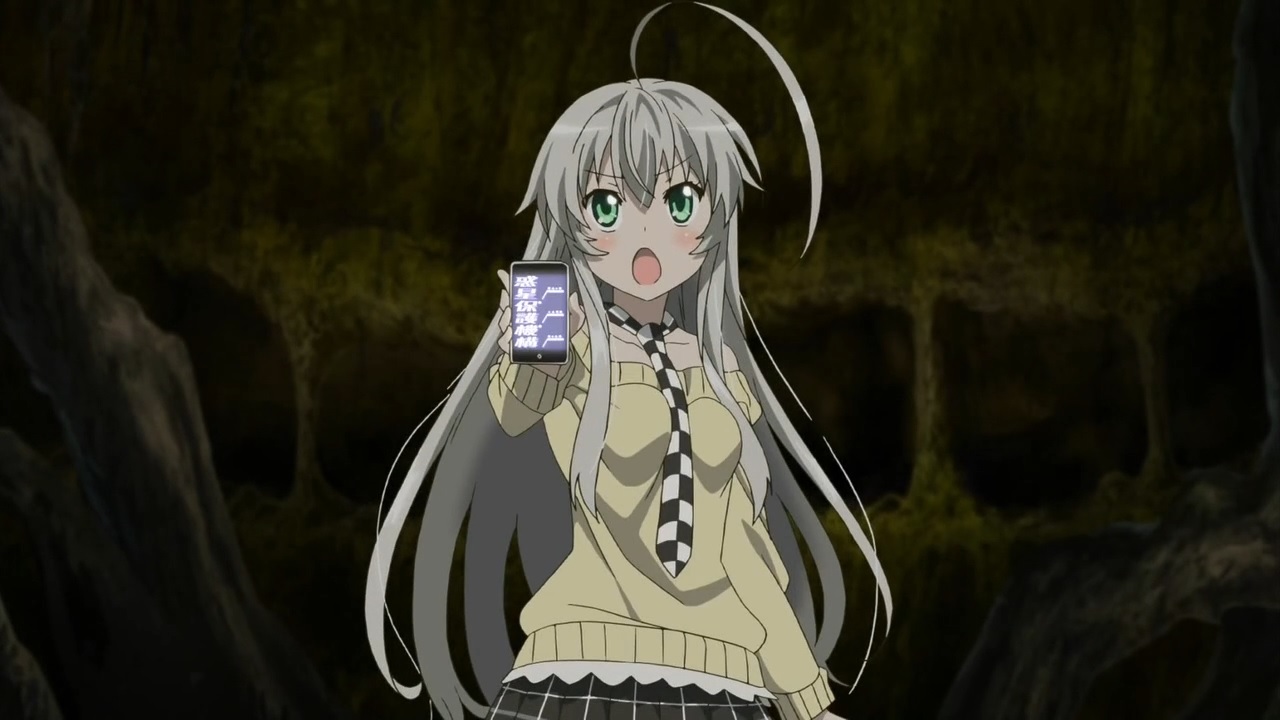
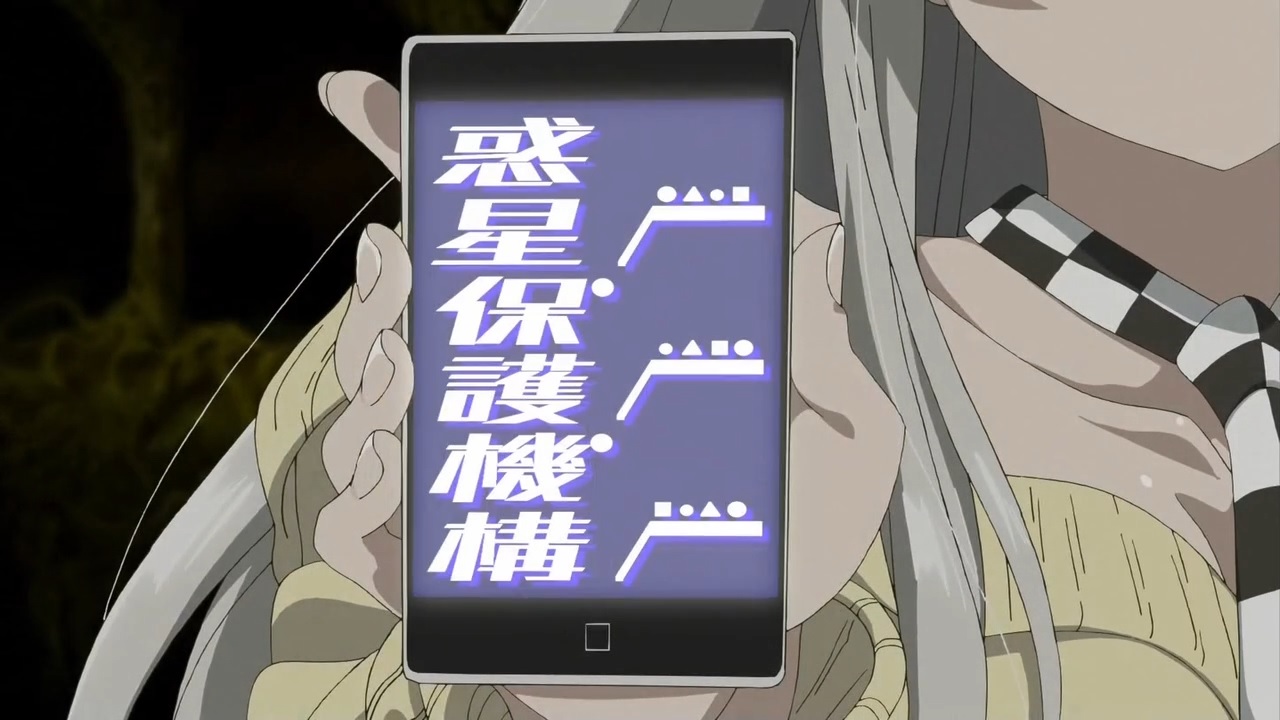
(5:27 - 5:39)
This scene is referencing "Tokusou Sentai Dekarenjaa" (特捜戦隊デカレンジャー), "Special Police Squadron Dekaranger", a Japanese TV show about a squadron of costumed super heroes that aired from 2004 to 2005.
* The appearance of Nyaruko's phone is referencing the SP License (SPライセンス), a device that each Dekaranger possesses. Image for reference:
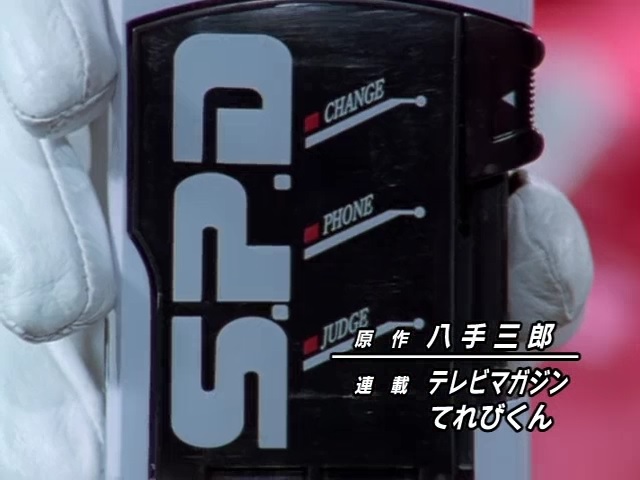
* Nyaruko lists out the crimes committed by Zhar and Lloigor, and then holds up her phone and shouts "Jajjimento desu yo!" (ジャッジメントですよ!), "Judgement!". When the Dekarangers have cornered a criminal, one of the Dekarangers will list out the crimes that the criminal has committed, and then hold up his or her SP License and shout "Jajjimento!" (ジャッジメント!), "Judgement!". Image for reference:
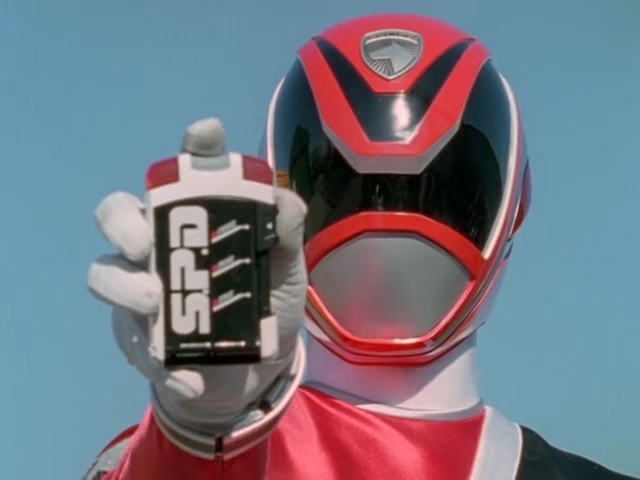
* A siren can be heard when Nyaruko's phone flashes. When the Dekarangers transform into their costumes a siren can be heard.
"Judgement!" (5:37)
The Japanese line is "Jajjimento desu yo!" (ジャッジメントですよ!). This appears to be referencing Shirai Kuroko (白井黒子) from "To Aru Majutsu no Indekkusu" (とある魔術の禁書目録), "A Certain Magical Index", a light novel series written by Kamachi Kazuma (鎌池和馬) and published starting from 2004. The manner in which Nyaruko says her line is similar to the manner in which Kuroko says "Jajjimento desu no!" (ジャッジメントですの!), "Judgement!", in the anime adaptation of the series that aired from 2008 to 2009.
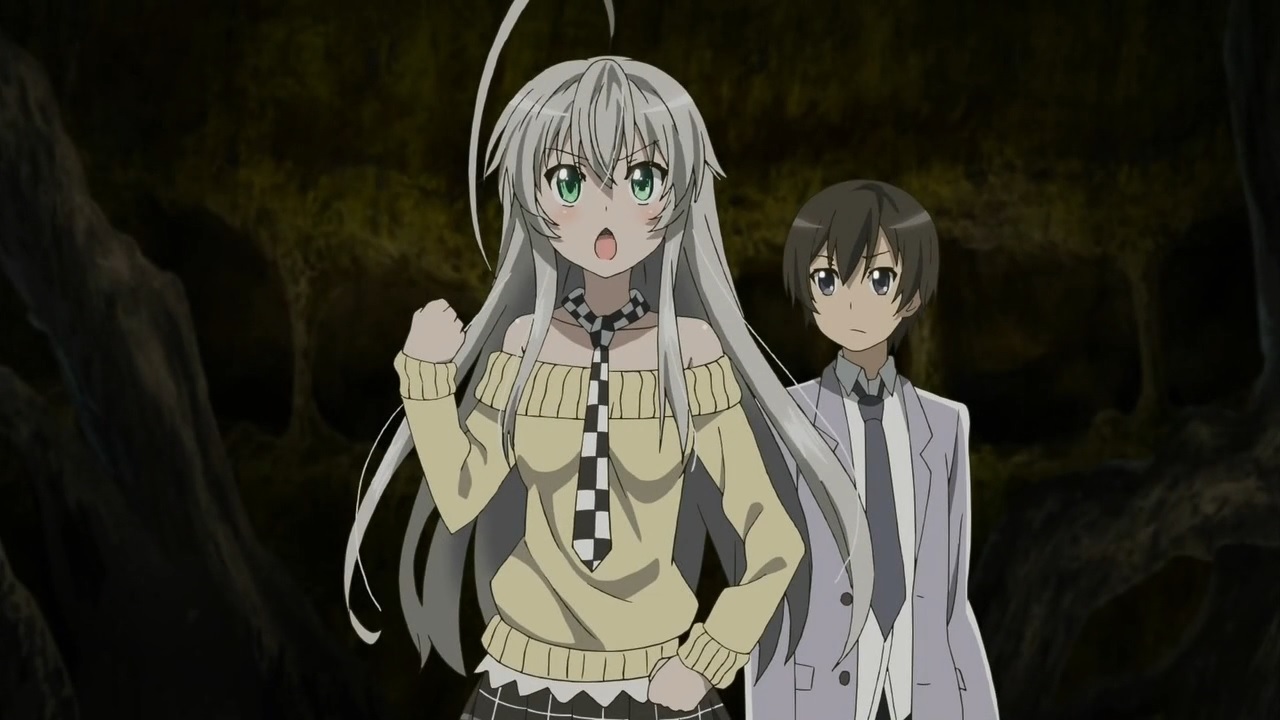
"Protecting the Earth is the duty of the Planetary Defense Organization!" (5:51)
The Japanese line is "Chikyuu wo mamoru ha Wakusei Hogo Kikou no shimei!" (地球を守るは惑星保護機構の使命!). This is referencing a line from "Tensou Sentai Goseiger" (天装戦隊ゴセイジャー), "Heavenly Clad Squadron Goseiger", a Japanese TV show about a squadron of costumed super heroes that aired from 2010 to 2011.S1 A catch phrase said by the squadron goes, "Hoshi wo mamoru ha tenshi no shimei!" (地球を護るは天使の使命!), which translates to "Protecting the Earth is the duty of the Angels!". In addition, Nyaruko's poses are referencing the poses done by the Goseigers when they say this catch phrase.S1 Images for reference:
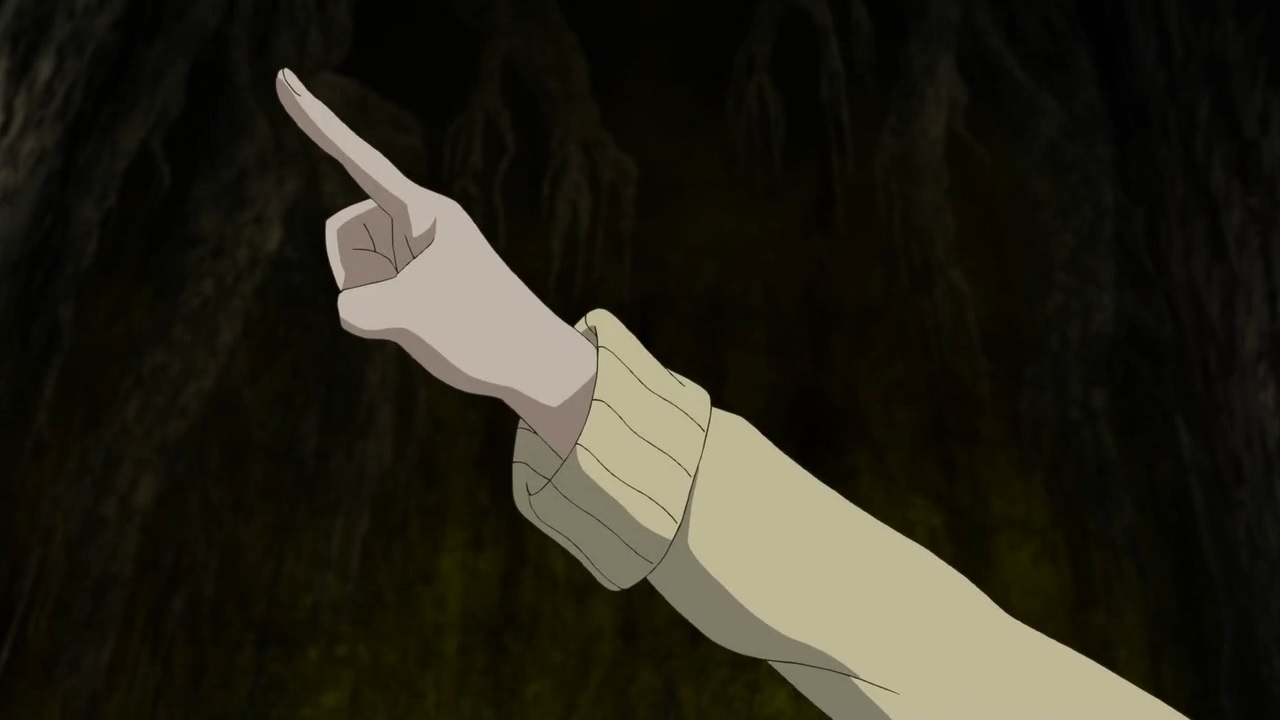
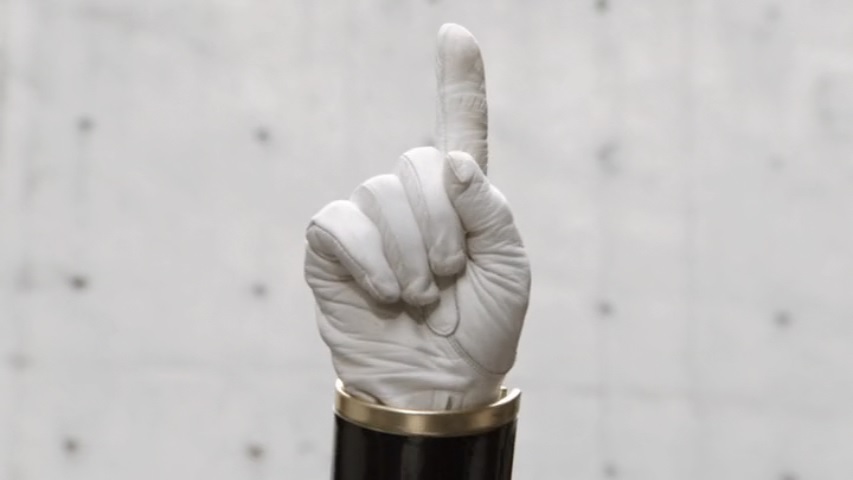
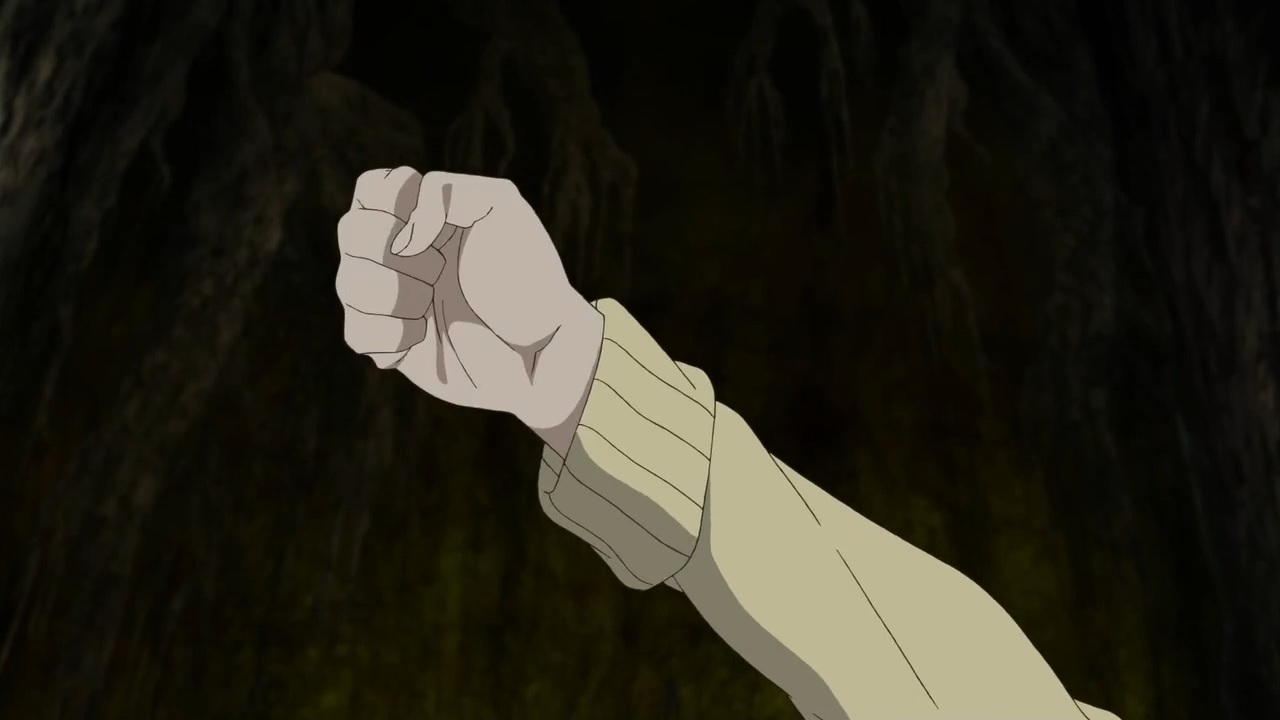
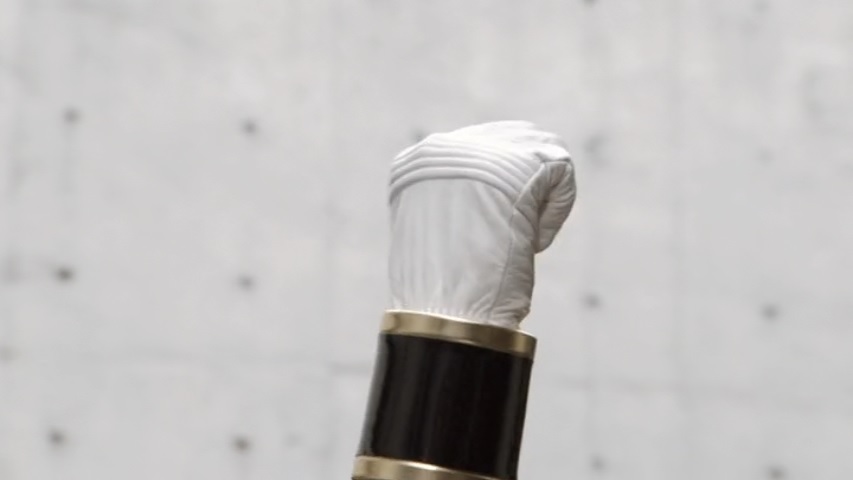

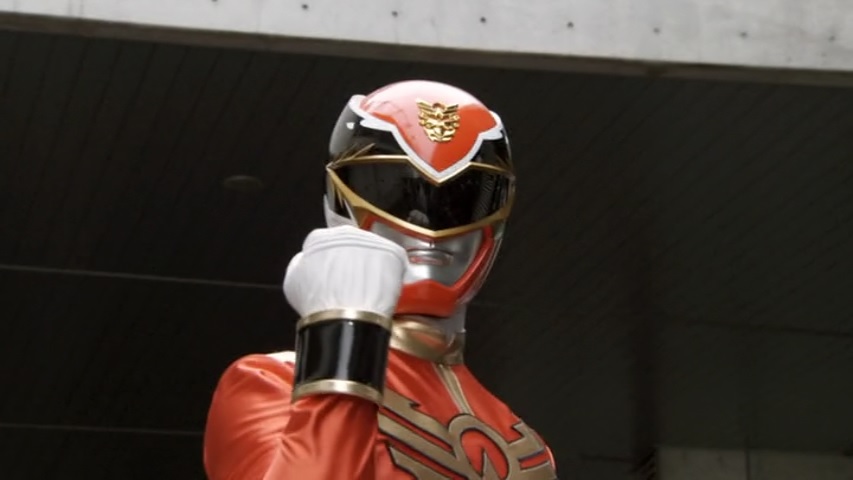
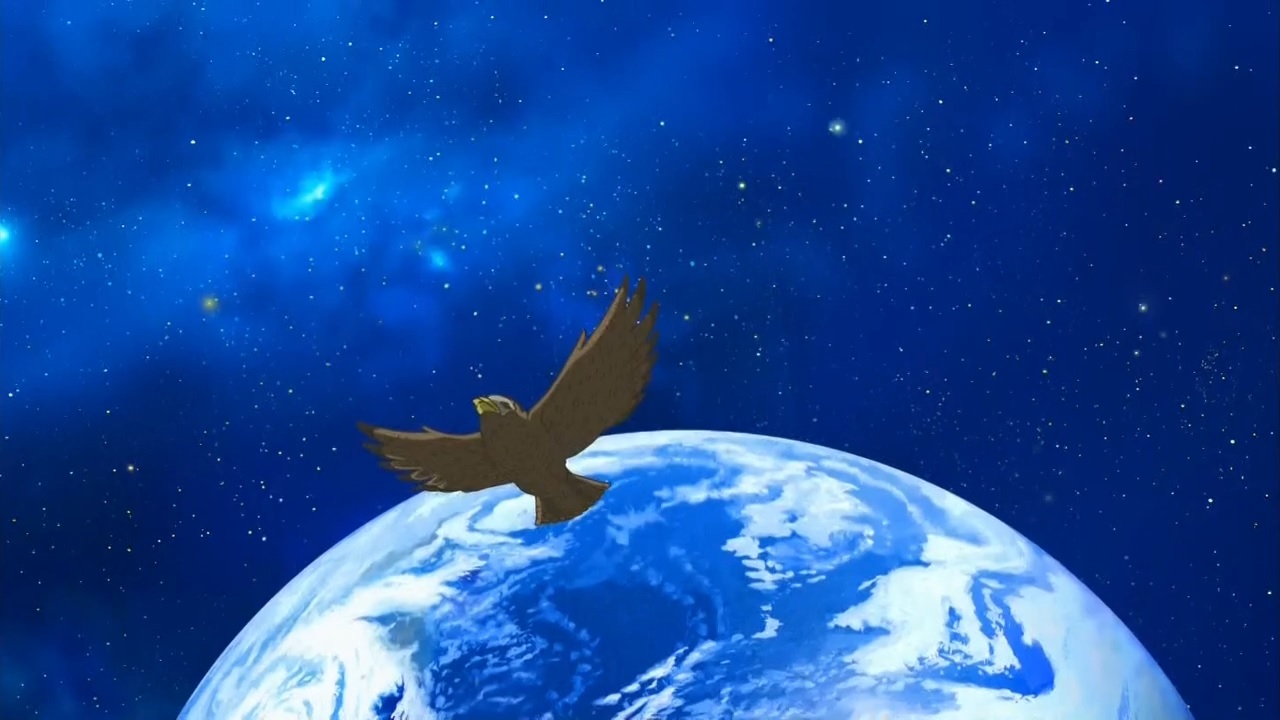
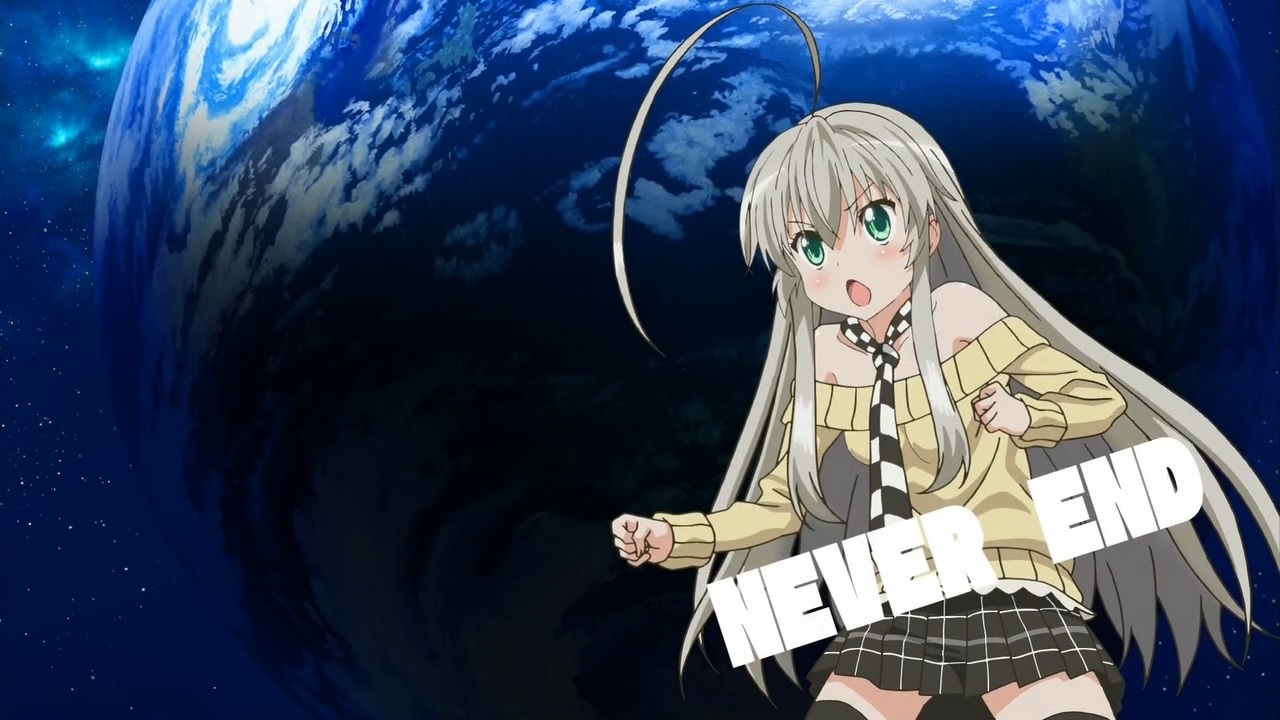
"From now on, even if I'm all alone I will fight to the bitter end!" (5:59)
"Never end!" (6:04)
The Japanese line is "Kono saki, tatoe tatta hitori demo tatakai nuite misemasu!" (この先、たとえたった一人でも戦い抜いてみせます!). This is referencing a line said by Shou (翔) in "SILENT KNIGHT SHOU" (サイレントナイト翔), a manga series written by Kurumada Masami (車田正美) and published from 1992 to 1993. The series was discontinued after 13 chapters of serialization and was published in 2 volumes. Shou's line goes, "Kono saki tatoe tatta hitori demo tatakai nuite yaru sa!!" (この先 たとえたった一人でも戦い抜いてやるさ!!), which has the same meaning as above. Image for reference:
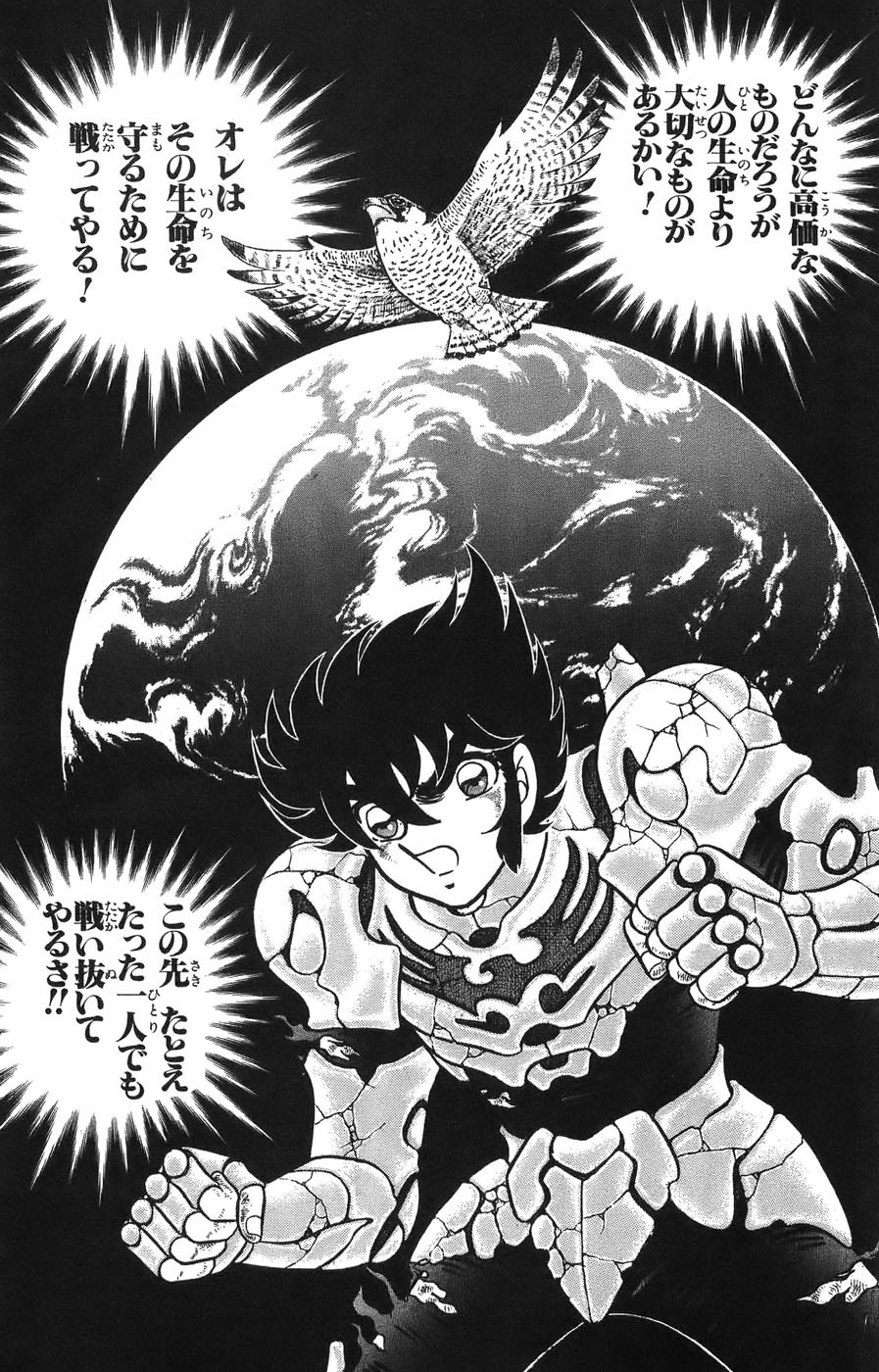
As it can be seen in the above image, the falcon that appears when Nyaruko says her line is referencing the falcon that appears when Shou says his line. The Earth appearing in the background is also referencing the scene with Shou. In addition, Nyaruko is making the same pose as Shou.S2
"NEVER END" is referencing the last two pages of volume 2 of "SILENT KNIGHT SHOU".S1 Image for reference:
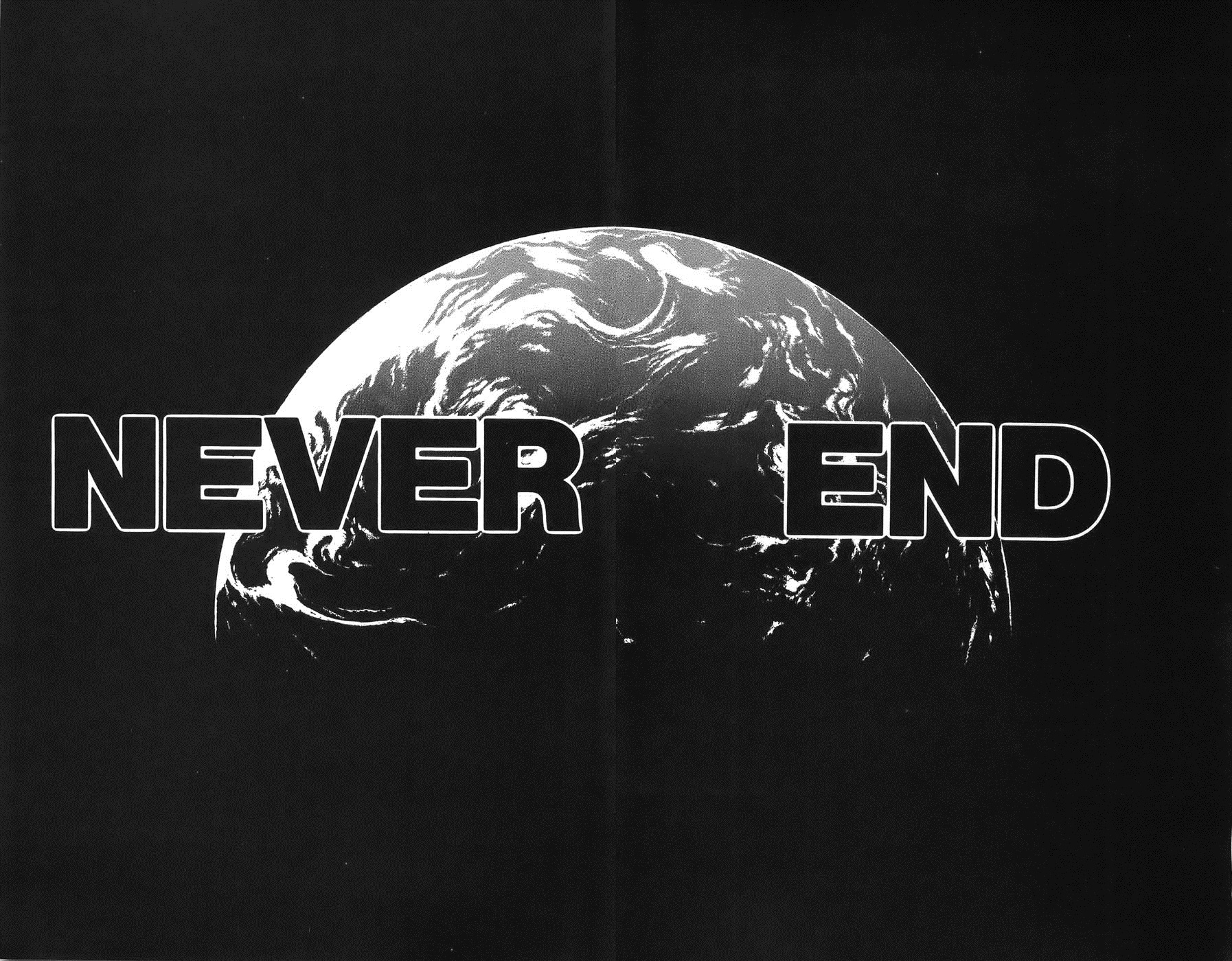
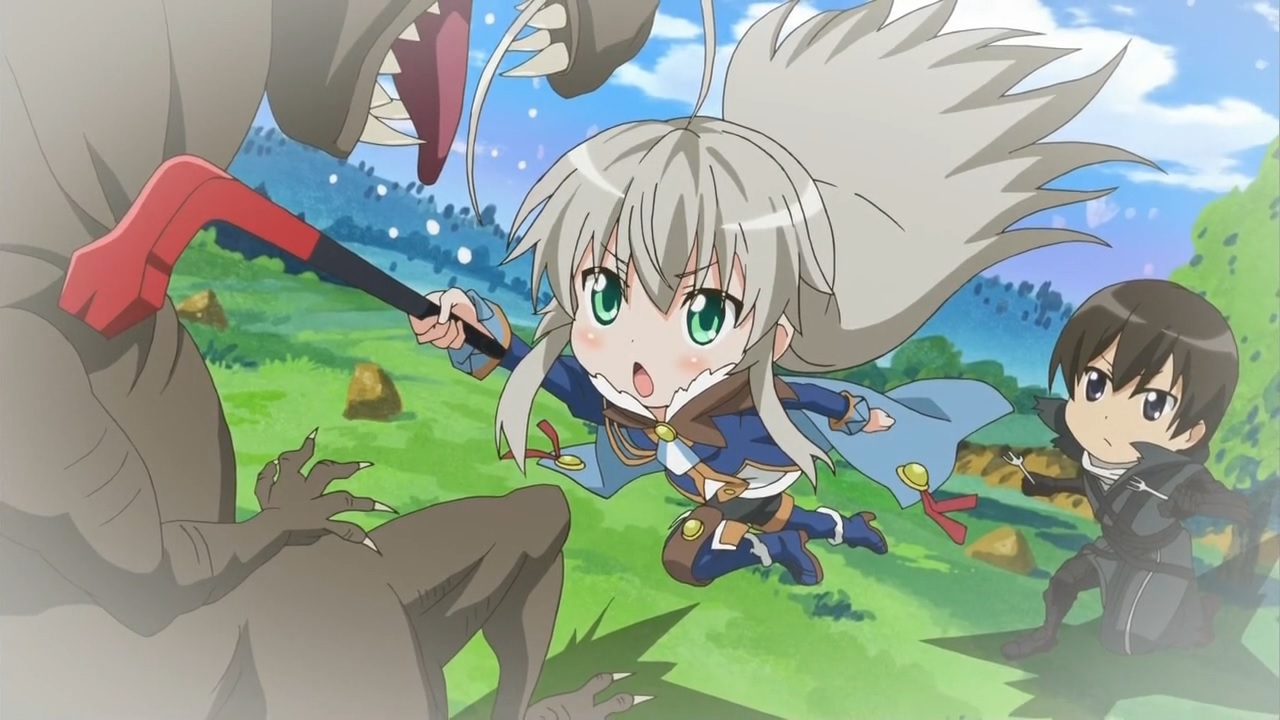
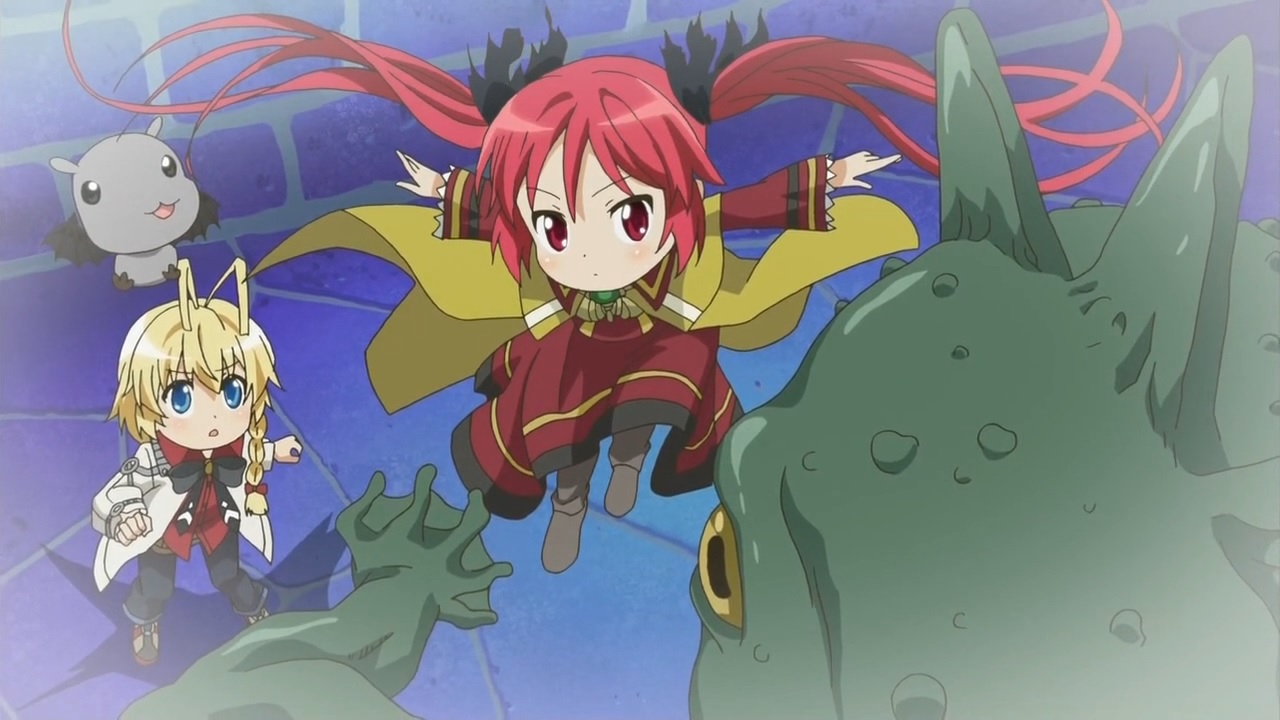
(6:06 - 6:20)
The clothes that Nyaruko and company are wearing in these scenes are referencing the clothes worn by the main characters in "WILD ARMS XF" (ワイルドアームズ クロスファイア), a game released by Media.Vision (メディア・ビジョン) in 2007.S1 Nyaruko and Mahiro's clothes:

Nyaruko's clothes are referencing Klarissa Avir (クラリッサ・アウィル). Mahiro's clothes are referencing Firs Avir (フィアース・アウィル). Images for reference:

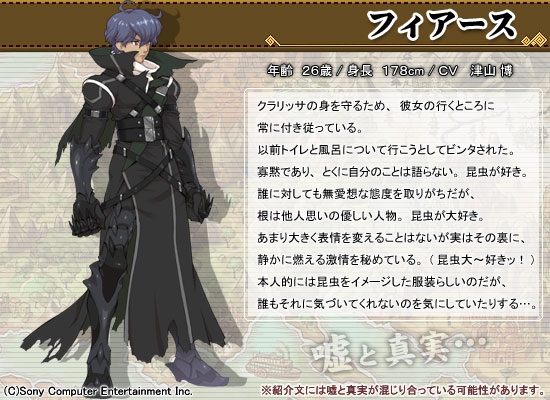
Hasta and Cthuko's clothes:

Hasta's clothes are referencing Revin Brenten (レヴィン・ブレンテン). Cthuko's clothes are referencing Labryna Wordsworth (ラブライナ・ワーズワース). Images for reference:
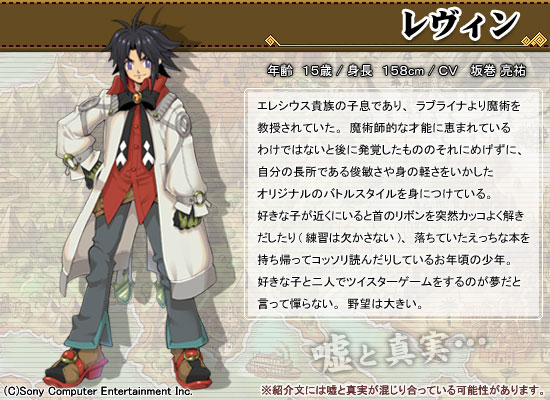
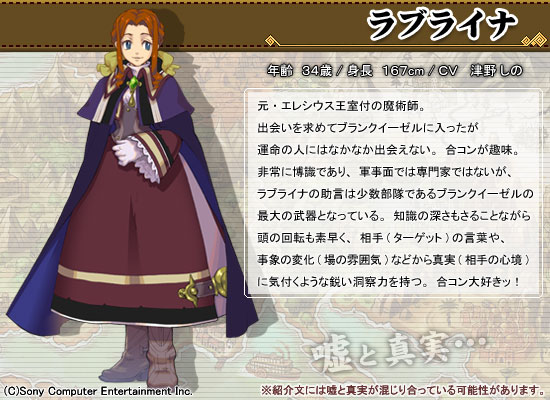
Source of images: http://www.media-vision.co.jp/soft/waxf/character/
"All right, starting next week, 'Crawl! Nyaruko -The Evil God King of the Late Night-'" (6:10)
"Haiyore! Nyaruko-san -Yofuke no Jashin Ou-" (這いよれ!ニャル子さん -夜更けの邪神王-), "Crawl! Nyaruko -The Evil God King of the Late Night-", is referencing "Takaya -Yoake no Enjin Ou-" (タカヤ -夜明けの炎刃王-), roughly "Takaya -The Blazing Blade King of the Dawn-", a manga series written by Sakamoto Yuujirou (坂本裕次郎) and published in 2006.S2
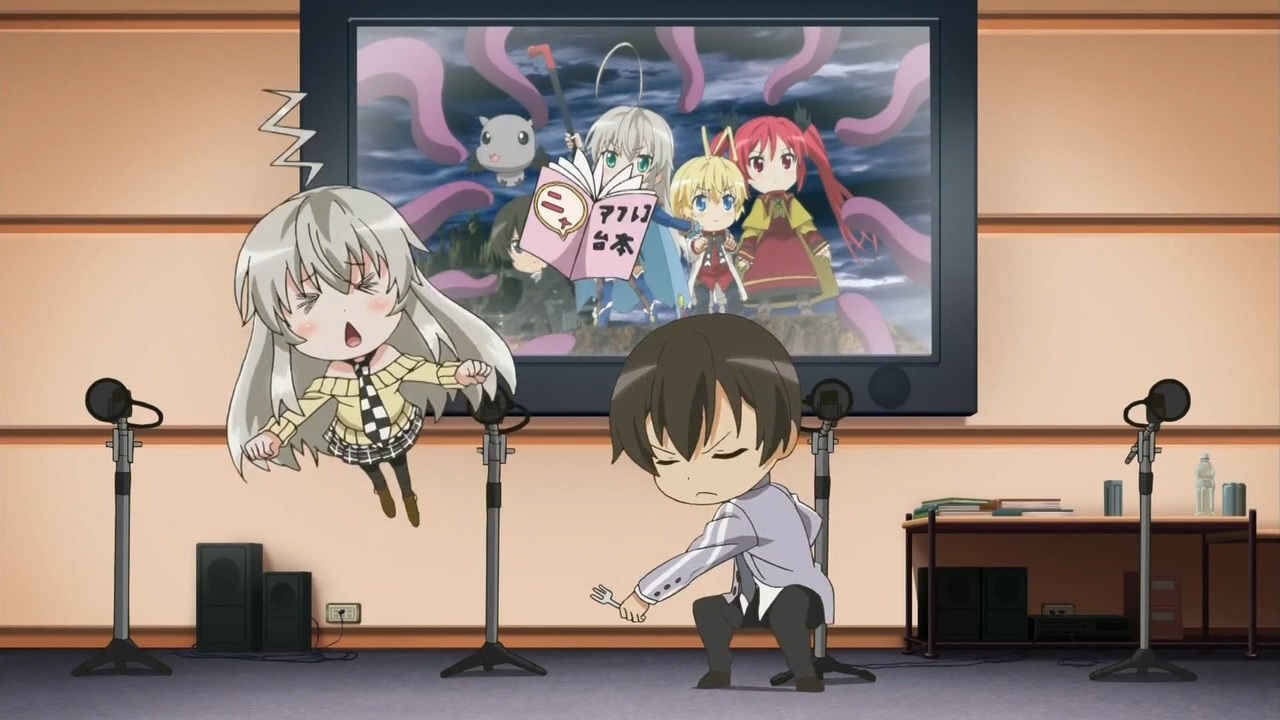
"Barion!" (6:23)
"Barion" (バリオン) is referencing "Mashinryuu Barion" (魔神竜バリオン), "Devil Dragon Barion", a manga series written by Kuroiwa Yoshihiro (黒岩よしひろ) and published in 1987.S2 The series was discontinued after 11 chapters of serialization and was published in 1 volume.
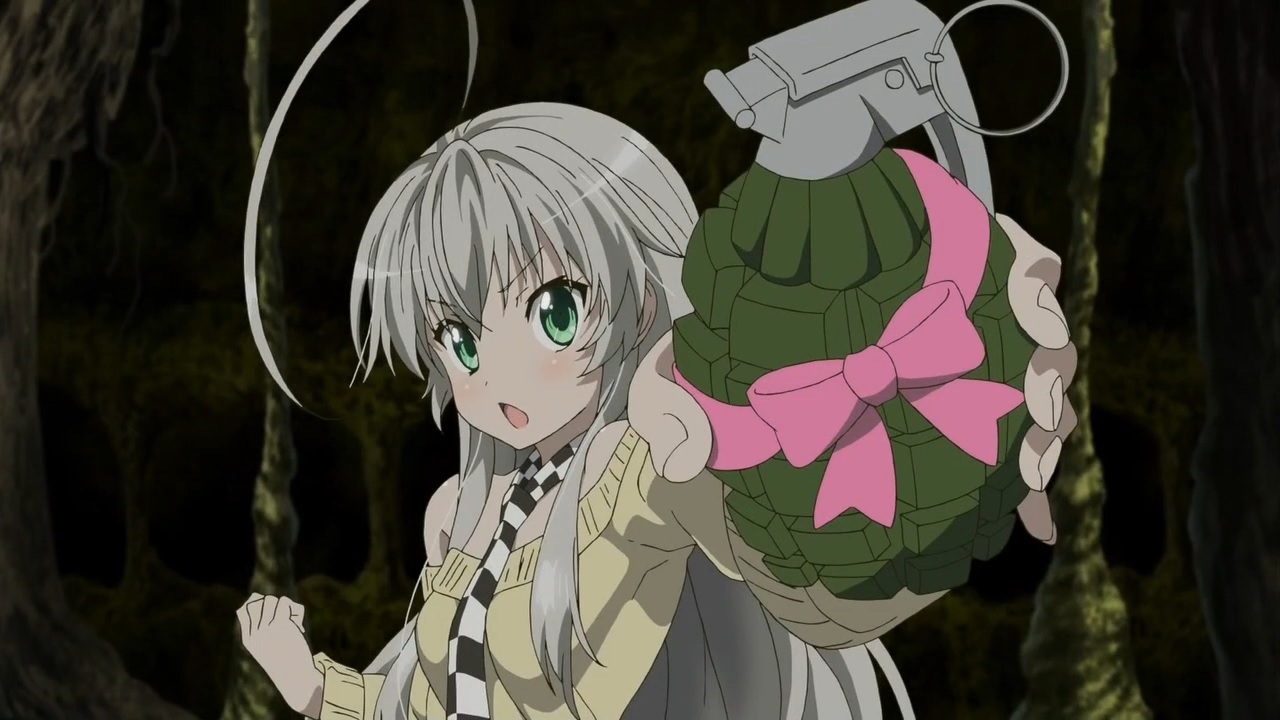
"Blasphemous Hand Grenade!" (6:32)
There are two references here:
* "Boutoku teki na" (冒瀆的な), "blasphemous", is a term that is frequently used in the Cthulhu Mythos.
* This is referencing the Holy Hand Grenade of Antioch from "Monty Python and the Holy Grail", a British movie released in 1975. This is made clear on pages 155 and 156 in volume 1 of the "Haiyore! Nyaruko-san" light novel series. The original lines go as follows:
「今の、何だ」
「『冒瀆的な手榴弾』ですが」
「お前、名状しがたい~とか冒瀆的な~とか枕につけば何でもクトゥルー神話みたいに考えてないか」
「何を言っていますか真尋さん。手榴弾は由緒正しい武器なんですよ。ほら、かのアーサー王もアンティオキアで授かった聖なる手榴弾で魔物を征伐したでしょう」
「モンティ・パイソンかお前は」
"What was that just now?"
"A 'Blasphemous Hand Grenade.'"
"Are you thinking you can make anything seem Cthulhu Mythos like just by putting stuff like unspeakable or blasphemous in front of it?"
"What are you saying, Mahiro? The hand grenade is a weapon with a long and honorable history. For instance, the renowned King Arthur defeated a monster with a holy hand grenade he received at Antioch."
"Who do you think you are, Monty Python?"
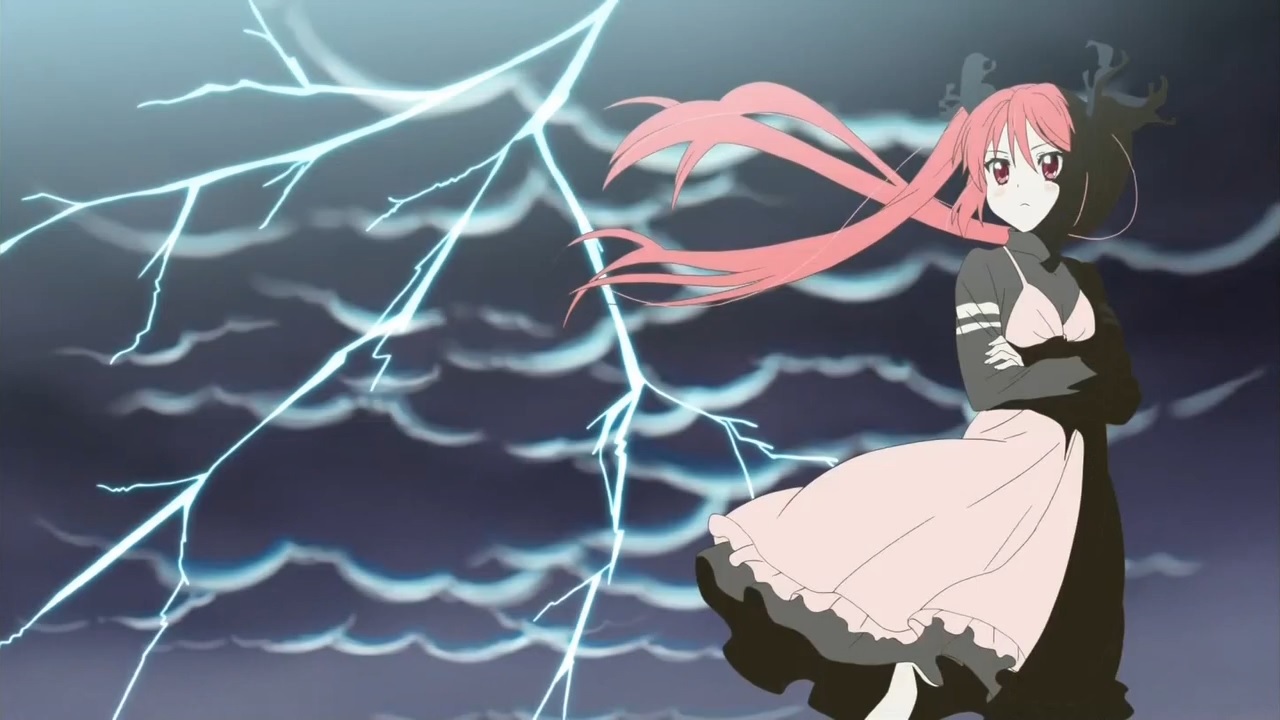
"My burning red hot heart will become lightning and defeat you." (6:36)
There are two references here:
* The Japanese line is "Watashi no makka ni moeteru atsui haato ga ikazuchi ni natte, anata tachi wo taosu" (私の真っ赤に燃えてる熱いハートが雷になって、あなたたちを倒す). This is referencing a line in the lyrics to "Honoo no Goo Faito" (炎のゴー・ファイト), "Fiery Manly Fight", a song sung by Tokugaki Tomoko (徳垣友子) and released in 1991.S2 This song is the opening theme song to "Honoo no Toukyuuji Dojji Danpei" (炎の闘球児 ドッジ弾平), "Fiery Dodgeball Boy Dodge Danpei", an anime series that aired from 1991 to 1992. The original line goes, "Makka ni moeteru atsui haato inazuma ni natte kimi wo taosu yo" (まっ赤に燃えてる熱いハート稲妻になって君を倒すよ), which has the same meaning as above.
* The image of Cthuko posing with lightning in the background is referencing a scene in the opening animation sequence of the above mentioned series.S2 Image for reference:
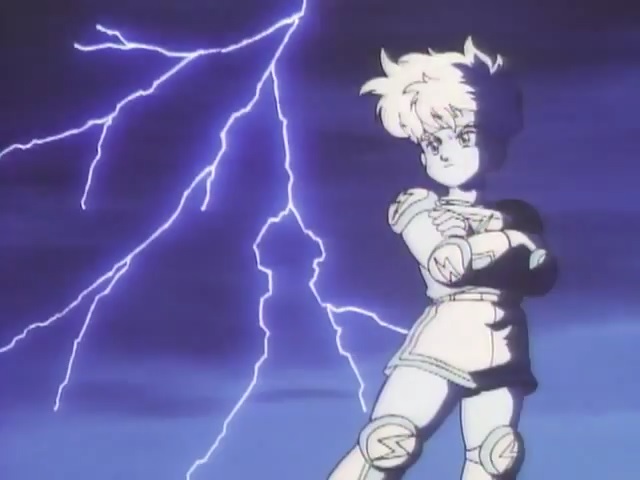
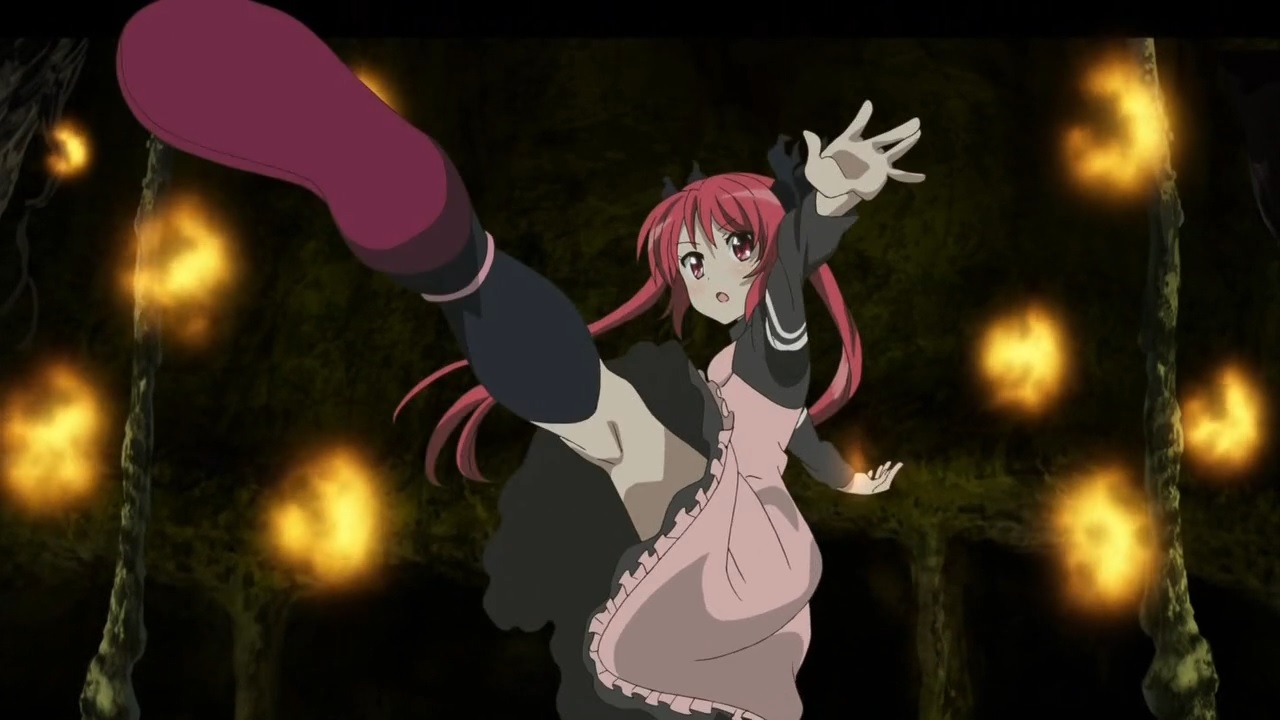
(6:45)
Cthuko's throwing animation is referencing that of Ichigeki Danpei (一撃弾平) in the opening animation sequence of "Honoo no Toukyuuji Dojji Danpei" (炎の闘球児 ドッジ弾平), "Fiery Dodgeball Boy Dodge Danpei".S1 Images for reference:


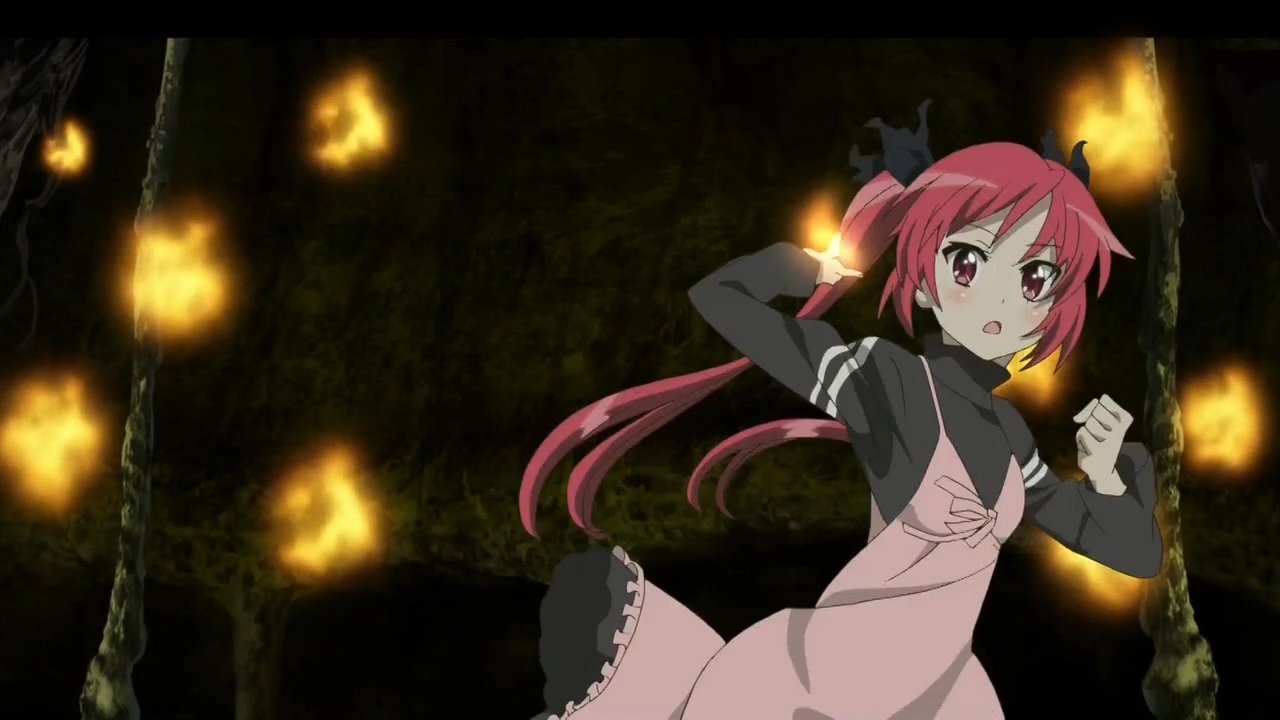
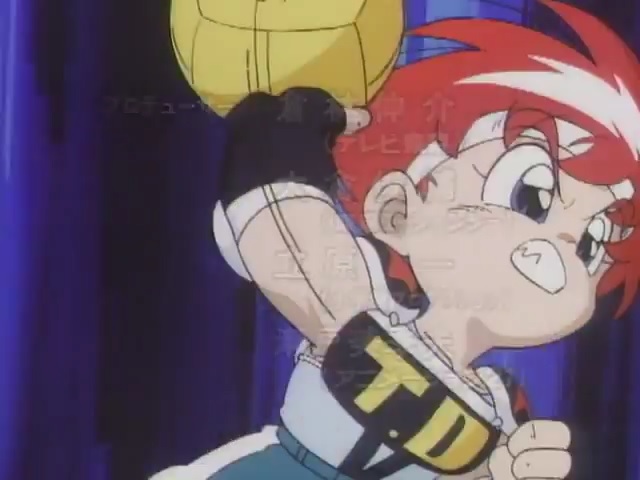
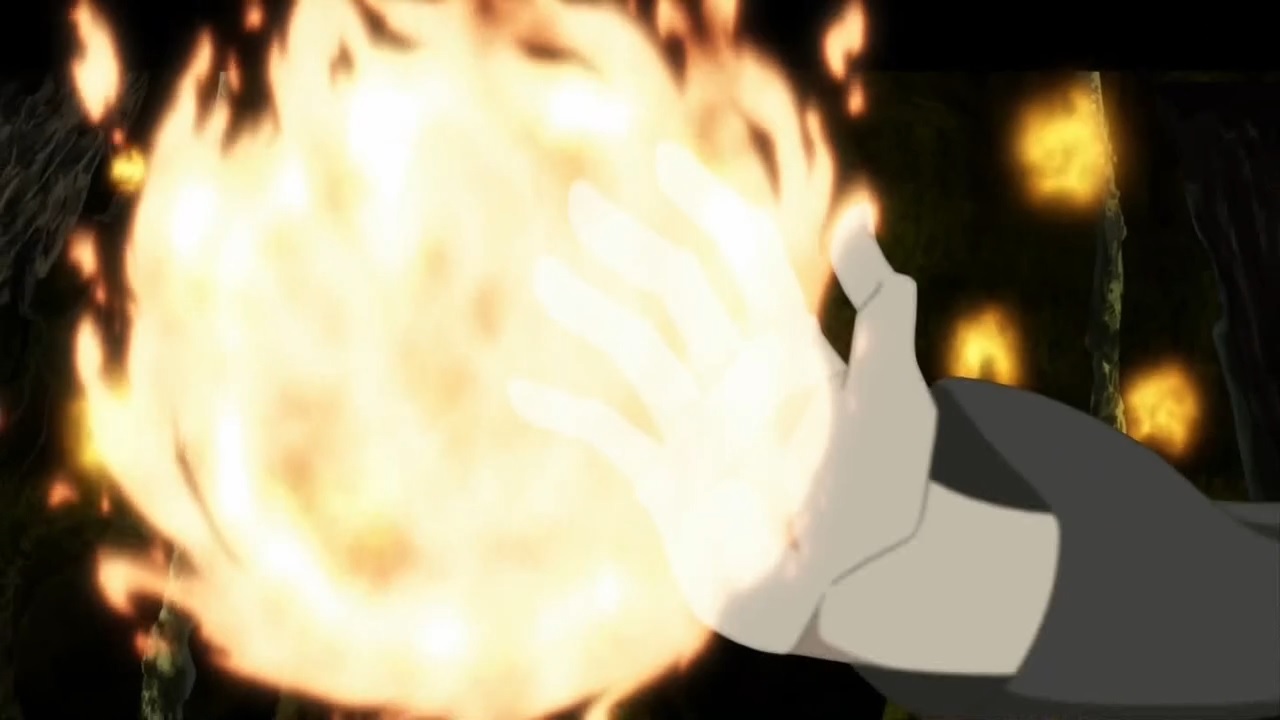
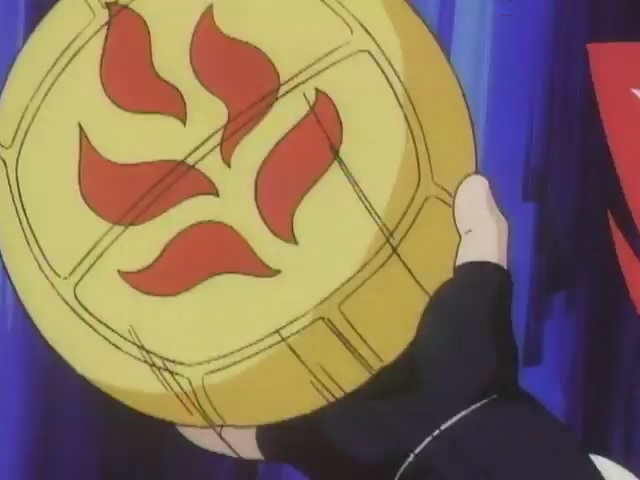
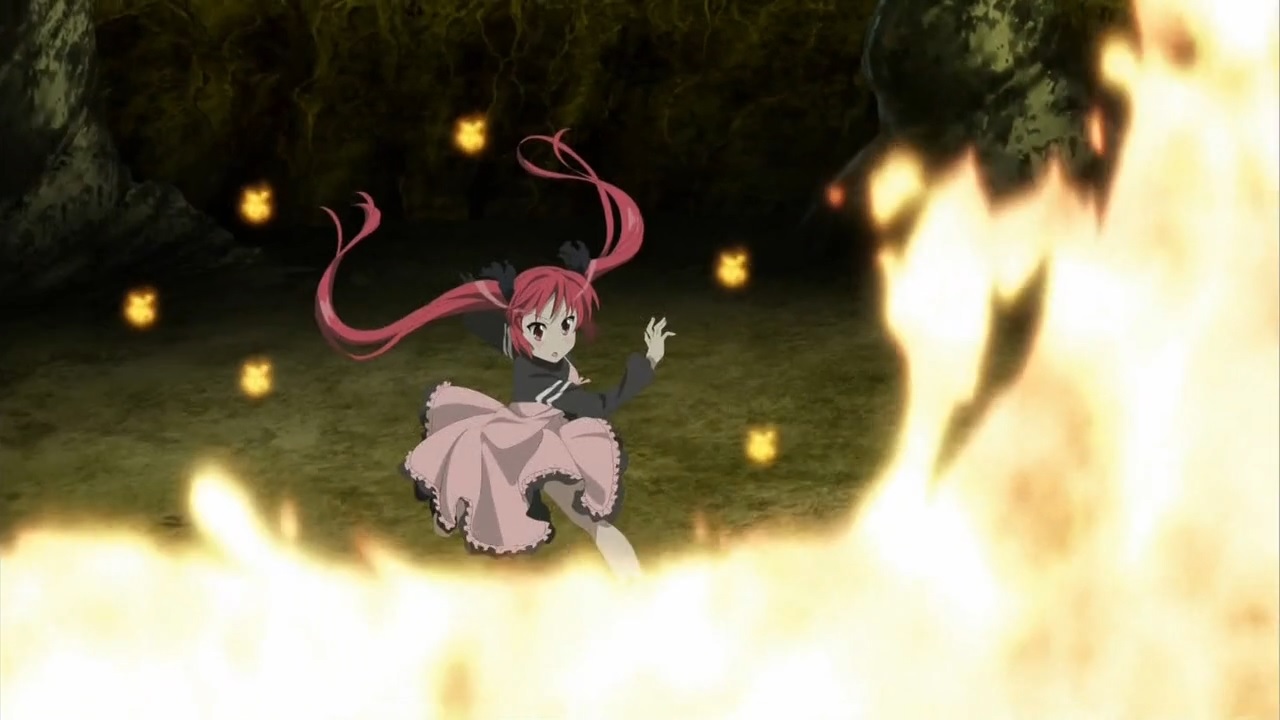
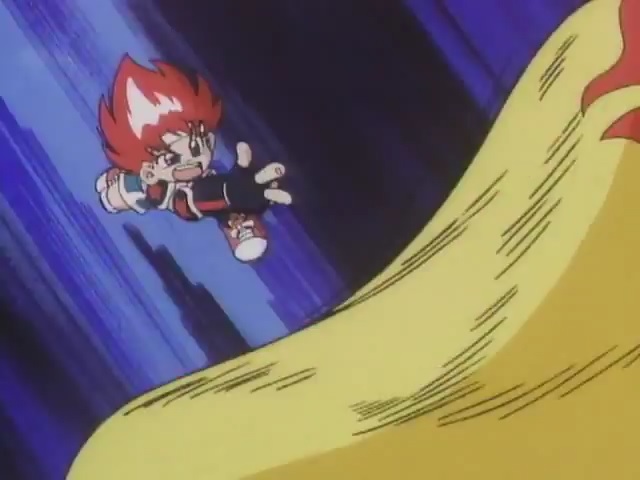

"Kill evil immediately." (7:01)
The Japanese line is "Aku Soku Zan desu" (悪即斬です). This is referencing Saitou Hajime (斎藤一) from "Rurouni Kenshin" (るろうに剣心), a manga series written by Watsuki Nobuhiro (和月伸宏) and published from 1994 to 1999. In the series, Saitou lives by a principle that he believes to be true justice that he calls "Aku Soku Zan" (悪即斬), "Kill evil immediately". Image for reference:
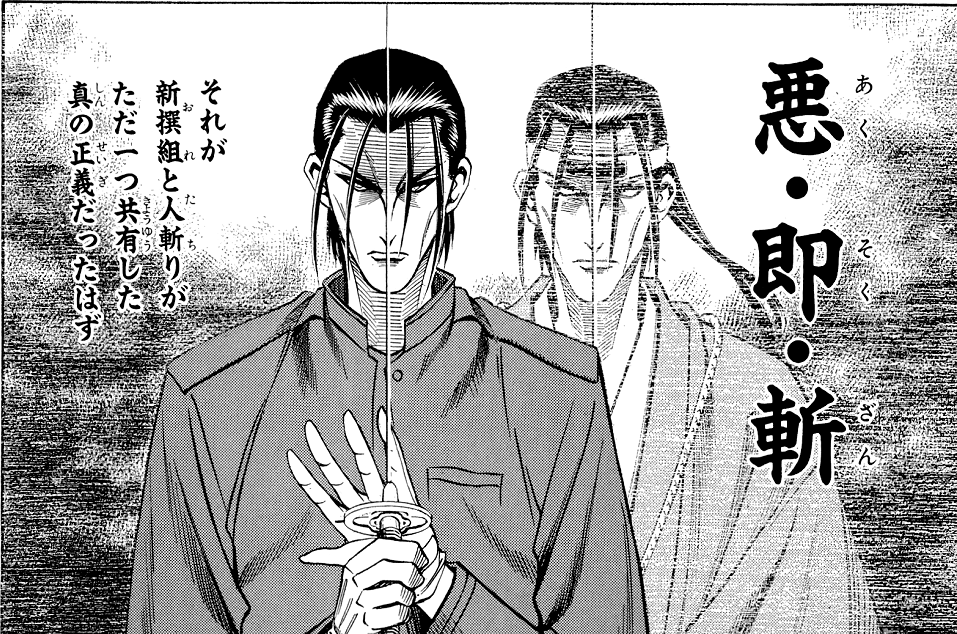
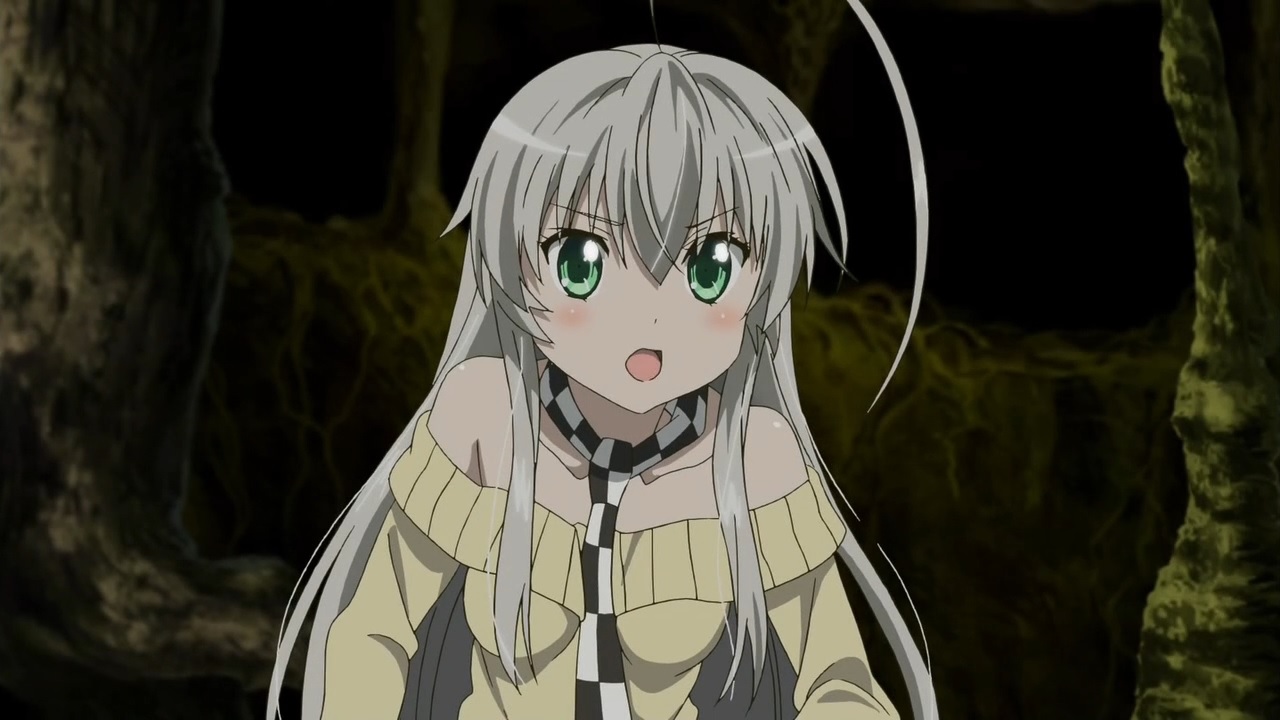
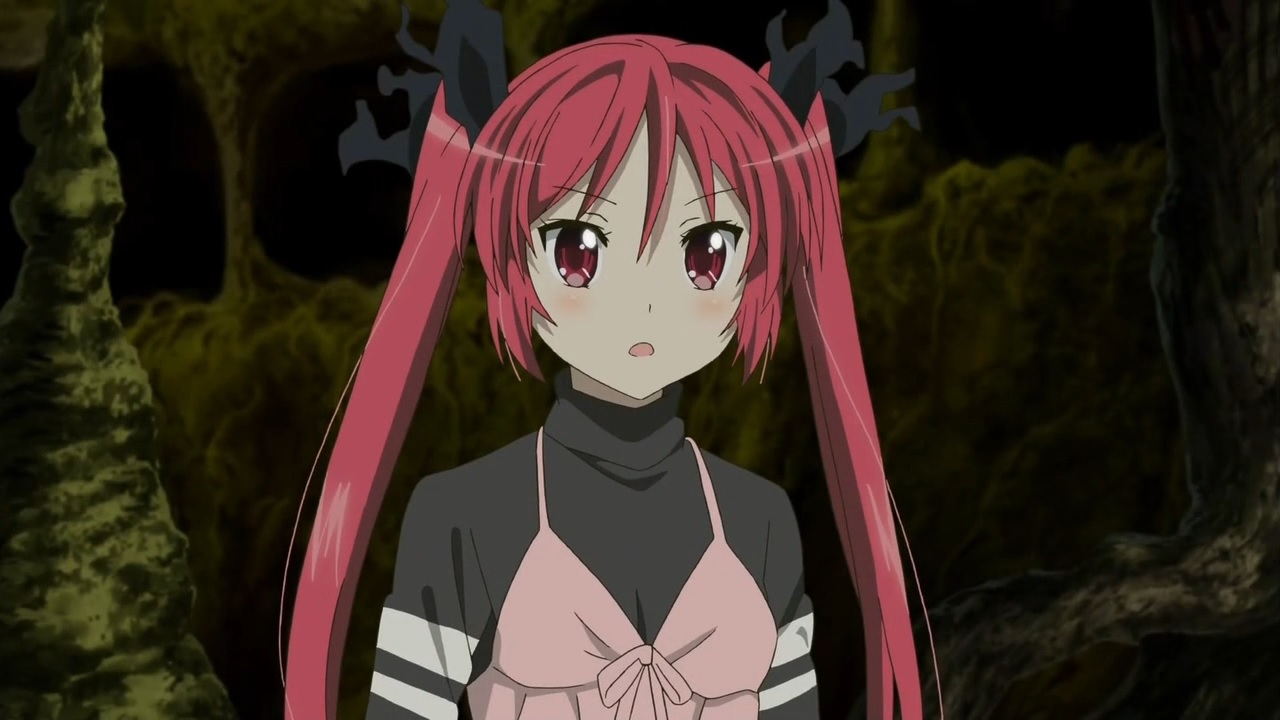
(7:13 - 7:31)
The lines at this time go as follows,
ニャル子:「ツァールのほうが残りましたか?」This is referencing lines from the scene in which Kamen Rider W (仮面ライダーW) is first introduced in "Kamen Raidaa Dikeido Ooru raidaa tai Dai Shokkaa" (仮面ライダーディケイド オールライダー対大ショッカー), "Kamen Rider Decade All Riders vs. Great Shocker", a movie released in 2009. The right side of Kamen Rider W's body is green, and his left side is black. When Kamen Rider W is introduced, he is seen from the right and left sides of his body, such that the progonists see his right side and one of the antagonists sees his left side. Images for reference:
クー子:「なんどやっても、私には勝てないよ、ロイガー。」
ニャル子:「ロイガー?ツァールでしょうが!」
ツァーロイガー:「どっちもだ。我が名はツァーロイガー。二人で一人のグレート・オールド・ワンだ!」
Nyaruko: "Only Zhar is remaining, huh?"
Cthuko: "No matter what you do, you can't defeat me, Lloigor."
Nyaruko: "Lloigor? It's clearly Zhar!"
ZharLloigor: "I'm both. My name is ZharLloigor. The two of us are a single Great Old One!"
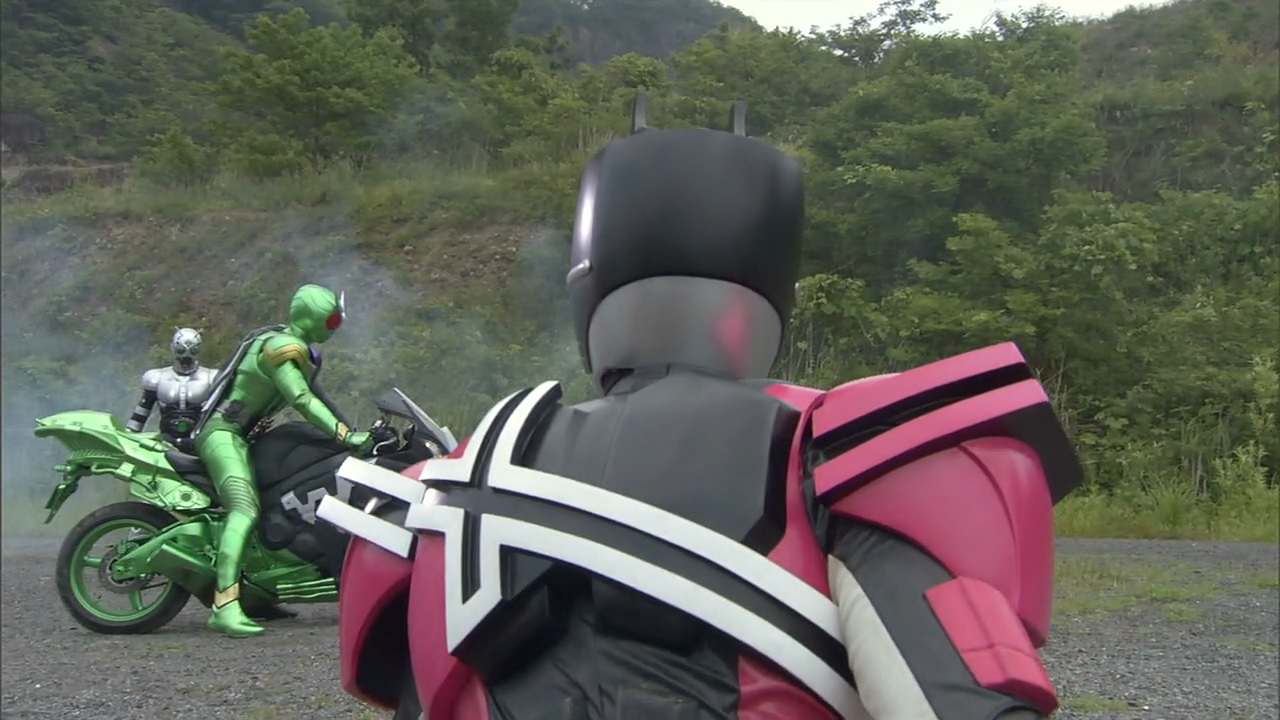
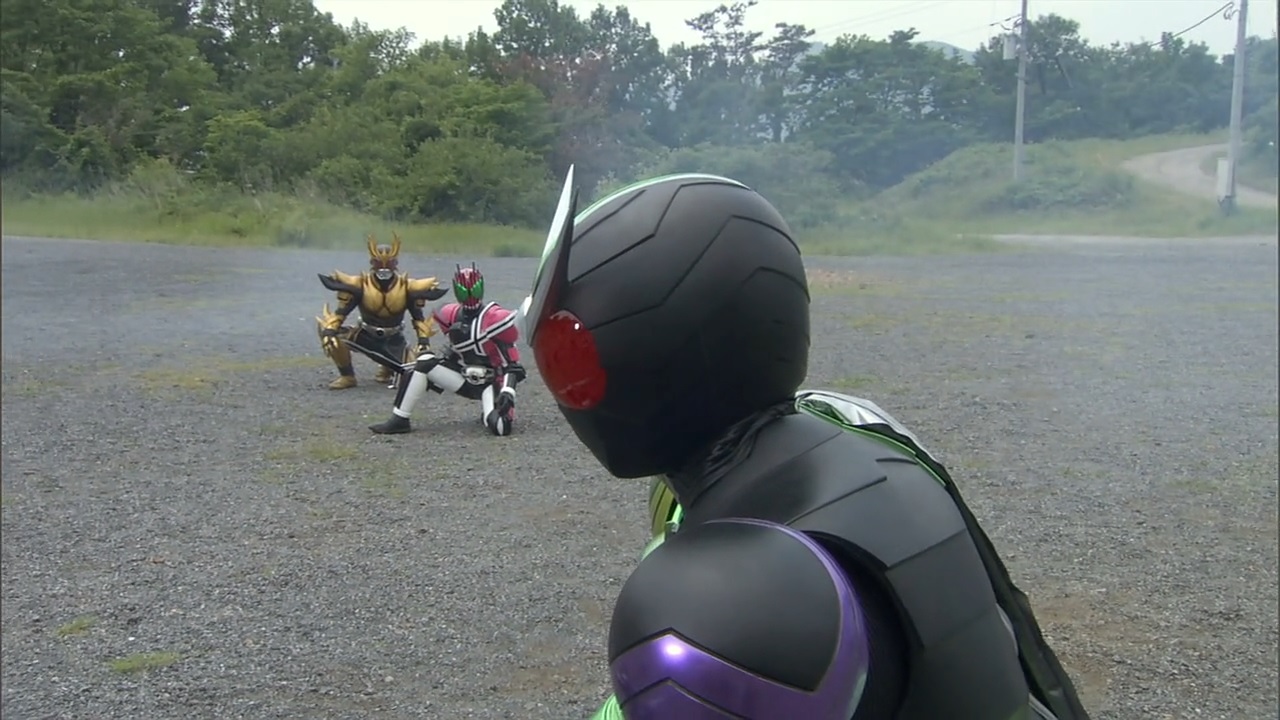
The original lines go as follows,
仮面ライダーディケイド:「緑ノライダー。」
世紀王シャドームーン:「黒の・・・ライダー。」
仮面ライダーディケイド:「黒?緑だ。」
仮面ライダーW:「どっちもだ。俺の名は、仮面ライダーW。」
Kamen Rider Decade: "A green Rider."
Century King Shadow Moon: "A black... Rider."
Kamen Rider Decade: "Black? He's green."
Kamen Rider W: "I'm both. My name is Kamen Rider W."
"The two of us are a single Great Old One!" (7:27)
There are two references here:
* The Japanese line is "Futari de hitori no gureeto oorudo wan da!" (二人で一人のグレート・オールド・ワンだ!). This is referencing a catch phrase from "Kamen Rider W" (仮面ライダーW), a Japanese TV show about a masked super hero that aired from 2009 to 2010. The main hero of the show, Kamen Rider W, is comprised of two people, Hidari Shoutarou (左翔太郎) and Philip (フィリップ), and they run a detective agency together. In episode 1, Philip says, "Boku tachi ha futari de hitori no tantei da mono" (僕たちは二人で一人の探偵だもの), which translates to "The two of us are a single detective after all".
* In the Cthulhu Mythos, both Zhar and Lloigor are creatures classified as Great Old Ones. Zhar and Lloigor first appeared in "The Lair of the Star-Spawn", a short story written by August Derleth and Mark Schorer and first published in 1932. In the story, Zhar and Lloigor are collectively called "the twin Obscenities".
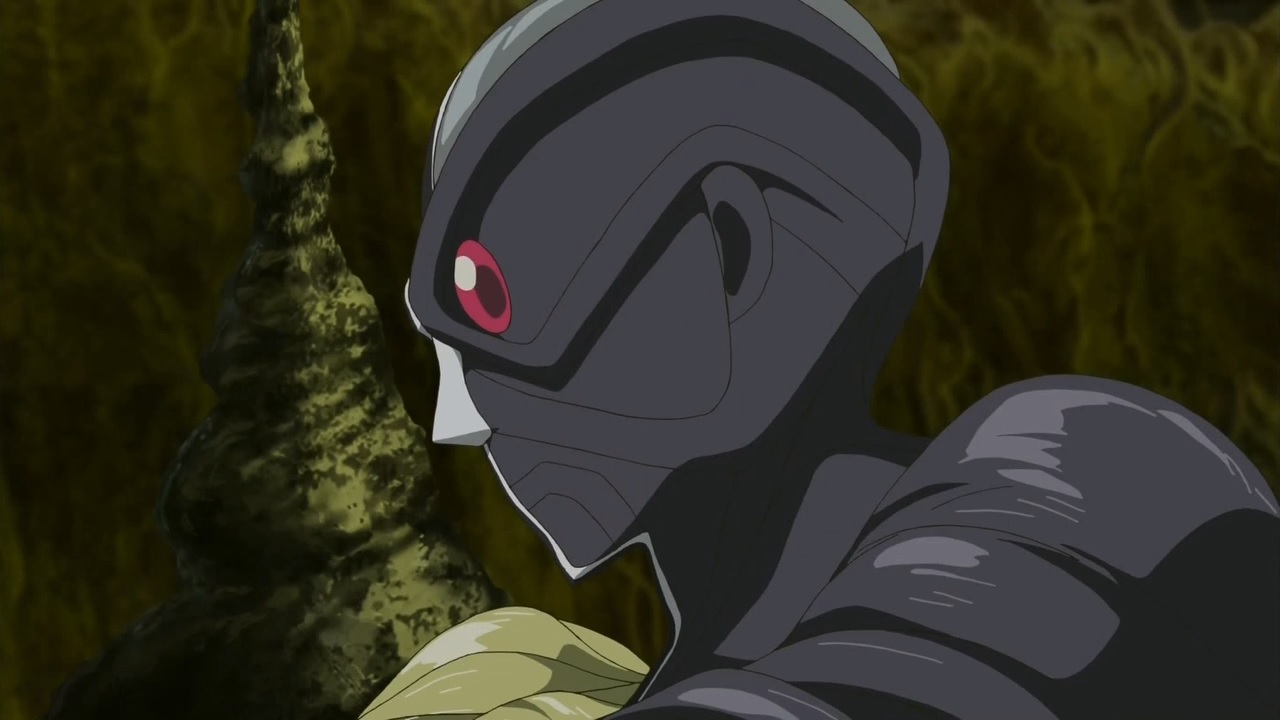
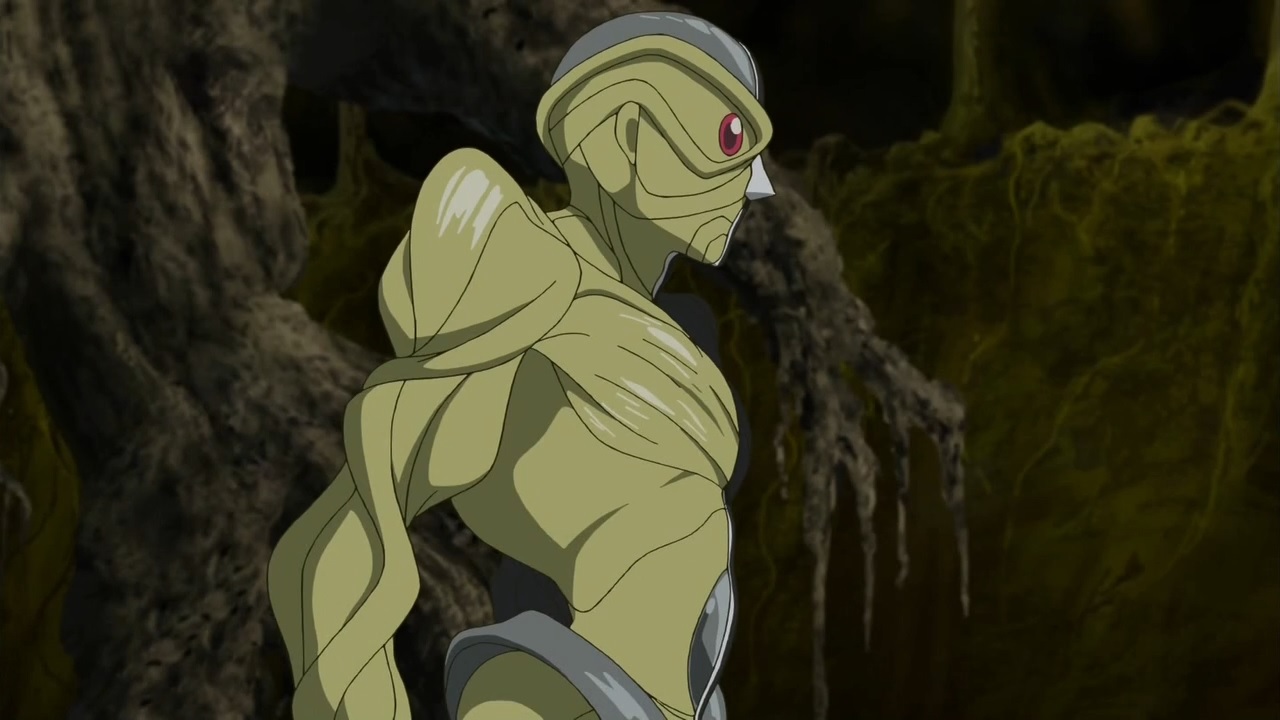
(7:32)
There are two shots shown of ZharLloigor from each side. This is referencing when Kamen Rider W first appears in episode 1 of "Kamen Rider W" (仮面ライダーW). At that time there are two shots shown of Kamen Rider W from each side. Images for reference:
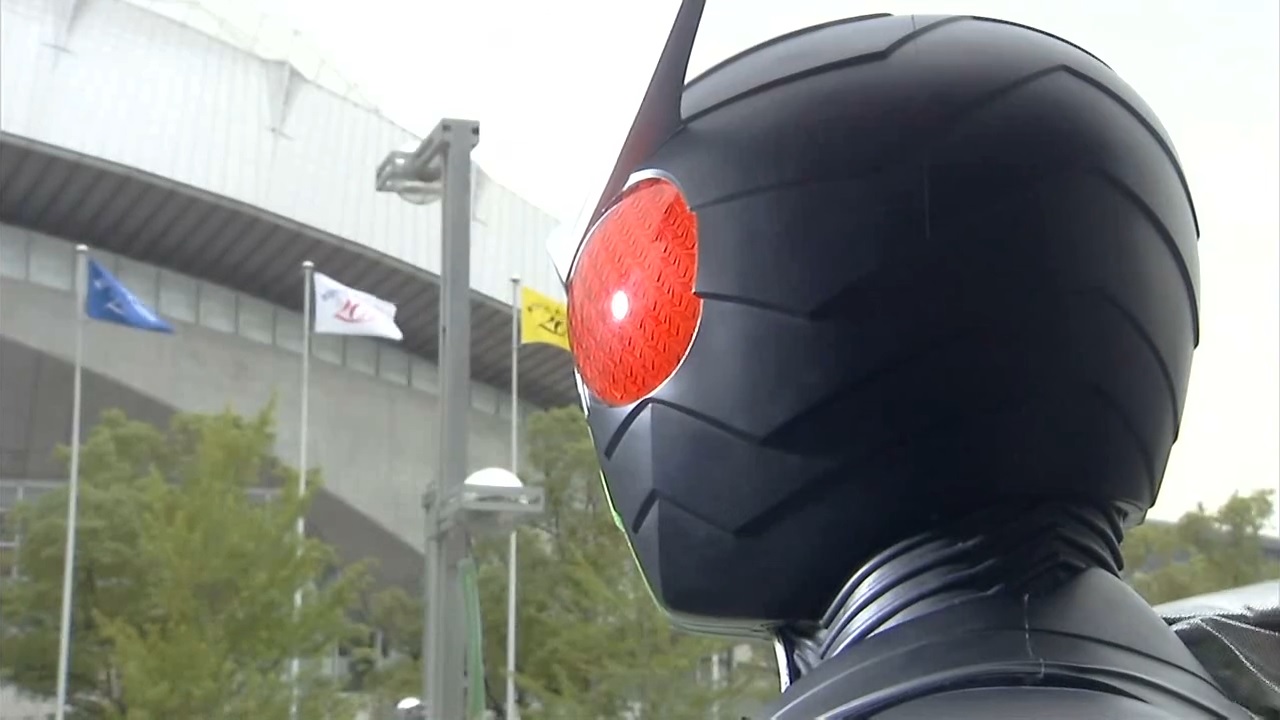
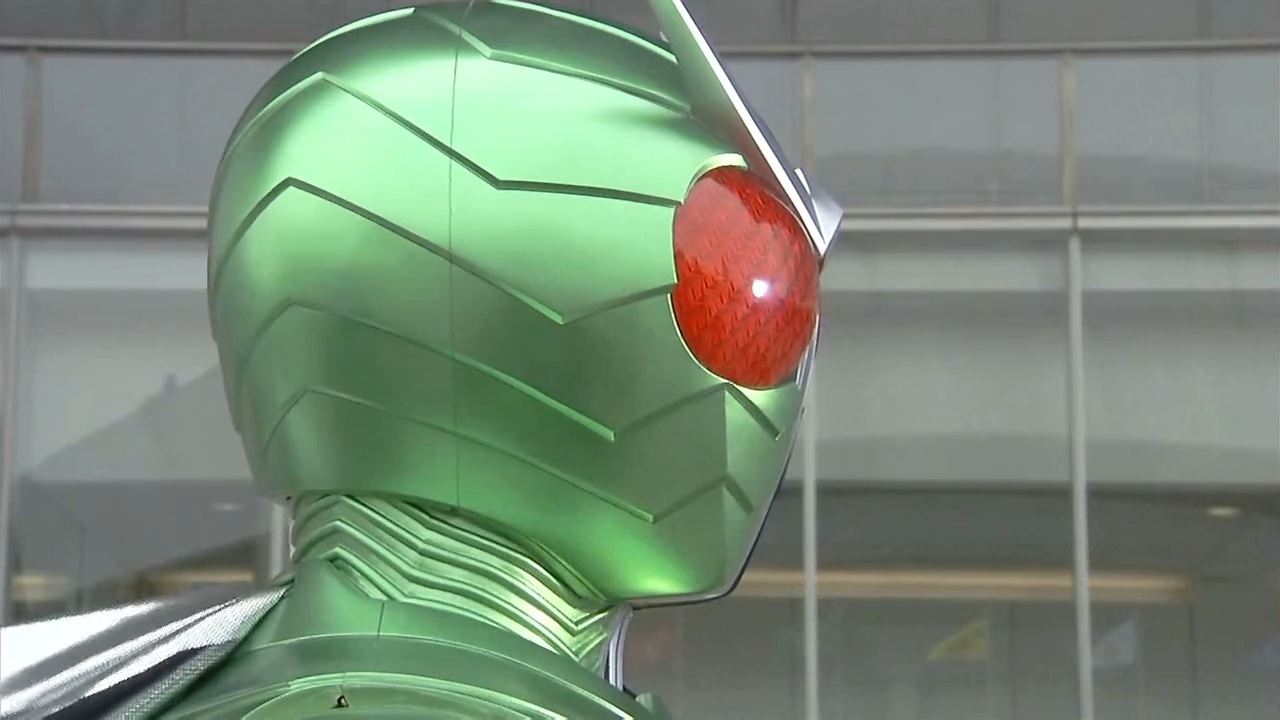
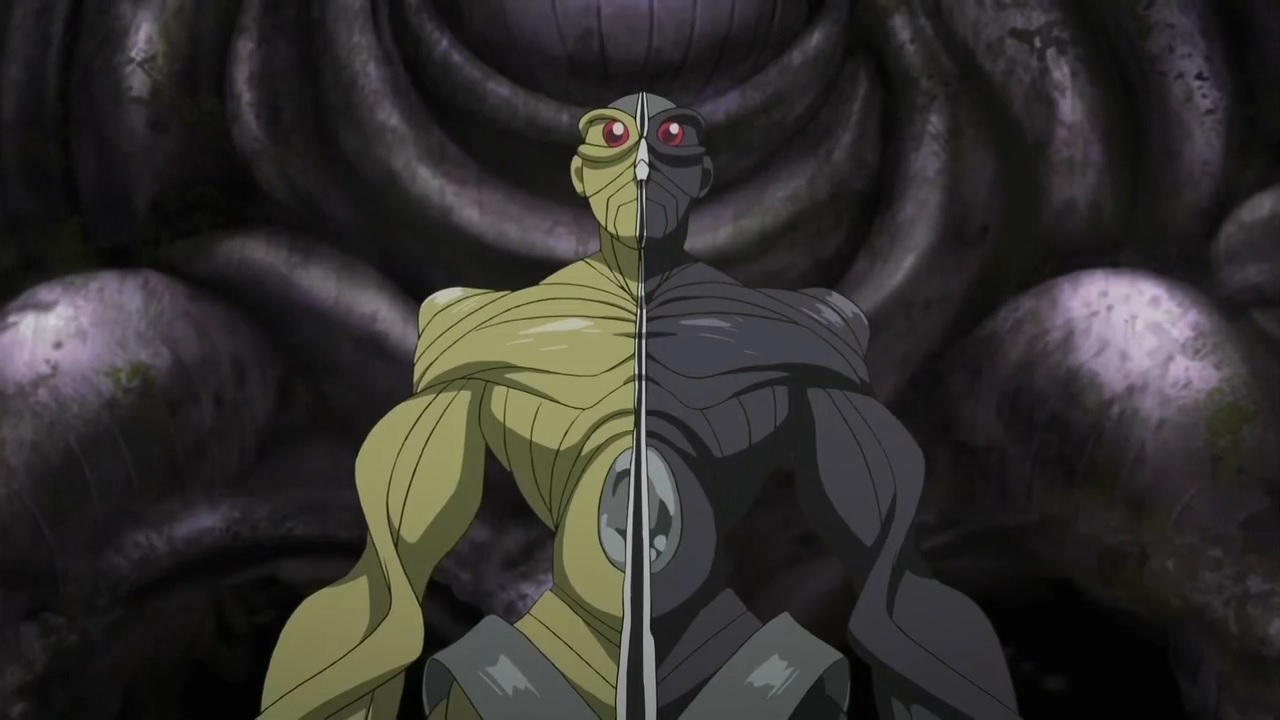
(7:37)
The colors of Zhar and Lloigor and their combined ZharLloigor form are referencing the LunaJoker (ルナジョーカー) form of Kamen Rider W in "Kamen Rider W" (仮面ライダーW). Image for reference:
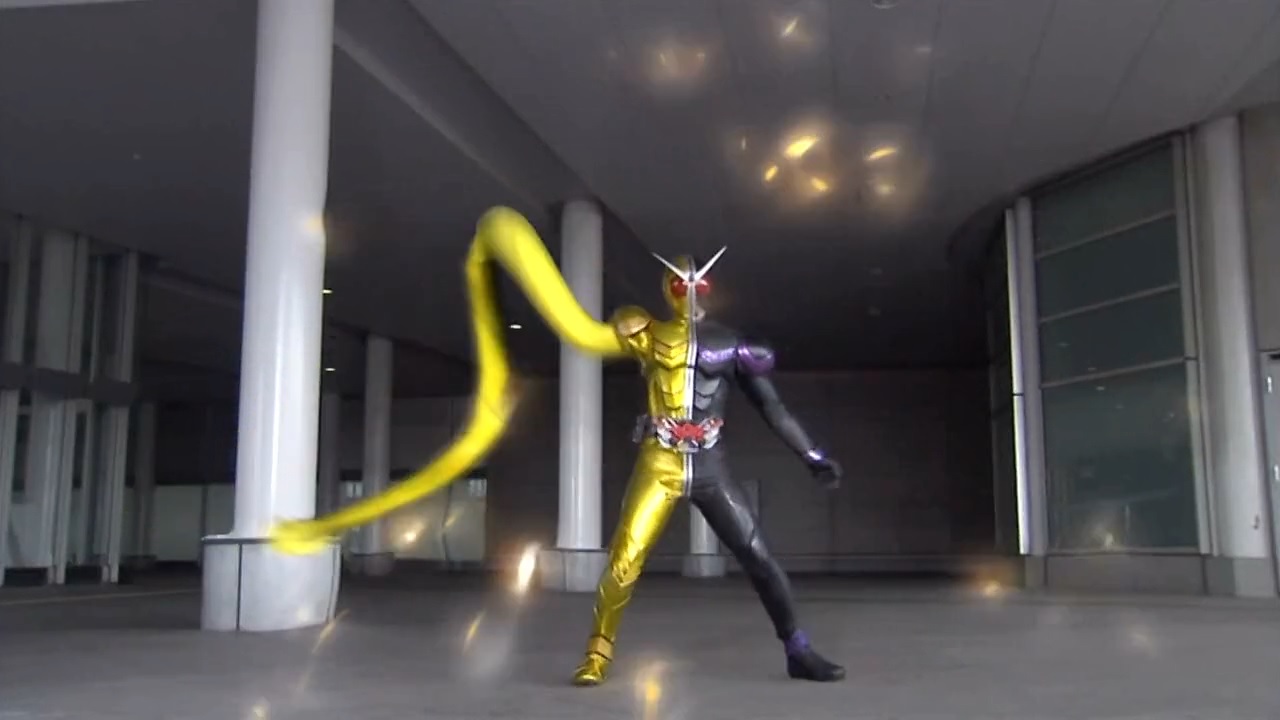

(7:40)
The bomb Nyaruko is holding is referencing "Doraemon" (ドラえもん), a manga series written by Fujiko F. Fujio (藤子・F・不二雄) and published from 1969 to 1996.S1 In volume 7 in the chapter titled "Nezumi to Bakudan" (ネズミとばくだん), "The Mouse and the Bomb", Doraemon, due to his extreme fear of mice, pulls out a bomb called "Chikyuu hakai bakudan" (地球はかいばくだん), "Earth Destruction Bomb", in order to exterminate a mouse. Image for reference:
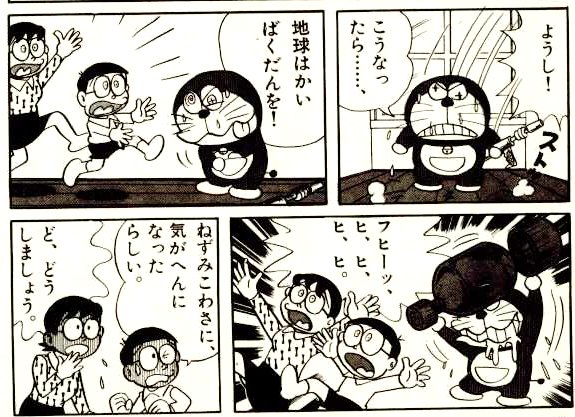
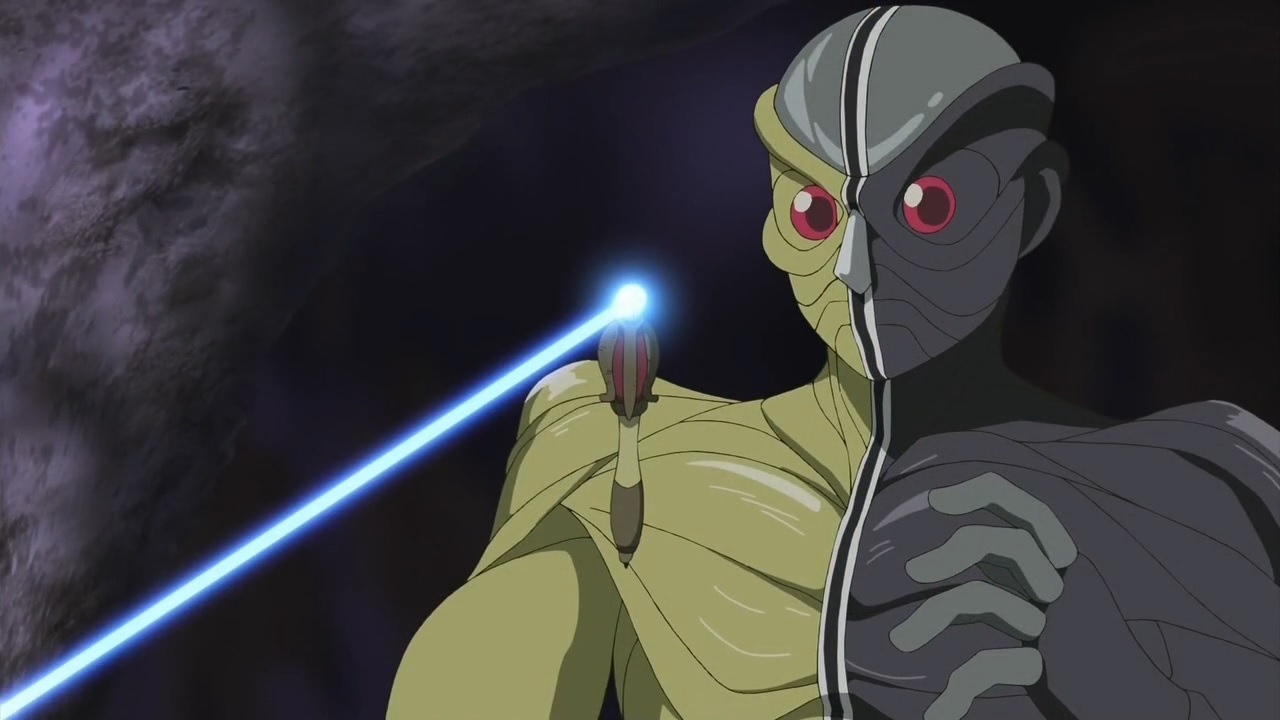
(8:00)
"Ooinaru isan" (大いなる遺産), "great inheritance", is able to shine a beam of blue light that points in the direction of the other great inheritance. This is referencing "Tenkuu no Shiro Rapyuta" (天空の城ラピュタ), "Laputa: Castle in the Sky", a movie released in 1986.S2 In the movie, there is a castle floating in the sky that is called Laputa, and the castle is kept afloat by a large magical stone called "hikouseki" (飛行石), "Levitation Stone". One of the main characters, Sheeta (シータ), possesses a small Levitation Stone that has the ability to shine a beam of blue light that points in the direction of Laputa. Image for reference:
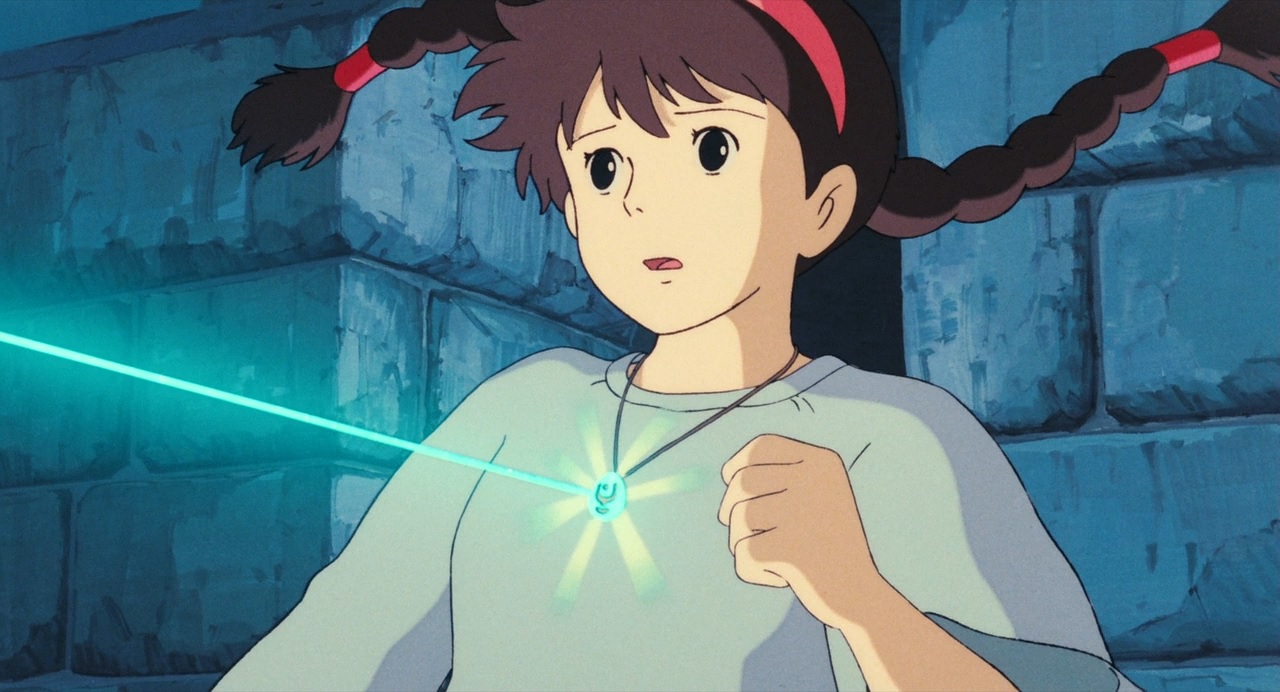
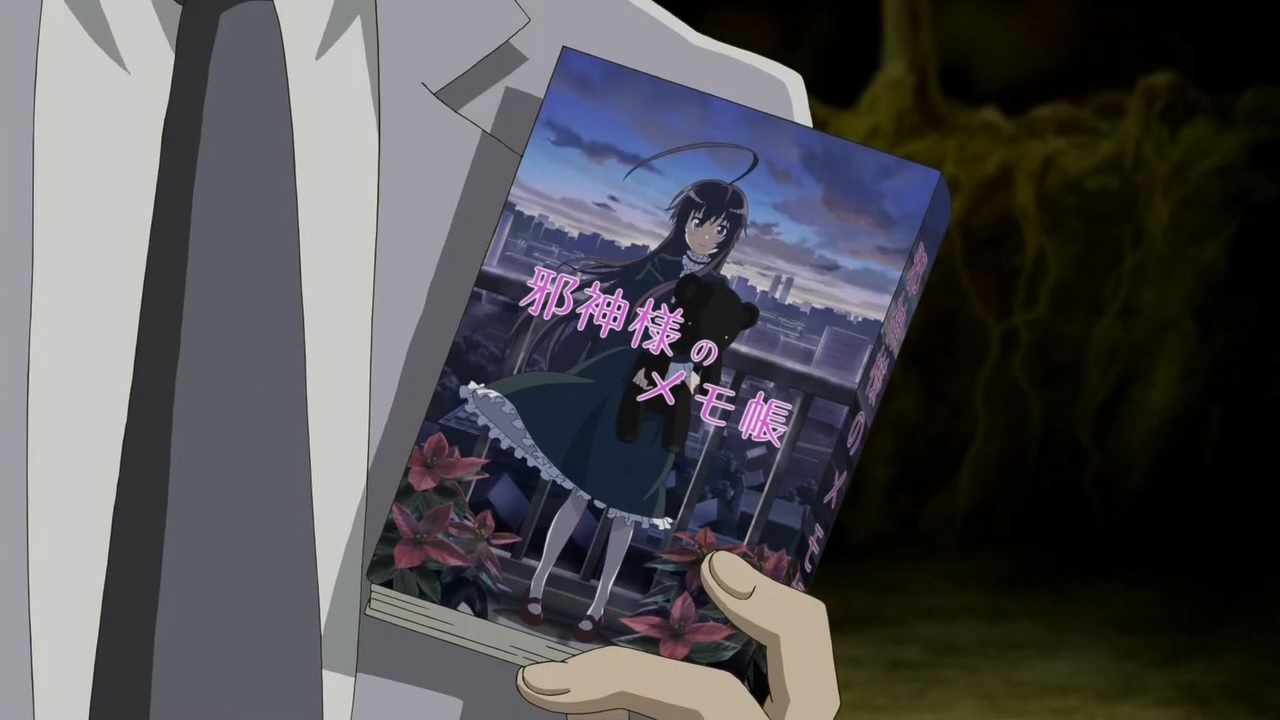
(8:17)
This book appeared in episode 2 at 8:14. The title of this book is "Jashin-sama no Memo Chou" (邪神様のメモ帳), which translates to "Evil God's Memo Pad". This is referencing "Kami-sama no Memo Chou" (神様のメモ帳), "God's Memo Pad", a light novel series written by Sugii Hikaru (杉井光) and published starting from 2007. The cover of the book is also referencing the cover art of volume 1 of this series. Image for reference:

Source of image: https://bookwalker.jp/de99856cb3-05c9-41ac-98de-8b035457bf09/
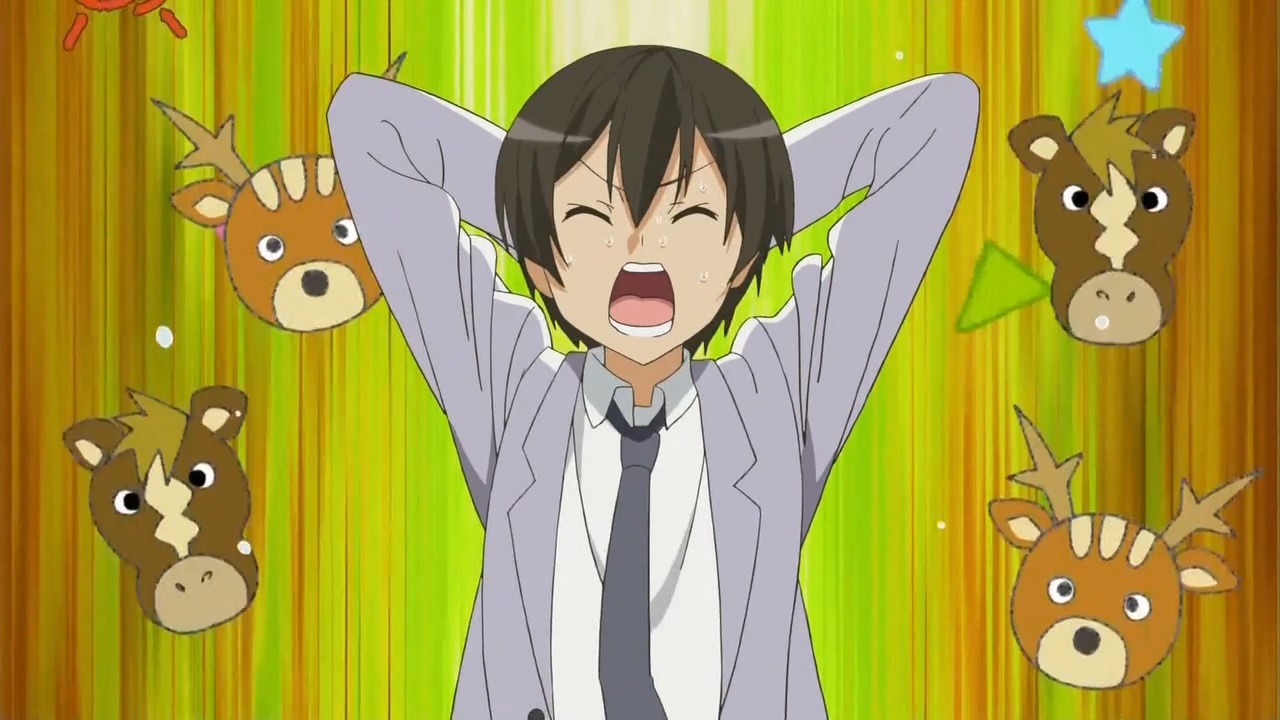
(8:48)
The reason for the horse and deer appearing in the background is because the characters for horse and deer are 「馬」 (uma) and 「鹿」 (shika). When these two characters are combined they form the term 「馬鹿」 (baka), which means "fool" or "idiot".S1
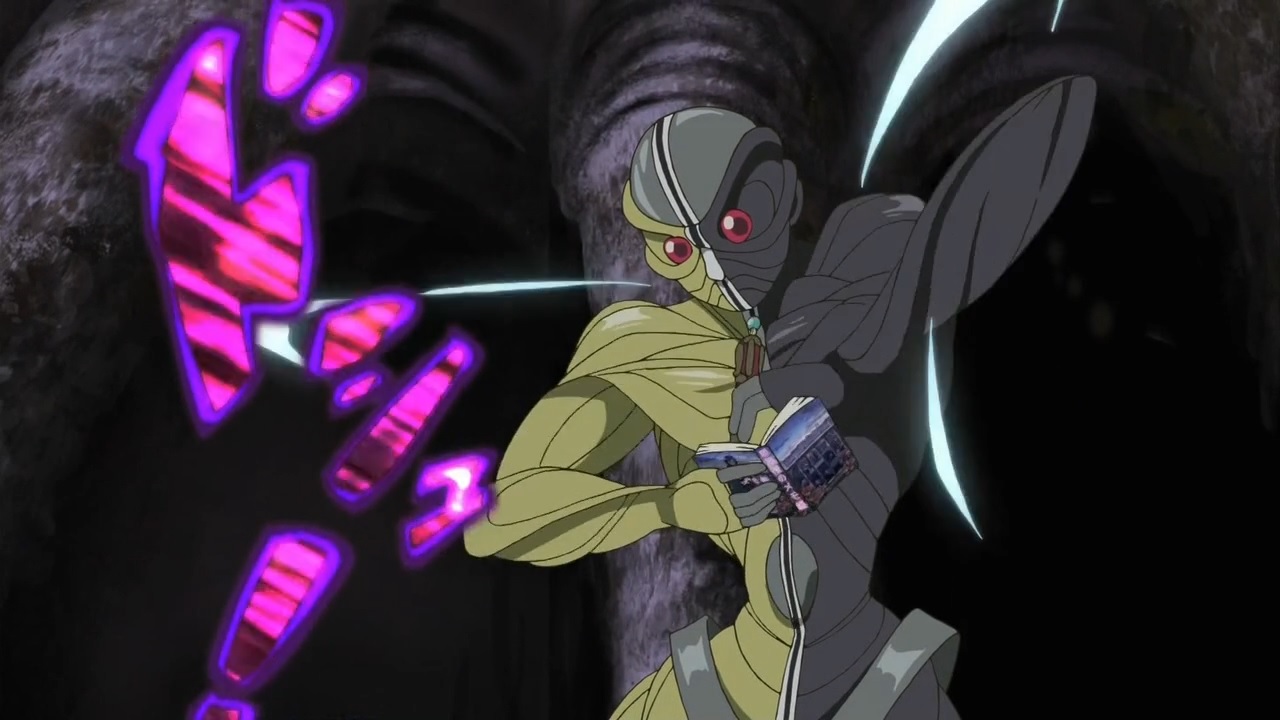
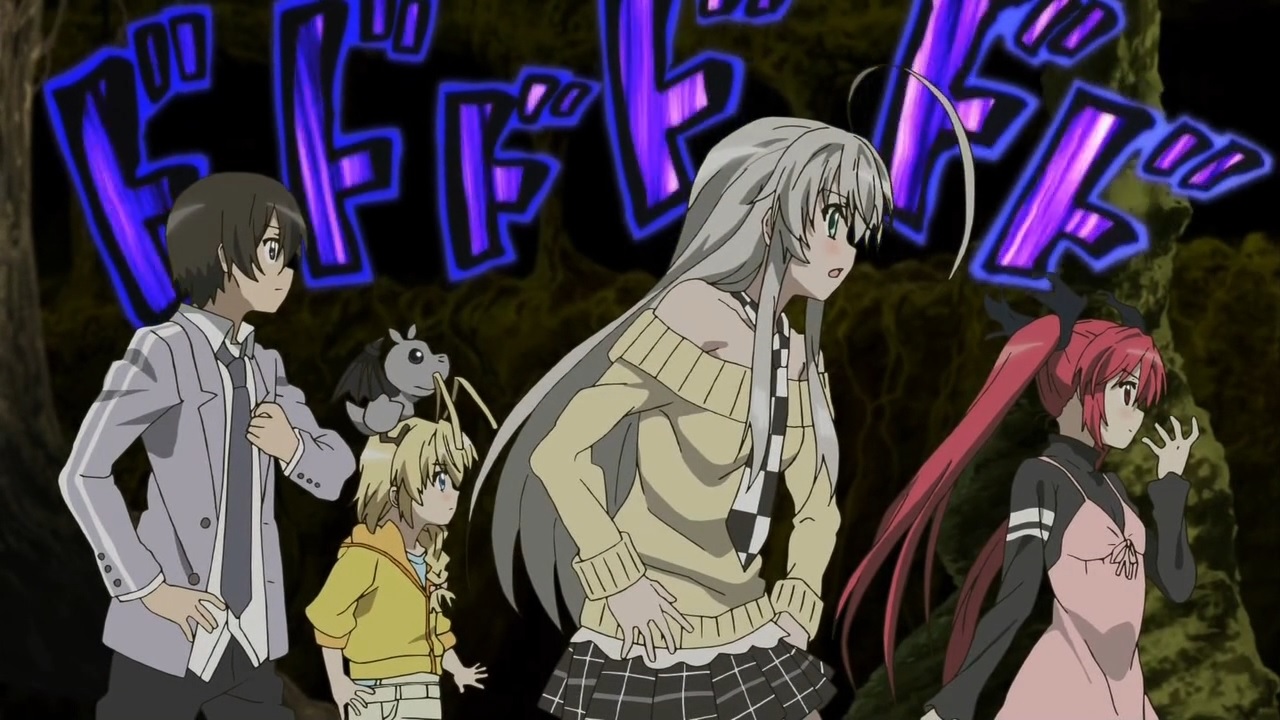
(9:35 - 9:41)
At first ZharLloigor and the text written in the background both repeatedly say "Doshu!" (ドシュ!), a Japanese onomatopoeia for the sound of writing or drawing. Then, ZharLloigor and the text written in the background both repeatedly say "Do!" (ド!), which is a Japanese onomatopoeia for the sound of a "thud". These are both referencing "Jojo no Kimyou na Bouken" (ジョジョの奇妙な冒険), "Jojo's Bizarre Adventure", a manga series written by Araki Hirohiko (荒木飛呂彦) and published starting from 1987. The series is known for showing a large amount of sound effects as onomatopoeia displayed as text.
* "Doshu" is more specifically referencing Kishibe Rohan (岸辺露伴), a character in the series who is a manga artist. When he draws, sometimes the text "Doshu!" (ドシュ!) will appear. Image for reference:
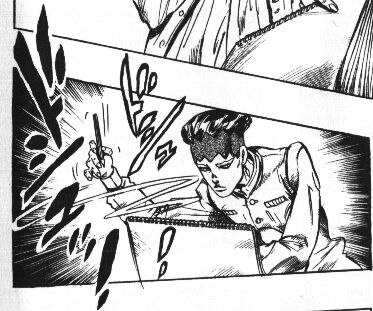
* In the series, "Do" (ド) is used to represent dramatic tension. Image for reference:
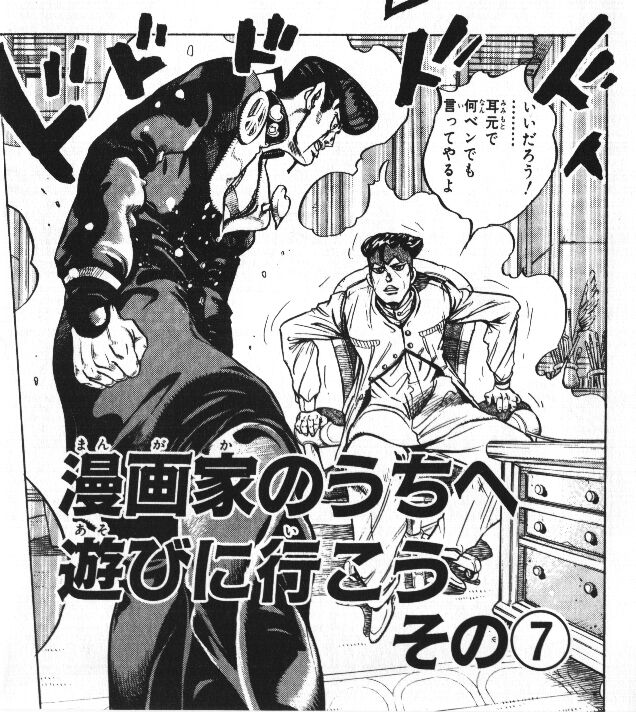
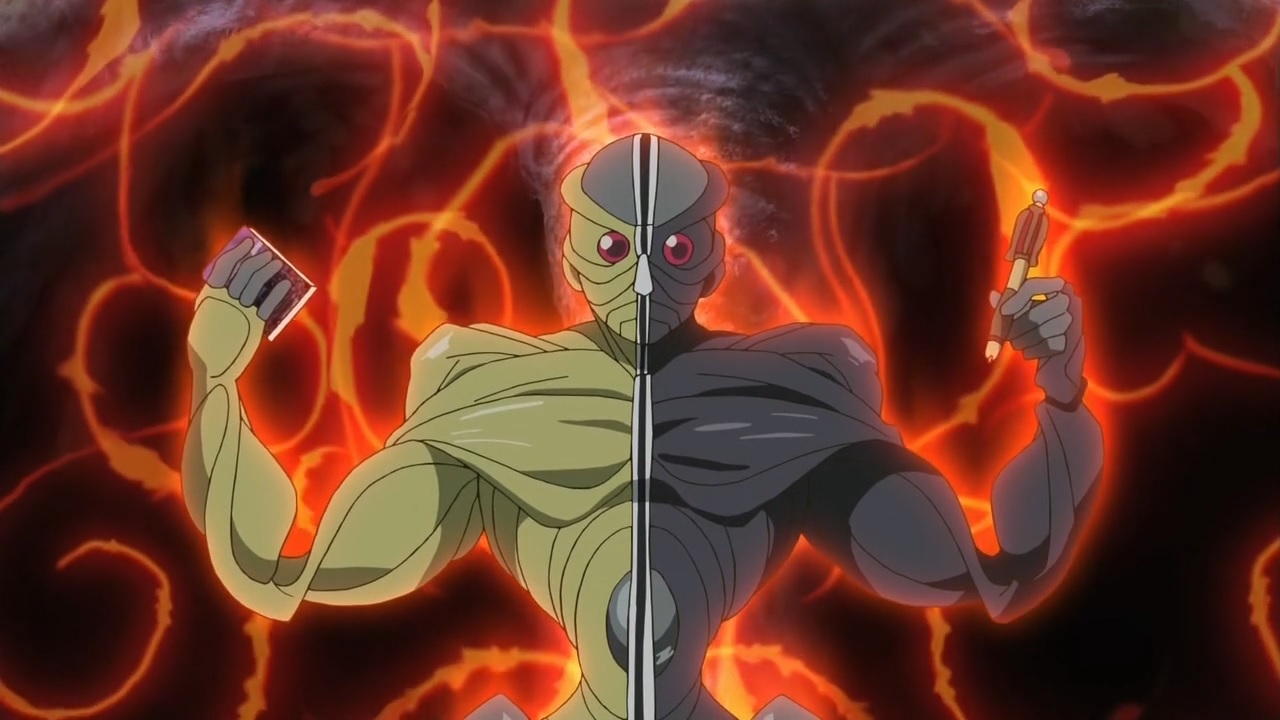
"When one writes in this book using the paired pen, the book becomes a Dream Notebook that brings forth an evil god according to the written specifications." (9:49)
"Doriimu na nooto" (ドリームなノート), "Dream Notebook", the paired pen, and the ability of the book are referencing "WING-MAN" (ウィングマン), a manga series written by Katsura Masakazu (桂正和) and published from 1983 to 1985.S2 In the series there exists a notebook called "Dorimu Nooto" (ドリムノート), "Dream Notebook", and there exists a pen that is paired with the book called "Dorimu Pen" (ドリムペン), "Dream Pen". Whatever is written in the Dream Notebook using the Dream Pen will become reality. The main character, Hirono Kenta (広野健太), uses the power of the Dream Notebook to transform into Wing-Man, a super hero he created.

"This halved evil god!" (10:02)
The Japanese line is "Kono hanbun ko jashin!" (この半分こ邪神!). This is referencing a line said by Narumi Akiko (鳴海亜樹子) in episode 2 of "Kamen Rider W" (仮面ライダーW).S2 When Akiko sees Kamen Rider W for the first time she exclaims, "Futari ga hanbun ko kaijin ni!" (二人が半分こ怪人に!), which translates to, "The two of them became a mysterious halved person!".
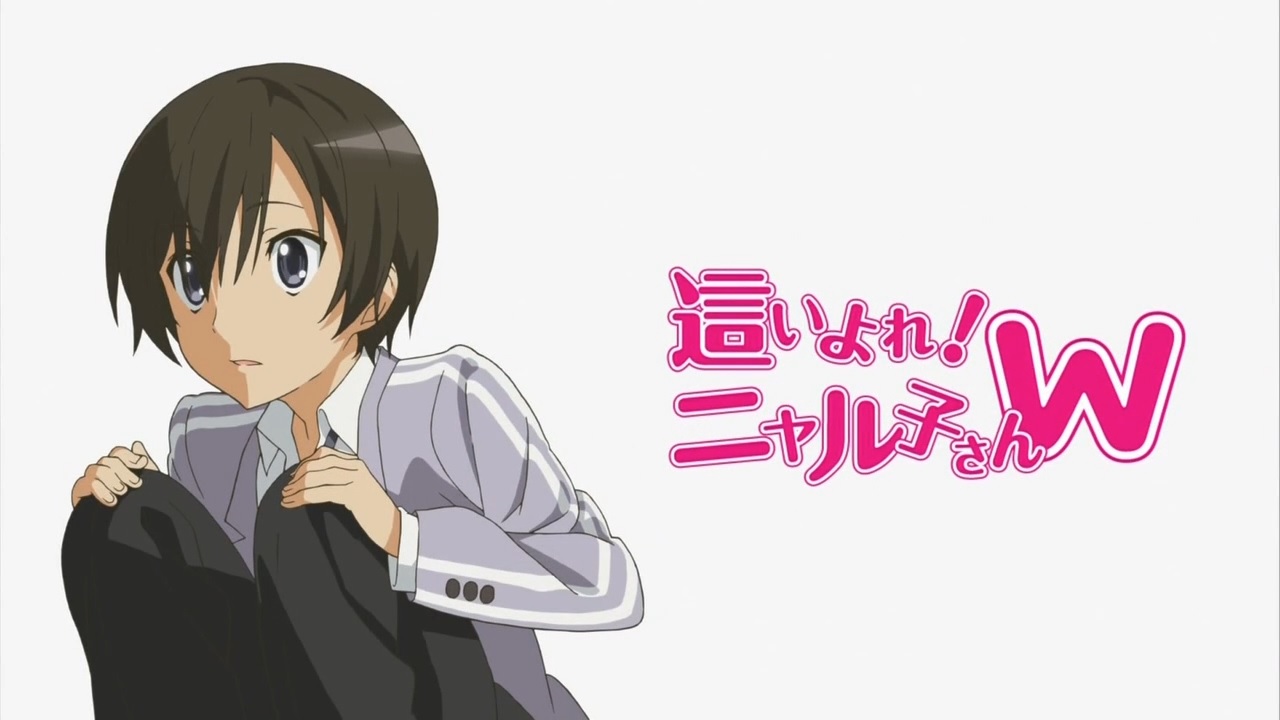
"This is the first time in my life that I've ever seriously thought that I want to hit a woman." (10:25)
There are two references here:
* The Japanese line is "O... Onna wo naguritai to honki de omotta no ha umarete hajimete da..." (お・・・女を殴りたいと本気で思ったのは生まれて初めてだ・・・). This is a line said by Yagami Raito (夜神月) in chapter 31 in volume 4 of "DEATH NOTE" (デスノート), a manga series written by Ooba Tsugumi (大場つぐみ) and published from 2003 to 2006. Image for reference:
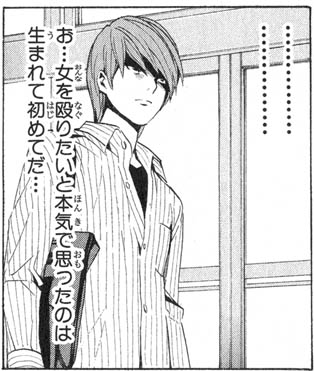
* Mahiro's sitting pose is referencing that of L (エル) from "DEATH NOTE".S1 Image for reference:
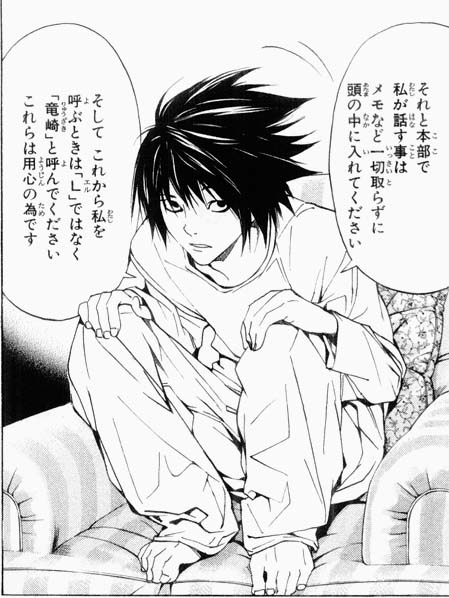
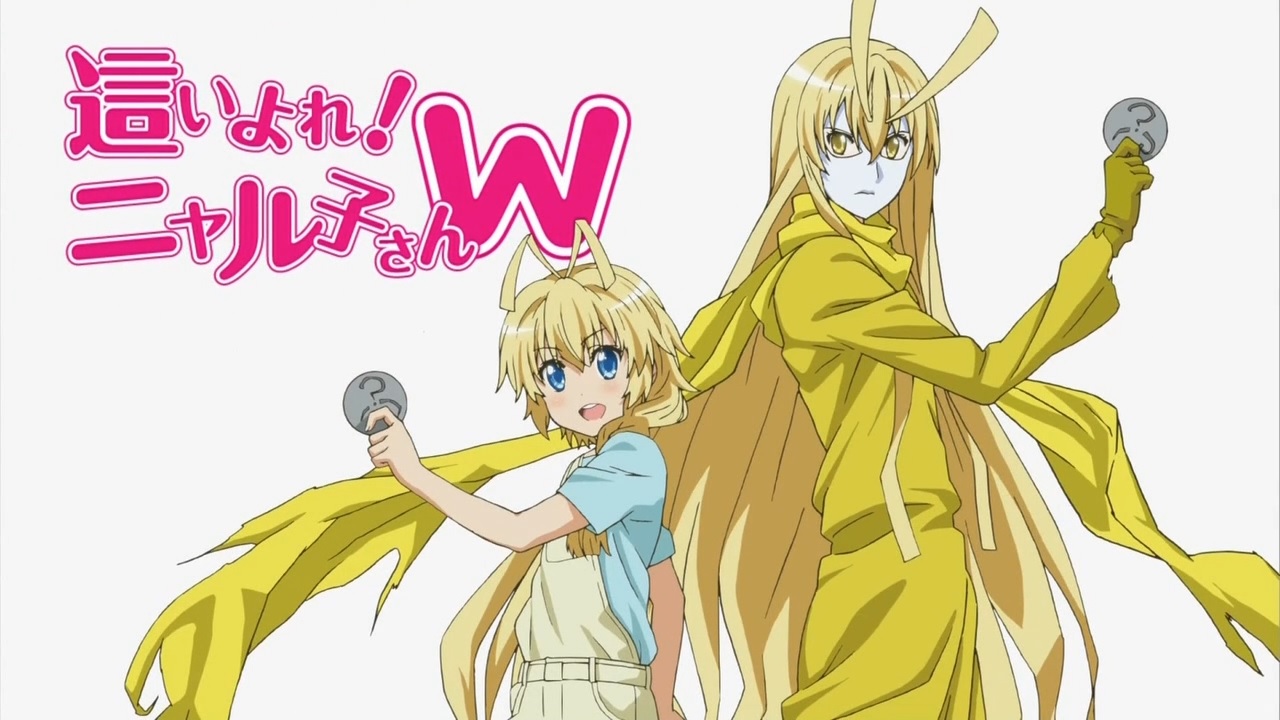
"Now, count up your sins!" (10:29)
There are three references here:
* The Japanese line is "Saa, omae no tsumi wo kazoero!" (さあ、お前の罪を数えろ!). This is the catch phrase of Kamen Rider W from "Kamen Rider W" (仮面ライダーW).
* The poses Hasta and his alternate form are doing are referencing the same poses done by Hidari Shoutarou (左翔太郎) and Philip (フィリップ) before they transform into Kamen Rider W. Image for reference:
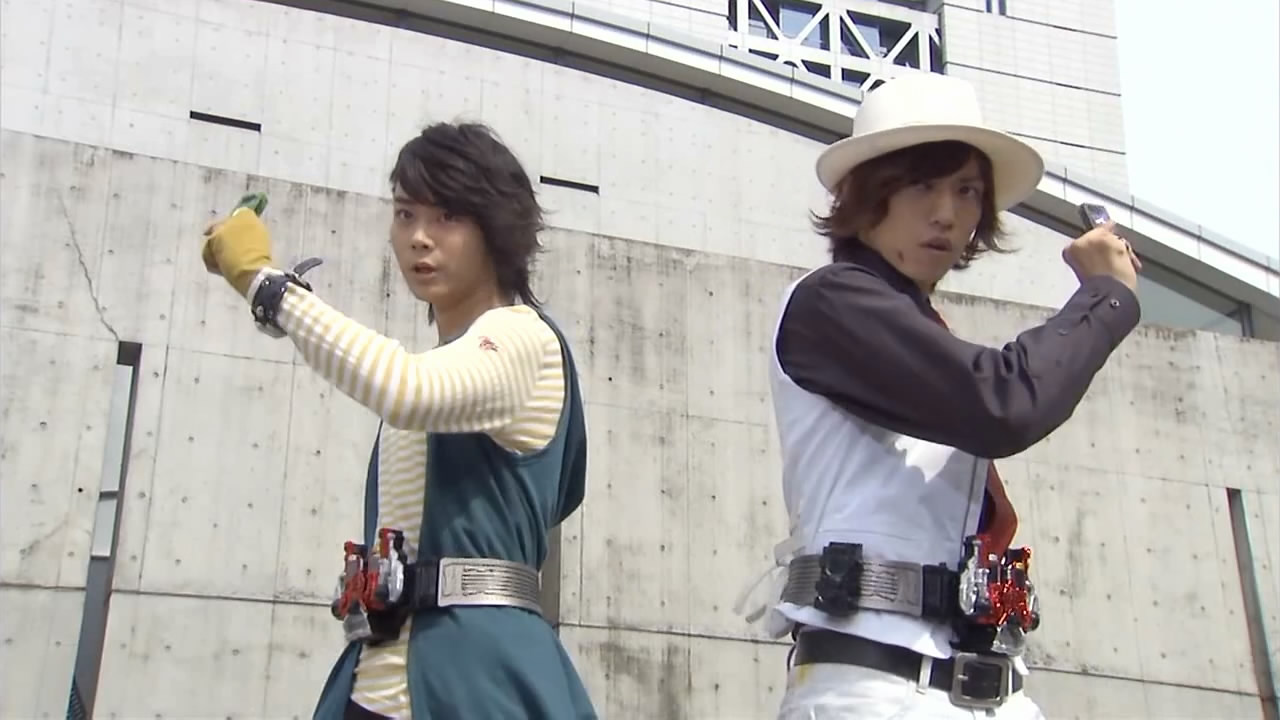
* This is the medal that Hasta and his alternate form are holding:

This medal has a depiction of the Yellow Sign, which is used as the sign of Hastur in the Cthulhu Mythos. Image from the 5th edition rule book for the "Call of Cthulhu" RPG for reference:

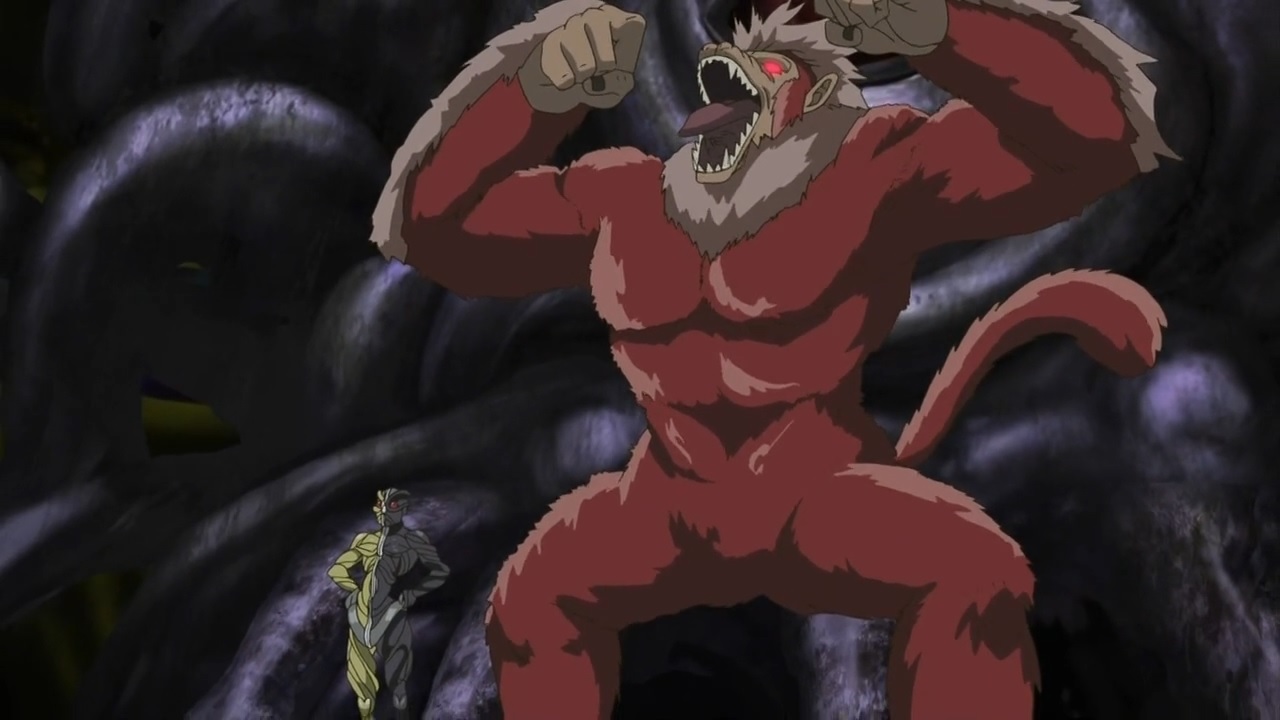
"Its name is Evil God, Alaozar!" (10:37)
There are two references here:
* As shown at 19:29, the way the name "Alaozar" is written in Japanese is 「アラオ猿」, and it is pronounced as "Araozaru" (アラオザル). In Japanese, this is the same pronunciation used for "Alaozar", a city in the Cthulhu Mythos under which Zhar and Lloigor dwell. In addition, the last character in this name is the Japanese character for "monkey". This character is usually pronounced as "saru", but when it is appended to another word as a suffix, its pronunciation is changed to "zaru".
* The appearance of Alaozar here is referencing that of Oozaru (大猿), "Giant Monkey", from "Dragon Ball" (ドラゴンボール), a manga series written by Toriyama Akira (鳥山明) and published from 1984 to 1995. In the series, there exists a race of human shaped beings called Saiyans (サイヤ人). Under certain conditions, a member of this race can transform into a giant monkey called Oozaru. Image for reference:
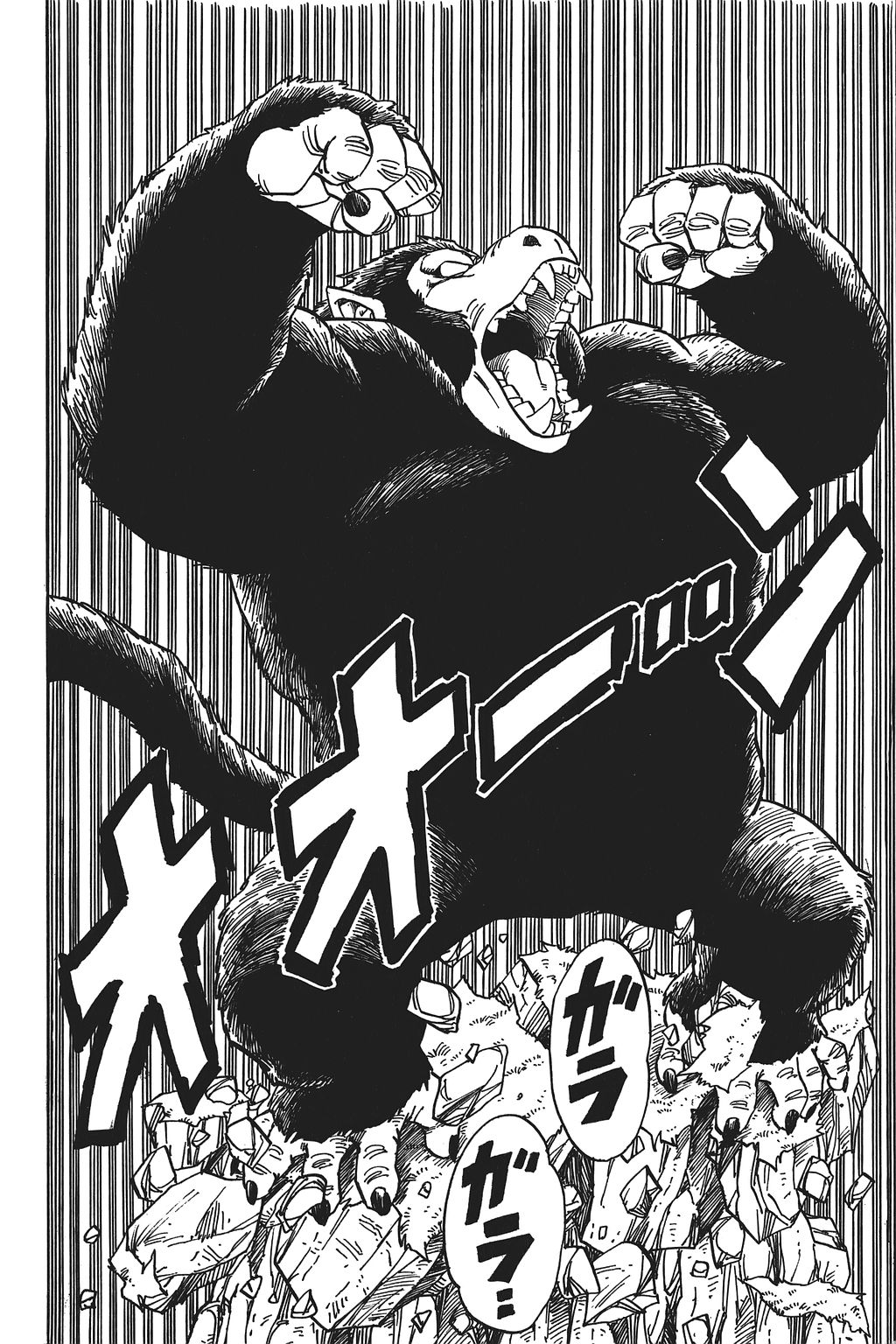
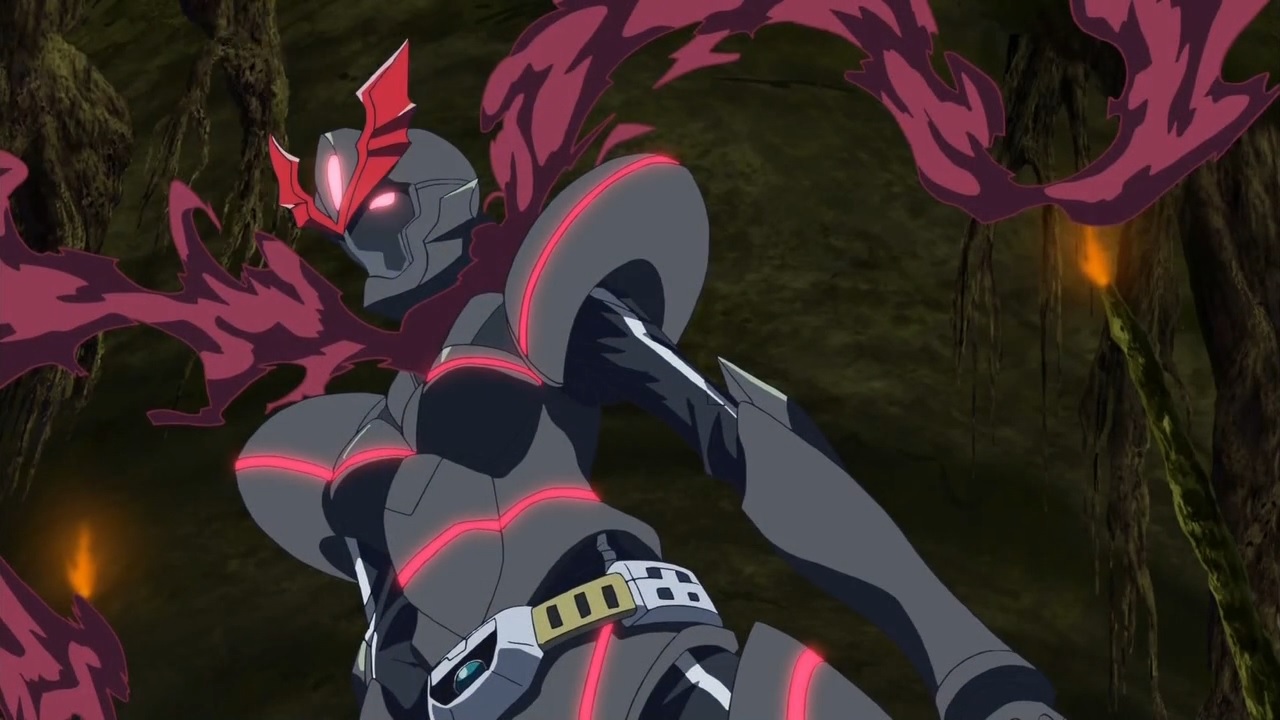
(13:05)
Nyaruko's costume is based on Knight Blazer (ナイトブレイザー) from "WILD ARMS 2nd IGNITION" (ワイルドアームズ セカンドイグニッション), a video game released by Media.Vision (メディア・ビジョン) in 1999. Image for reference:
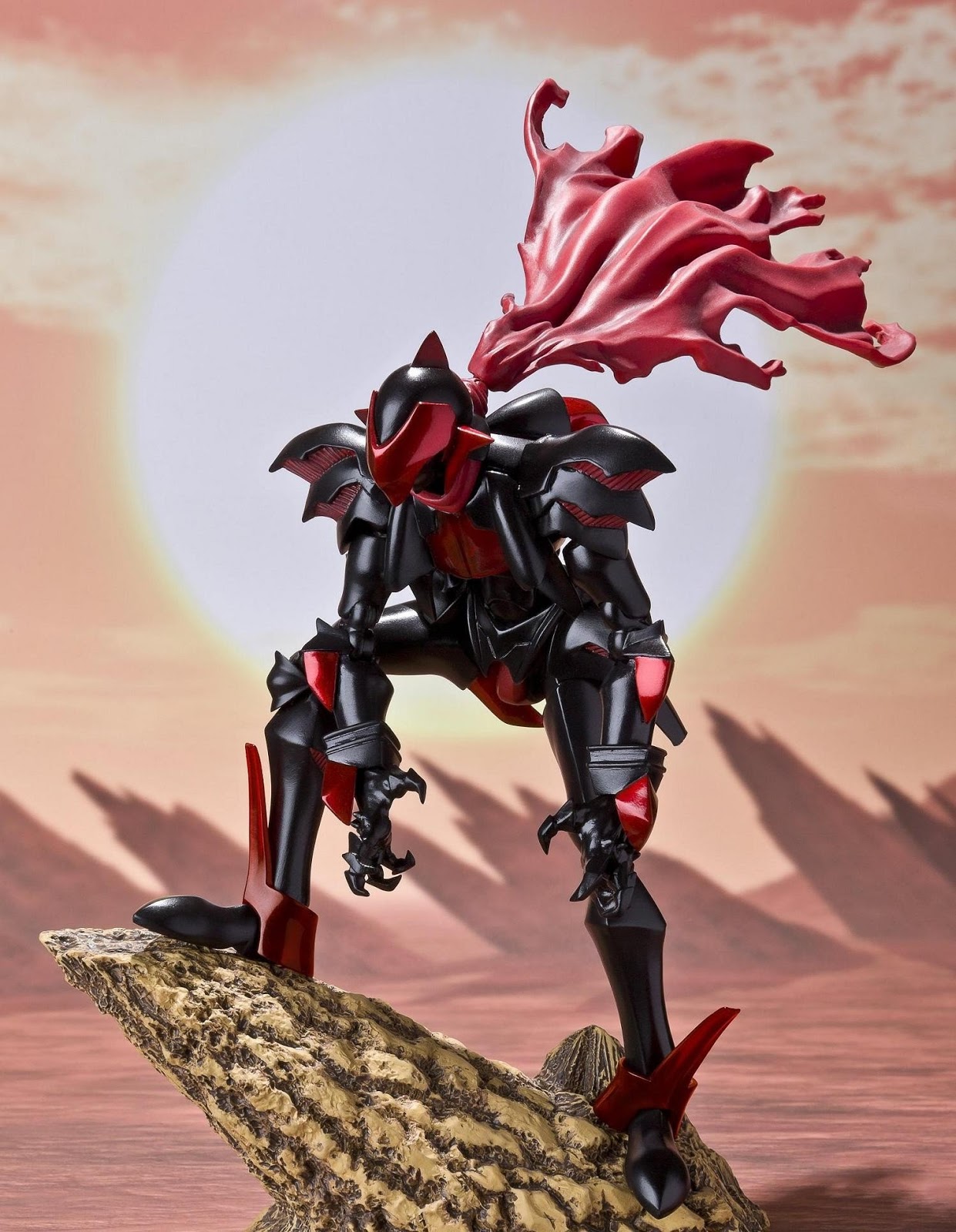
Source of image: http://www.amazon.co.jp/dp/B007T3VGTU
As stated in a tweet by Aisora Manta (逢空万太), the author of "Haiyore! Nyaruko-san",
~< `・ω・´> 何度も言ってますがニャル子のフルフォースフォームはナイトブレイザーがモチーフですからね。つまりこれよりさらに……あとは分かるな?The term "Furu Foosu Foomu" (フルフォースフォーム), "Full Force Form", is likely also referencing "WILD ARMS 2nd IGNITION" (ワイルドアームズ セカンドイグニッション). In the game, characters have a parameter called "Foosu Pointo" (フォースポイント), "Force Point", and a character can have a maximum of 100 Force Points. Certain abilities require a certain number of Force Points to use. The main character, Ashley Winchester (アシュレー・ウィンチェスター), has an ability called "Access" (アクセス) which allows him to transform into Knight Blazer at the cost of 100 Force Points.
~< `・ω・´> I've said it many times but Nyaruko's Full Force Form has Knight Blazer as the motif. Basically from this furthermore...... you get the rest right?
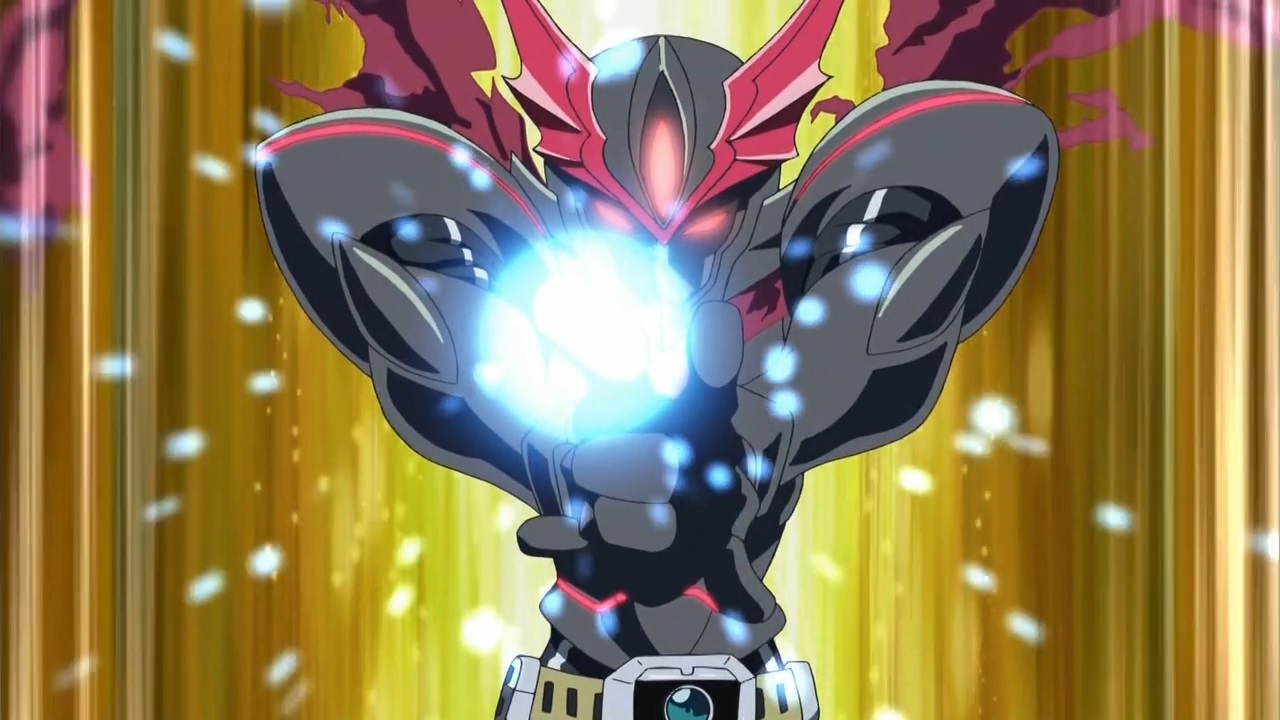
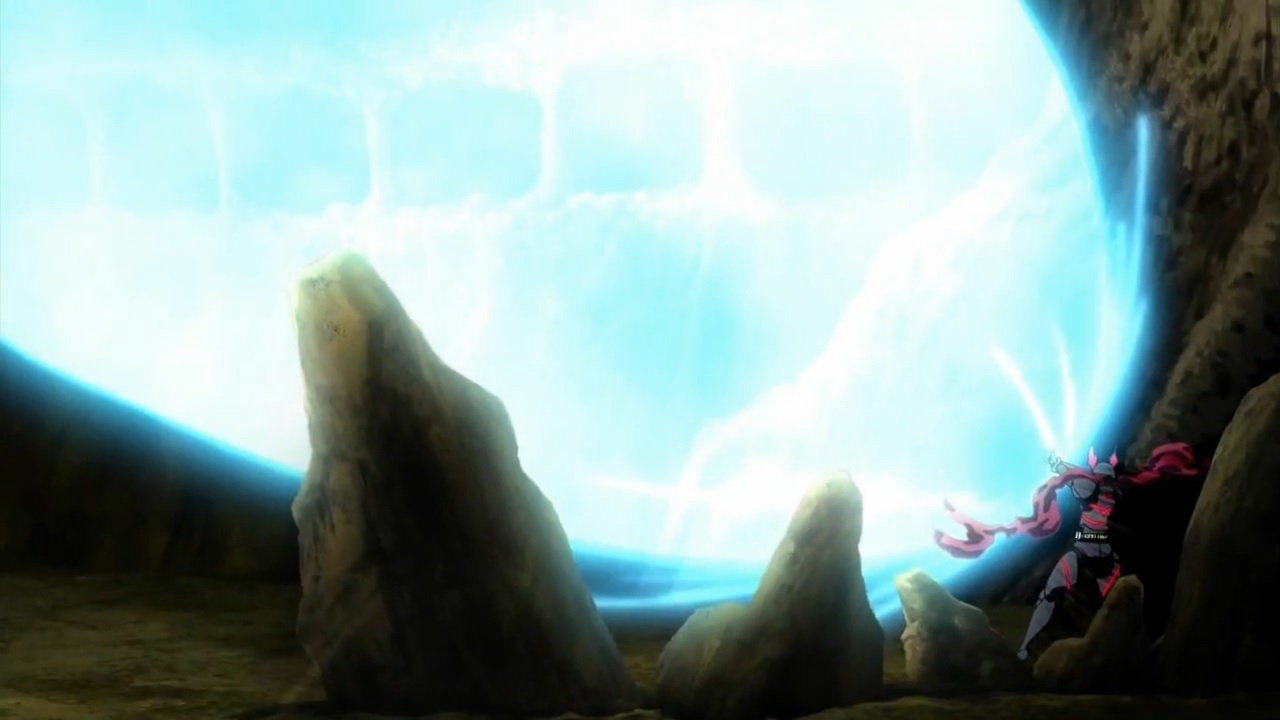
(13:44)
The attack that Nyaruko uses here is referencing an attack called "Reigan" (霊丸) used by Urameshi Yuusuke (浦飯幽助) in "Yuu Yuu Hakusho" (幽☆遊☆白書), a manga series written by Togashi Yoshihiro (冨樫義博) and published from 1990 to 1994. In the series, Yuusuke is able to shoot an energy beam from his right index finger. Image for reference:
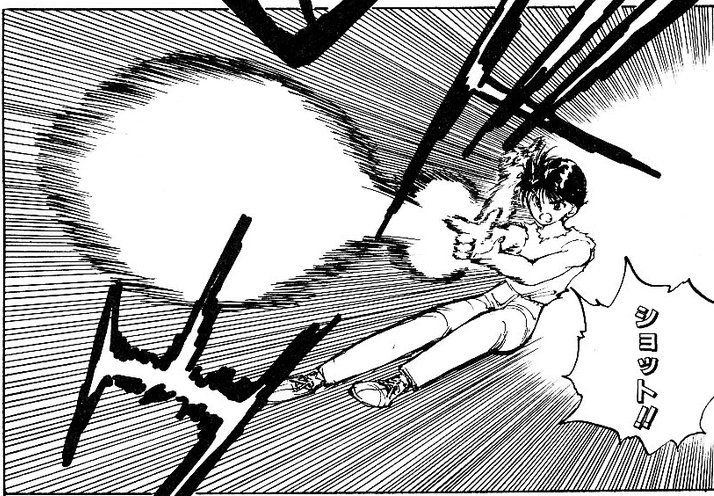
"Even if it's Alaozar, it doesn't stand a chance against a Space CQC Enhancer from point-blank range... What?!" (14:01)
"Ikura Araozaru to iedo, kono shikinkyori kara uchuu CQC enhansaa de ha hitotamari mo... Nan desu to?!" (いくらアラオザルといえど、この至近距離から宇宙CQCエンハンサーではひとたまりも・・・なんですと?!). This is referencing a line said by Tekkaman Lance (テッカマンランス) in episode 39 of "Uchuu no Kishi Tekkaman Bureedo" (宇宙の騎士テッカマンブレード), "Space Knight Tekkaman Blade", an anime series that aired from 1992 to 1993.S2 His original line goes, "Ikura shinka shita to iedo, kono shikinkyori kara no borutekkaa de ha hitotamari mo... Nani?!" (いくら進化したと言えど、この至近距離からのボルテッカーではひとたまりも・・・なに!?), which translates to, "No matter how much you evolved, you don't stand a chance against my Voltekka at point-blank range... What?!"
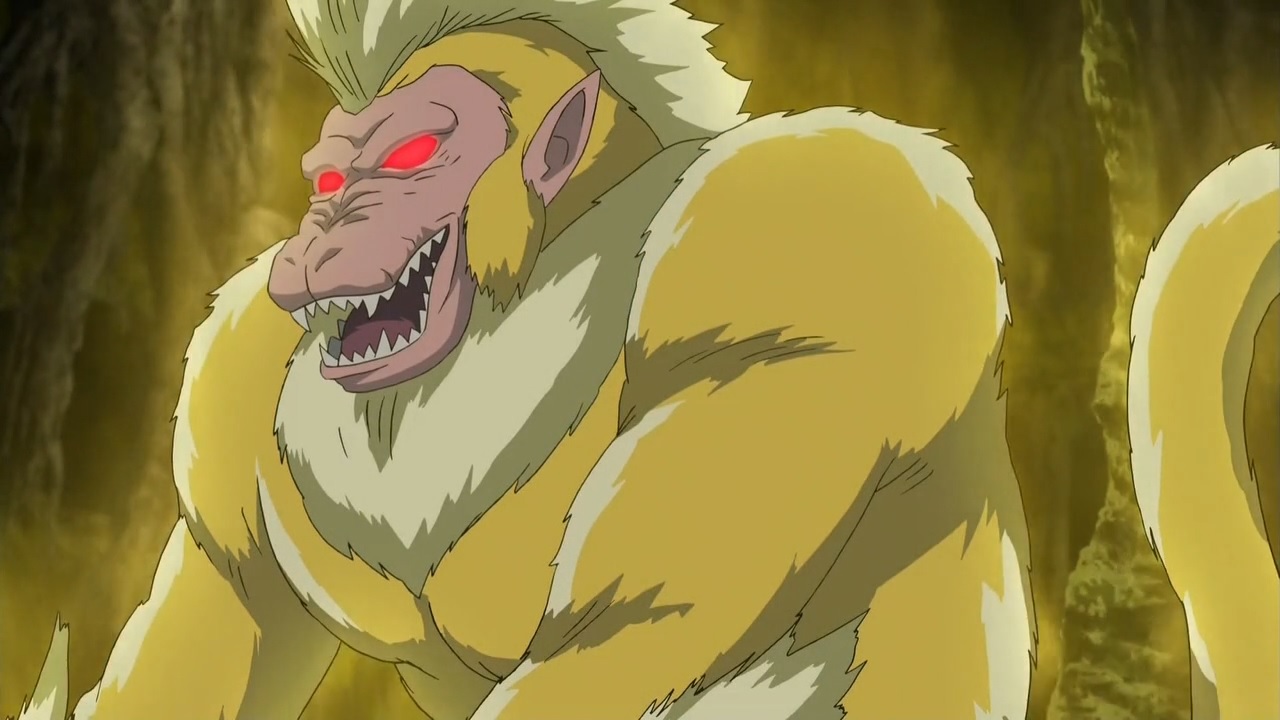
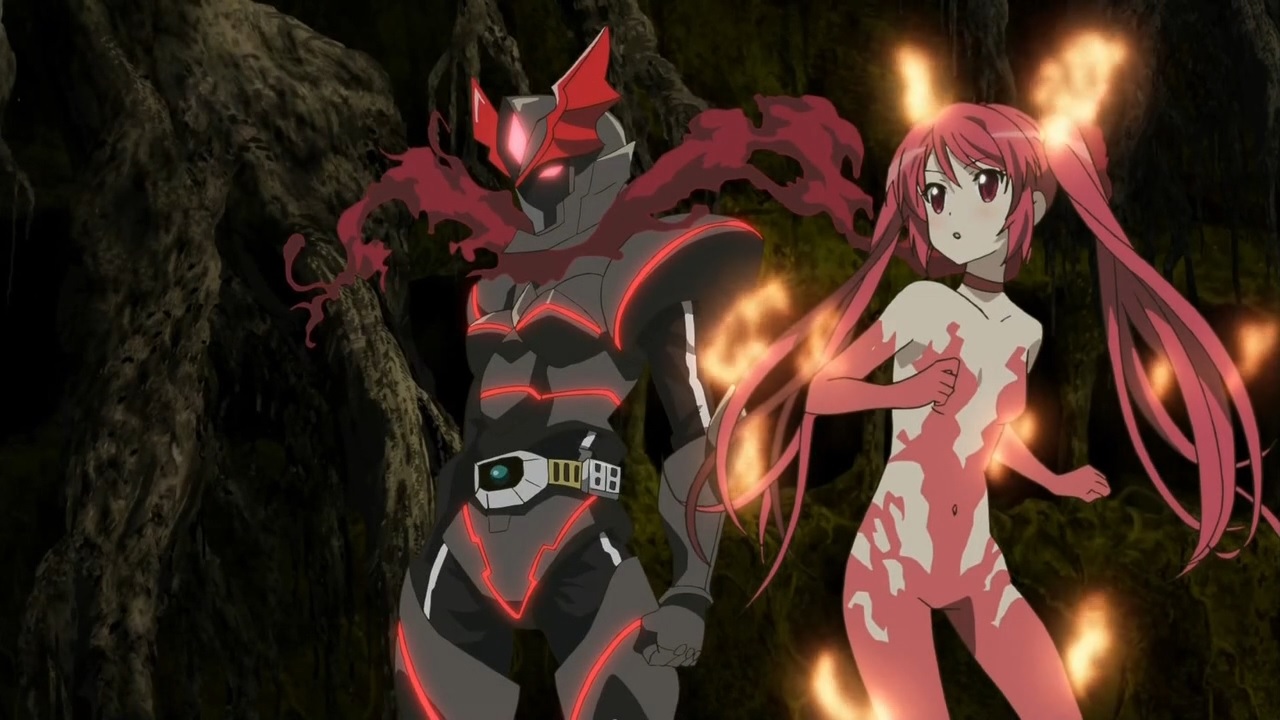
(14:13)
"Rage mode?" (14:15)
There are two references here:
* Alaozar's fur turns yellow colored and Cthuko says, "Ikari moodo?" (怒りモード?). This is referencing "Monster Hunter" (モンスターハンター), a series of video games released by CAPCOM (カプコン) starting from 2004. A recurring mechanic in the series is that monsters can enter "ikari joutai" (怒り状態), "state of rage", under certain conditions, and monsters become more powerful when in this state. In particular, when one of the monsters that appears in the series, Raajan (ラージャン), goes into its state of rage, parts of its fur turns yellow colored.S1 Video for reference: https://youtu.be/uFRBG_0GkTY?t=494
* Alaozar in this state greatly resembles Ougon Oozaru (黄金大猿), "Golden Giant Monkey", from "Dragon Ball GT" (ドラゴンボールGT), an anime series that aired from 1996 to 1997. In the series, under certain conditions a member of the Saiyan race can transform into a giant money with yellow fur called Ougon Oozaru. This form is much more powerful than the previously mentioned Oozaru. Image for reference:
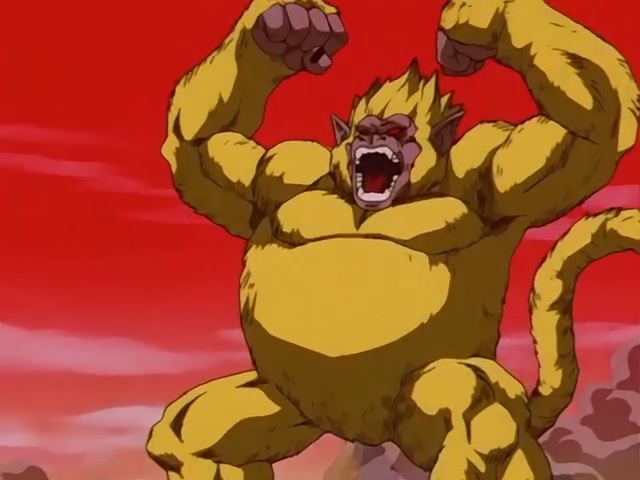
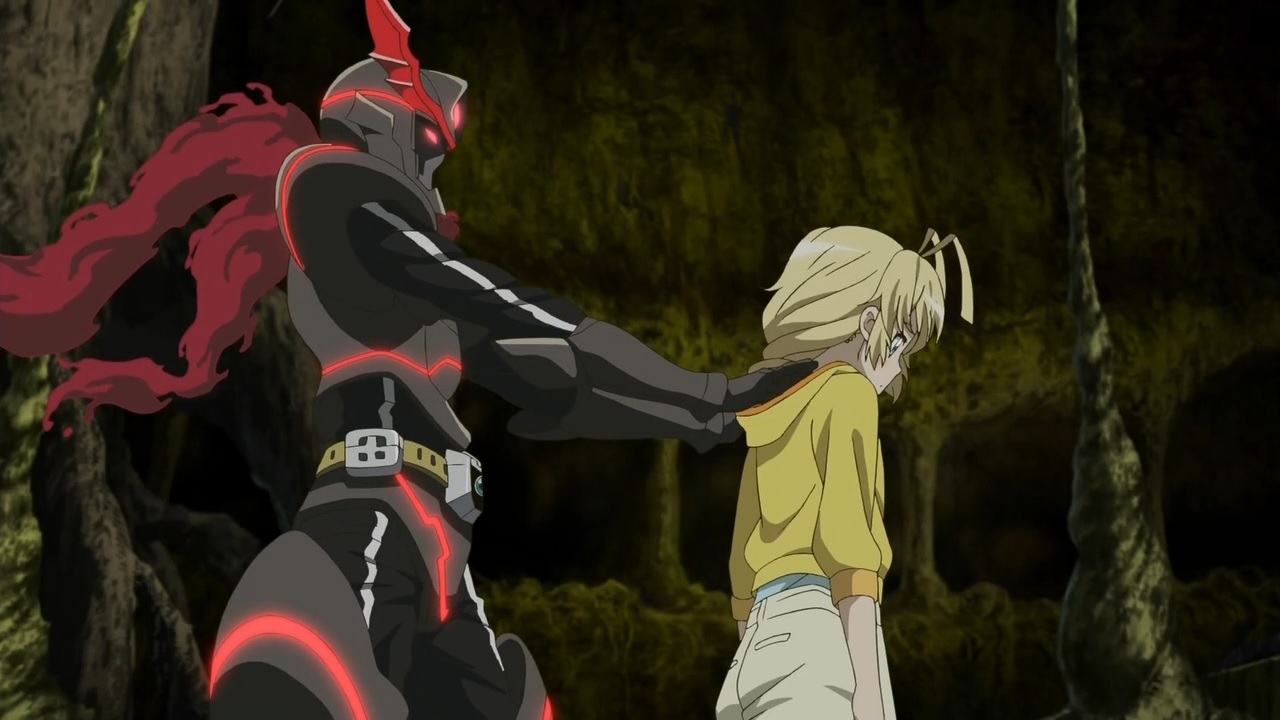
"This will tickle a little. Don't worry, the pain only lasts an instant." (15:23)
The Japanese line is "Chotto kusuguttai desu yo. Nani, itami ha isshun desu" (ちょっとくすぐったいですよ。なに、痛みは一瞬です). This is a repeat of a reference in episode 3 of season 1 at 18:47. This line consists of two parts that reference Kamen Rider Decade (仮面ライダーディケイド) and Kamen Rider Diend (仮面ライダーディエンド) from "Kamen Rider Decade" (仮面ライダーディケイド), a Japanese TV show about a masked super hero that aired in 2009. Both characters can use an ability called "FINAL FORMRIDE" that allows them to transform their allies into alternate forms, such as tools or weapons. The first part of Nyaruko's line is "Chotto kusuguttai desu yo" (ちょっとくすぐったいですよ), which translates to "This will tickle a little". This is referencing what Kamen Rider Decade says when he uses "FINAL FORMRIDE". Decade's line goes, "Chotto kusuguttai zo" (ちょっとくすぐったいぞ), which has the same meaning. The second part is "Nani, itami ha isshun desu" (なに、痛みは一瞬です), which translates to "Don't worry, the pain only lasts an instant". This is referencing what Diend says when he uses "FINAL FORMRIDE". Diend's line goes, "Itami ha isshun da" (痛みは一瞬だ), which translates to "The pain only lasts an instant". In addition, the pose that Nyaruko is doing is referencing the pose Kamen Rider Decade does when he uses "FINAL FORMRIDE". He reaches into his ally's back to activate the ability. Image for reference:
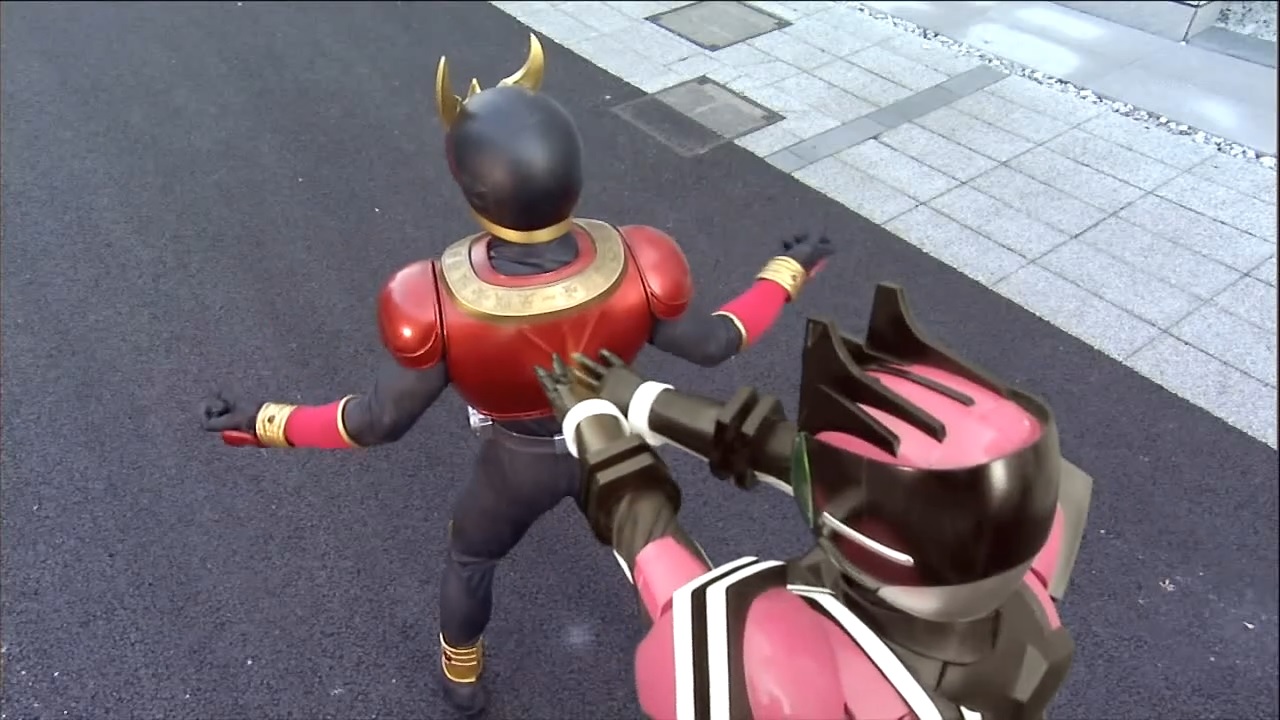
"This violent and stimulating effect" (15:35)
The Japanese line is "Kono hageshime no shigeki teki efekuto" (この激しめの刺激的エフェクト). This is referencing lines in the lyrics to "Cyclone Effect", a song sung by Labor Day and released in 2009.S2 This song is a background song used in "Kamen Rider W" (仮面ライダーW). The original lines go as follows:
「刺激的Effect」
「激しめのEffect」
"Shigeki teki Effect"
"Hageshime no Effect"
"A stimulating Effect"
"A violent Effect"
"Damn you, Cthuko!" (16:06)
The Japanese line is "Onore Kuuko!" (おのれクー子!). This is referencing a line often said by Narutaki (鳴滝) in "Kamen Rider Decade" (仮面ライダーディケイド), a Japanese TV show about a masked super hero that aired in 2009.S4 The original line is "Onore Dikeido!" (おのれディケイド!), which translates to "Damn you, Decade!".
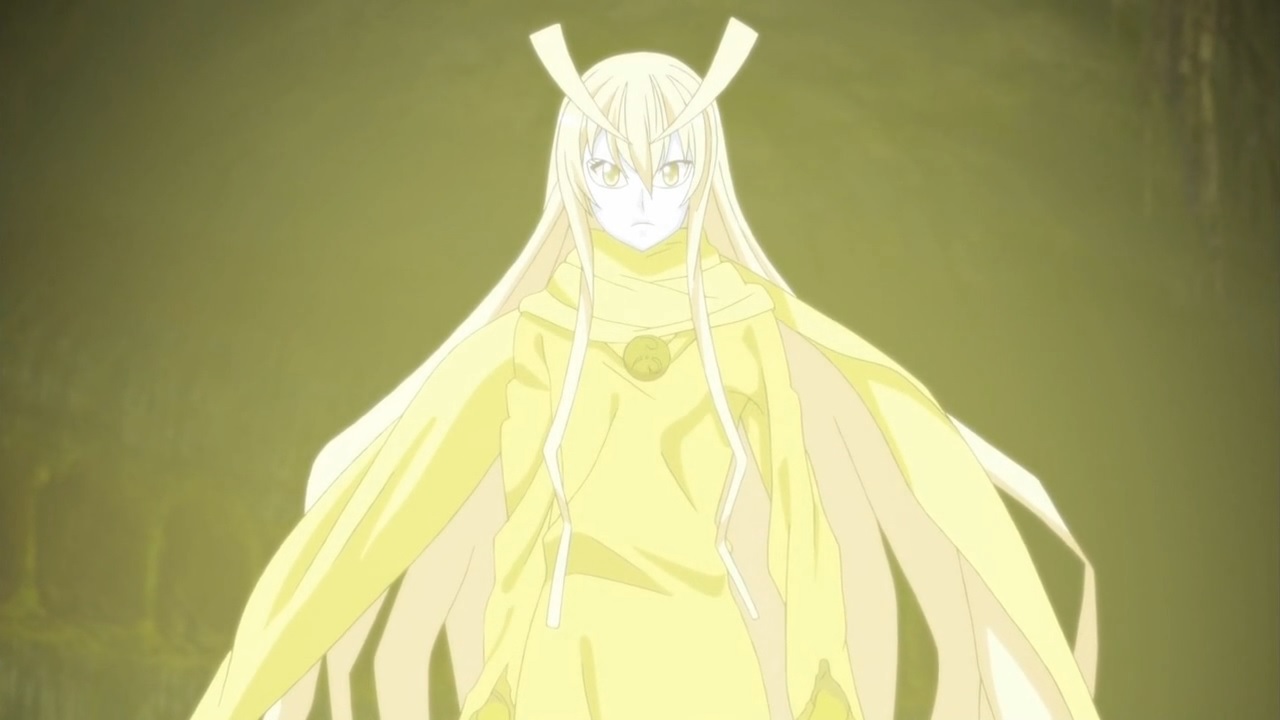
(16:30)
Hasta's appearance here is referencing that of the King in Yellow, an avatar of Hastur that is described as wearing tattered yellow robes and a white mask.


"I decree my judgement as king. It's death!" (16:32)
The Japanese line is "Ou no hanketsu wo iiwatasu. Shi da!" (王の判決を言い渡す。死だ!). This is the pre-battle catch phrase of Kamen Rider Saga (仮面ライダーサガ) from "Kamen Rider Kiva" (仮面ライダーキバ), a Japanese TV show about a masked super hero that aired from 2008 to 2009.S1 In addition, Hasta's poses are referencing those of Kamen Rider Saga when he says this line. Images for reference:
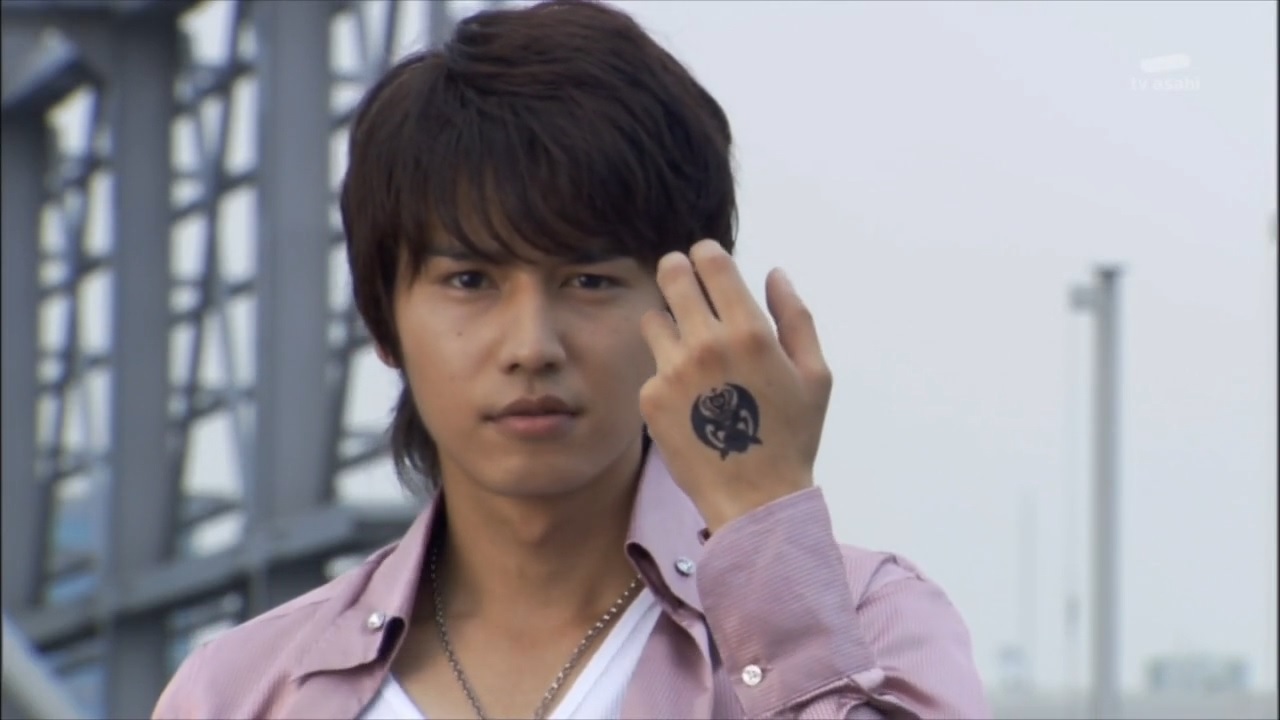
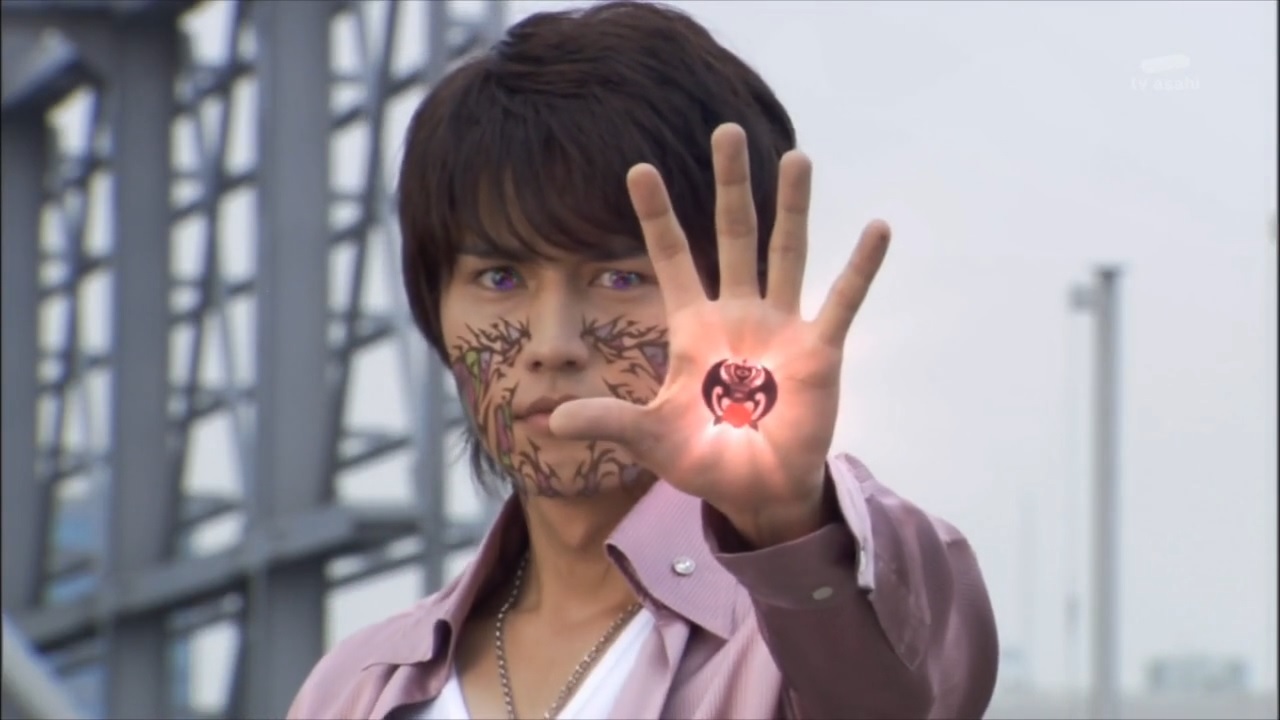
Kamen Rider Saga is the King of the Fangire, a species of vampire-like creature in "Kamen Rider Kiva". Kamen Rider Saga's catch phrase and title of King are referencing how Hastur is known as the King in Yellow in the Cthulhu Mythos.
* On a related note, the voice actor of Hasta's alternate form is Seki Tomokazu (関智一). Seki also voices Gilgamesh (ギルガメッシュ) in "Fate/stay night" (フェイト/ステイナイト), a visual novel released by TYPE-MOON in 2004.S1 In the series, Gilgamesh is the King of Uruk and wears gold-colored armor. Similarly, Seki also voices Black Gilgamesh (黒ギルガメス) in "Doruaaga no Tou" (ドルアーガの塔), "The Tower of Druaga", an anime series that aired from 2008 to 2009.S1 The series aired in two parts, one in 2008 and one in 2009. In the second part, titled "The Tower of Druaga: the Sword of Uruk (ドルアーガの塔 ~the Sword of URUK~)", Black Gilgamesh is the dark side of King Gilgamesh, the King of Uruk. Both Black Gilgamesh and King Gilgamesh wear yellow-colored armor.
"Hasta's Cyclone Effect made it in time." (16:47)
"Saikuron Efekuto" (サイクロン エフェクト), "Cyclone Effect", is the title of a background song used in "Kamen Rider W" (仮面ライダーW).S1
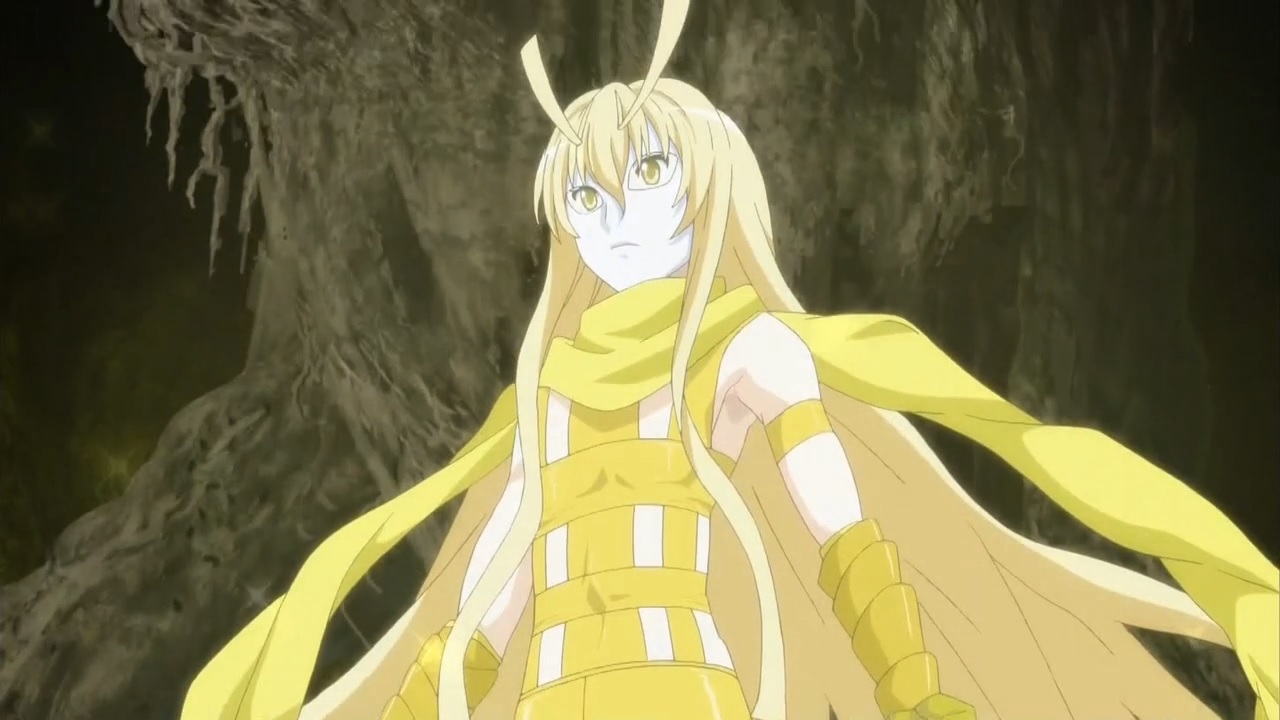
(17:53)
Hasta's outfit in this scene is referencing Nishikawa Takanori (西川貴教), a Japanese singer and actor.S2 Takanori is also known by the name T.M.Revolution. In 1998, T.M.Revolution released a CD single titled "HOT LIMIT". Hasta's outfit is referncing the outfit worn by Takanori on the jacket cover of "HOT LIMIT". Image for reference:
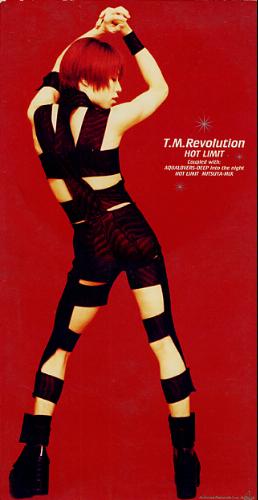
Source of image: http://www.amazon.co.jp/dp/B00005G37S
Takanori also wears this outfit in the music video for "HOT LIMIT", the first song on the "HOT LIMIT" CD single. Image for reference:
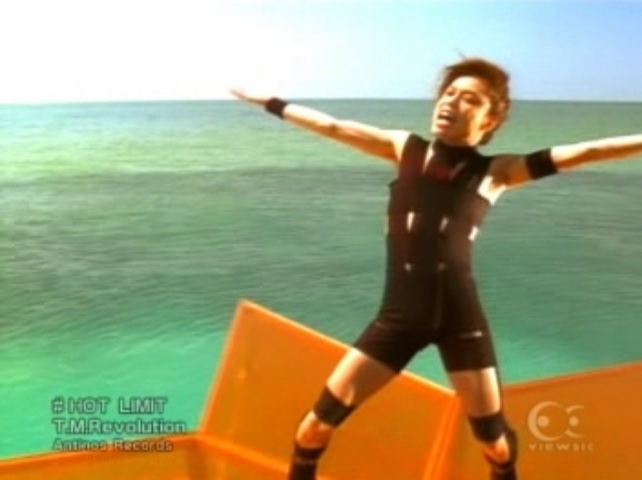
Hasta wearing this outfit is likely because Hasta has wind based abilities, which relates to how this music video features Takanori singing in windy conditions.
"Space CQC, A to Z!" (18:05)
"Ee Tuu Zetto" (エートゥーゼット), "A to Z", is referencing "Kamen Raidaa W FOREVER A to Z / Unmei no Gaia Memori" (仮面ライダーW FOREVER AtoZ/運命のガイアメモリ), "Kamen Rider W FOREVER A to Z / The Gaia Memories of Fate", a movie released in 2010.

"One-in-all, all-in-one, Triplet Maximum!" (18:09)
The Japanese line is "Ichi ni shite zen, zen ni shite ichi naru, Toripuretto Makishimamu!" (一にして全、全にして一なる、トリプレットマキシマム!). There are three references here:
* This is referencing Yog-Sothoth, a god classified as an Outer God in the Cthulhu Mythos.S3 In "Through the Gates of the Silver Key", a short story written by H. P. Lovecraft and E. Hoffmann Price and first published in 1934, Yog-Sothoth is described as, "an All-in-One and One-in-All of limitless being and self". In Japanese it is translated as "Zen ni shite ichi, ichi ni shite zen naru mono" (全にして一、一にして全なる者).
* Nyaruko, Cthuko, and Hasta combine to form a beam of rainbow-colored light. This is also referencing to Yog-Sothoth, who is described as a collection of rainbow-colored spheres in the Cthulhu Mythos.S3 In "The Lurker at the Threshold", a novel written by August Derleth and first published in 1945, Yog-Sothoth is described as "a congeries of iridescent globes".
* "Triplet Maximum" is referencing Kamen Rider W from "Kamen Rider W" (仮面ライダーW). Each of his finishing attacks is called "Maximum Drive" (マキシマムドライブ). In addition, Kamen Rider W is able to perform an attack called "Twin Maximum" (ツインマキシマム), a more powerful Maximum Drive.
"Add one, add two, subtract one, subtract two, the power of three, a single heart." (18:40)
The Japanese line is "Ichi tasu, ni tasu, ichi hiku, ni hiku, mitsu no chikara, hitotsu no kokoro" (一たす、二たす、一ひく、二ひく、三つの力、一つの心). This is referencing lines in the lyrics to "Ichi Tasu Ni Tasu San Barukan" (1たす2たすサンバルカン), "Add 1 Add 2 Sun Vulcan", a song performed by Kushida Akira (串田アキラ) and Otowa Yurikago Kai (音羽ゆりかご会) and released in 1981. This song is the second ending theme song to "Taiyou Sentai San Barukan" (太陽戦隊サンバルカン), "Sun Squadron Sun Vulcan", a Japanese TV show about a squadron of costumed super heroes that aired from 1981 to 1982.S2 The original lines go as follows:
「1たす2たす 1たす2たす サンバルカン」
「三つの力 ひとつの心」
"Ichi tasu ni tasu ichi tasu ni tasu San Barukan"
"Mitsu no chikara hitotsu no kokoro"
"Add one add two add one add two Sun Vulcan"
"The power of three, a single heart"
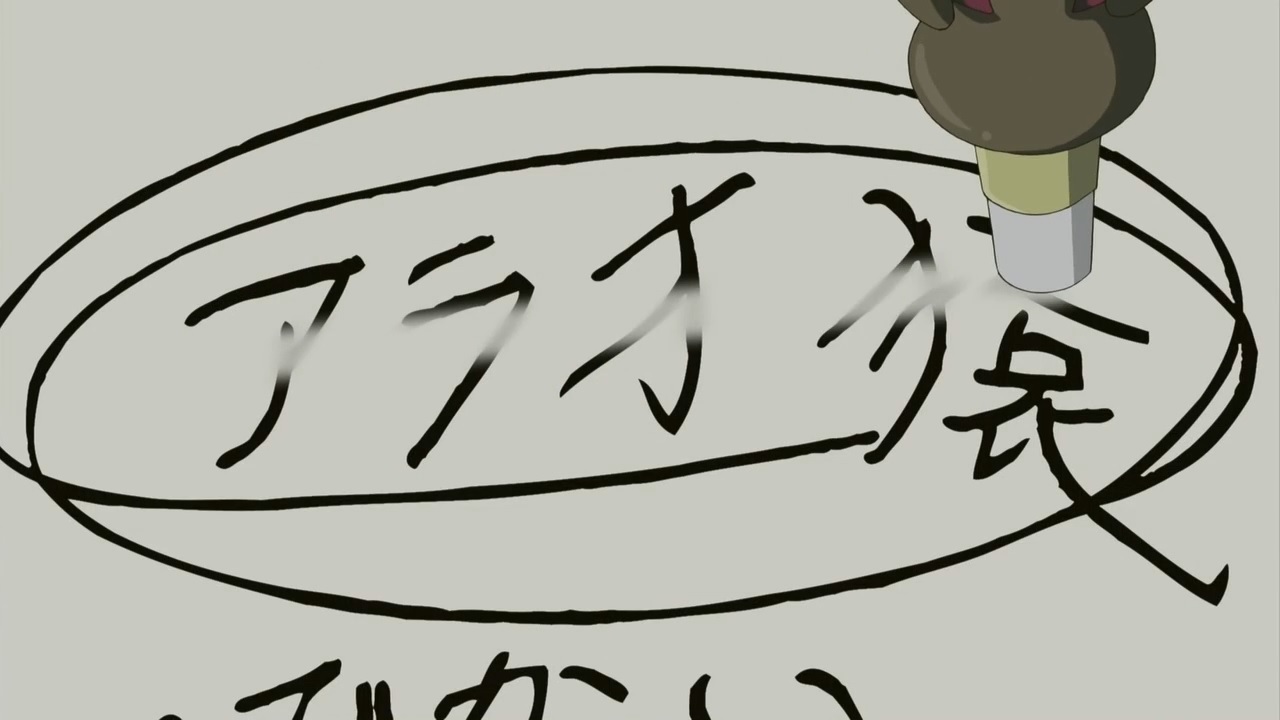
(19:47)
Mahiro uses an eraser to erase the writing in the book and undo the creation of Alaozar. This is also referencing "WING-MAN" (ウィングマン).S2 In the series there exists an eraser called "Dorimu Ireisaa" (ドリムイレイサー), "Dream Eraser". The Dream Eraser is able to erase writing in the Dream Notebook and undo whatever was written. In volume 4 of the series, one of the antagonists, Kitakura Shunichi (北倉俊一), uses the Dream Eraser to erase Hirono Kenta's ability to change into Wing-Man from the Dream Notebook. Image for reference:
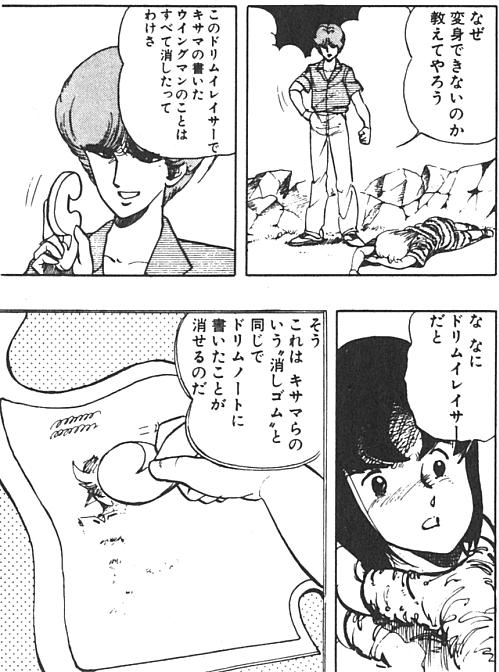
"Later today we will once again ride a meteor and go on a rocketing interstellar flight!" (22:24)
The Japanese line is "Kyou mo kore kara watashi tachi ha ryuusei ni matagatte kyuujoushou no seikan hikou ni!" (今日もこれから私たちは流星にまたがって急上昇の星間飛行に!). This is referencing "Seikan Hikou" (星間飛行), "Interstellar Flight", a song sung by Nakajima Megumi (中島愛) and released in 2008.S2 This song is a theme song used in "Macross Frontier" (マクロスF), an anime series that aired in 2008. In addition, Nyaruko's line is also referencing a line from the lyrics to this song. The line goes, "Ryuusei ni matagatte anata ha kyuujoushou" (流星にまたがって あなたは急上昇), which translates to, "Riding on a meteor, you go rocketing".
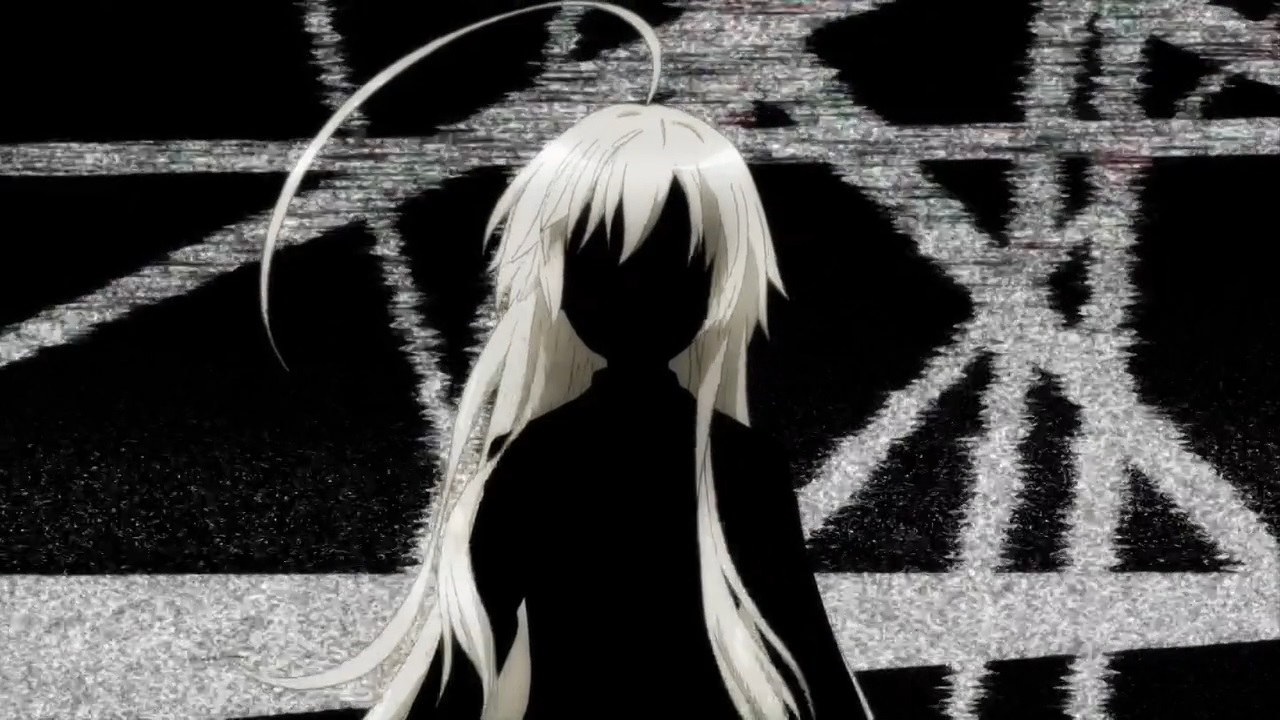
(22:40)
Nyaruko appears here without her face. This is referencing how Nyarlathotep is referred to as "the mad faceless god" in "The Rats in the Walls", a short story written by H. P. Lovecraft and first published in 1924. In addition, an avatar of Nyarlathotep known as "The Faceless God" appears in "The Faceless God", a short story written by Robert Bloch and first published in 1936.S3
"Three events that occur next time! First!" (24:11)
The Japanese line is "Jikai no mitsu no dekigoto! Hitotsu!" (次回の三つの出来事!一つ!). This is referencing a line from "Kamen Rider OOO" (仮面ライダーオーズ), a Japanese TV show about a masked super hero that aired from 2010 to 2011.S1 At the beginning of each episode there is an opening sequence that summarizes the events of the previous episode, and a line from this sequence goes, "Zenkai no mitsu no dekigoto! Hitotsu!" (前回の三つの出来事!一つ!), which translates to "Three events that occurred last time! First!".
"The remaining two are just for decoration. The higher-ups" (24:17)
The Japanese line is "Nokori futatsu nante kazari desu. Erai hito ha" (残り二つなんて飾りです。偉い人には). This is referencing a line said by a Zeon soldier in episode 42 of "Mobile Suit Gundam" (機動戦士ガンダム), an anime series that aired from 1979 to 1980.S1 His line goes, "Anna no kazari desu. Erai hito ni ha sore ga wakaran no desu yo" (あんなの飾りです。偉い人にはそれがわからんのですよ), which translates to, "Those are just for decoration. The higher-ups don't understand that." The soldier says this to Char when he is explaining why the Zeong mobile suit is able to function at 100% capacity in spite of not having legs attached.
"It'll be super interesting and cool!" (24:22)
Nyaruko was about to say "Chou omoshiro kakkoi ze!" (超おもしろカッコいいぜ!). This is referencing a line from the next episode preview for "Mashin Eiyuuden Wataru 2" (魔神英雄伝ワタル2), "Mashin Hero Wataru 2", an anime series that aired from 1990 to 1991. The original line is "Hakkishi itte, chou omoshiro kakkoi ze!" (ハッキシ言って、超おもしろカッコいいぜ!), which translates to, "To put it clearly, it'll be super interesting and cool!". Video for reference: http://www.nicovideo.jp/watch/sm18712795
List of Sources:
S1. Comments on this post
S2. A post at Steman Blog (ステマブログ)
S3. A blog by servitors about Cthulhu Mythos inspired works (クトゥルー/クトゥルフ神話作品発掘記)
S4. Japanese Nyaruko References Wiki (這いよれ! ニャル子さん 元ネタwiki)
Thanks to everyone who contributed! This list wouldn't be nearly as long without you all. See you next episode!
情報を教えてくださって本当にありがとうございました!皆さんがいなかったら、このリストはぜんぜん長くありません。またこの次までね!
Last updated March 1, 2022
Sitemap
Home